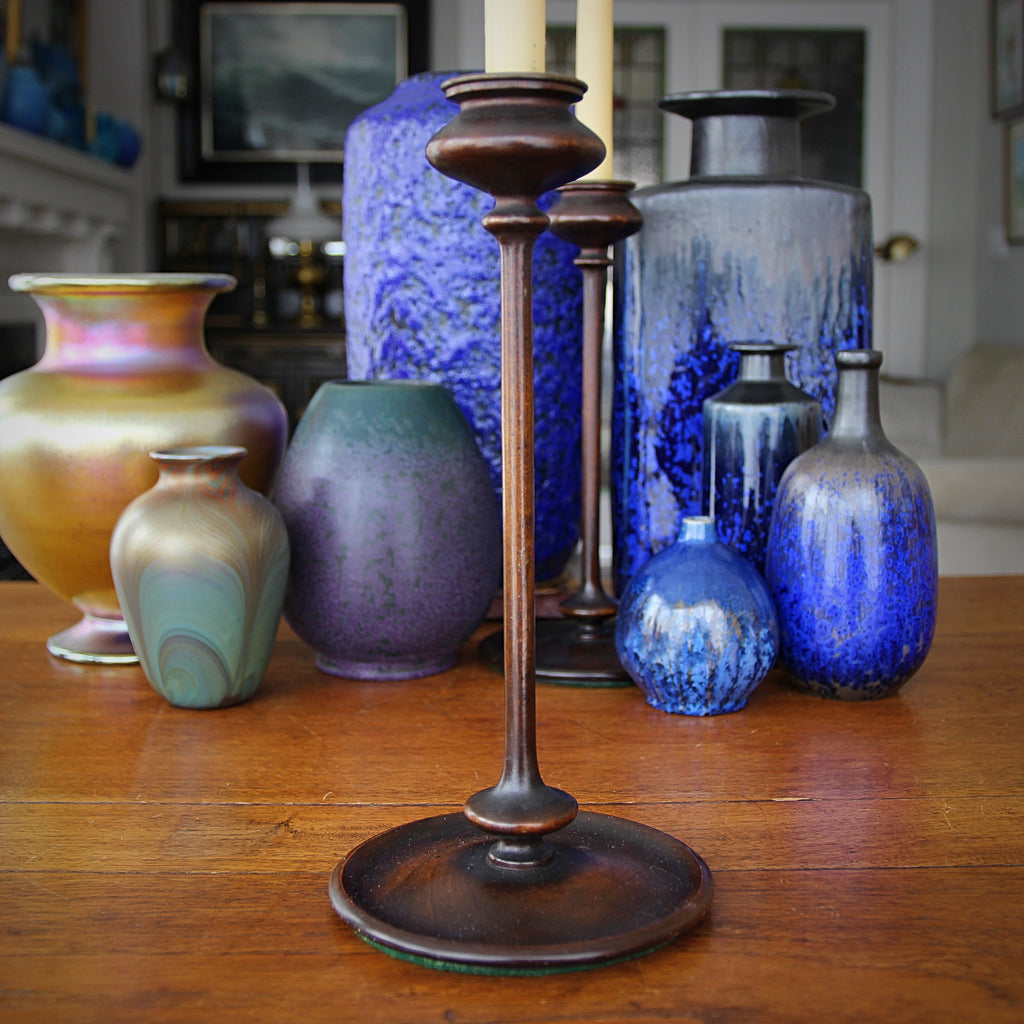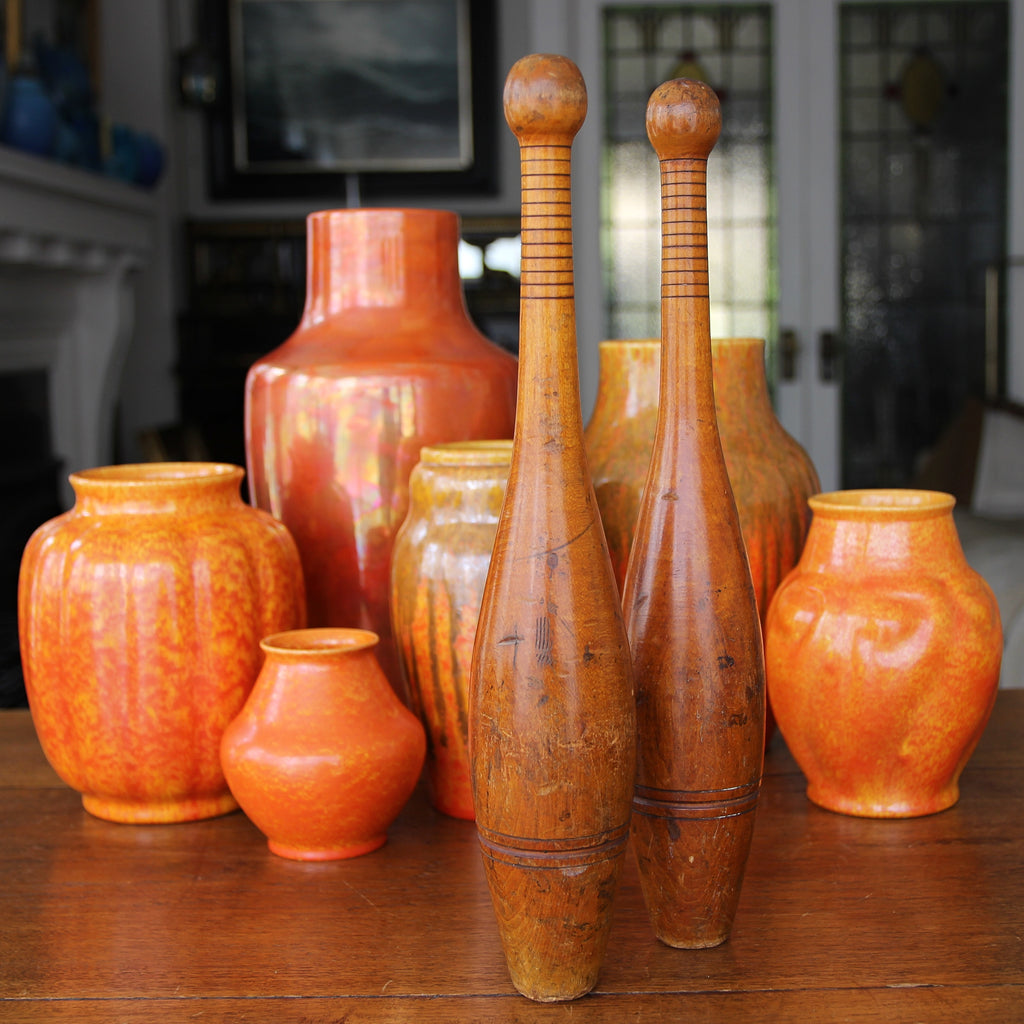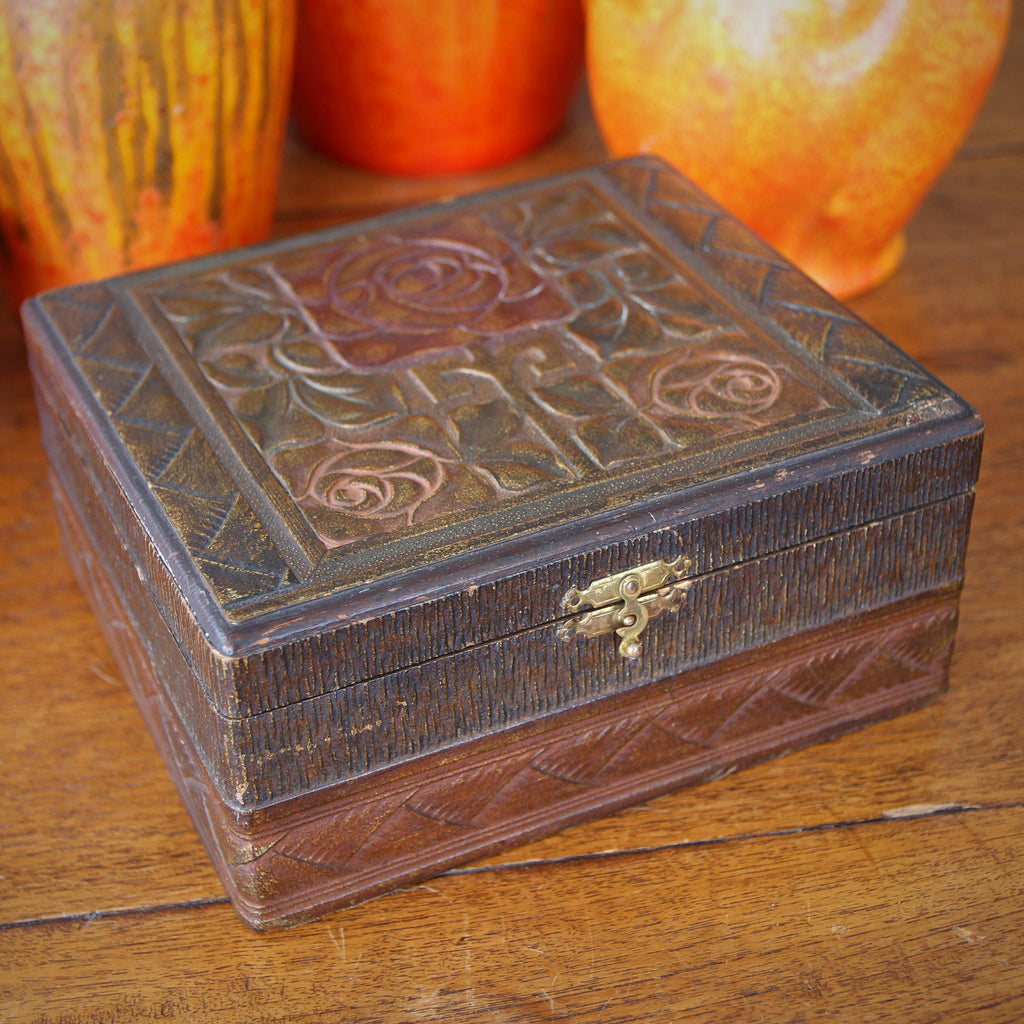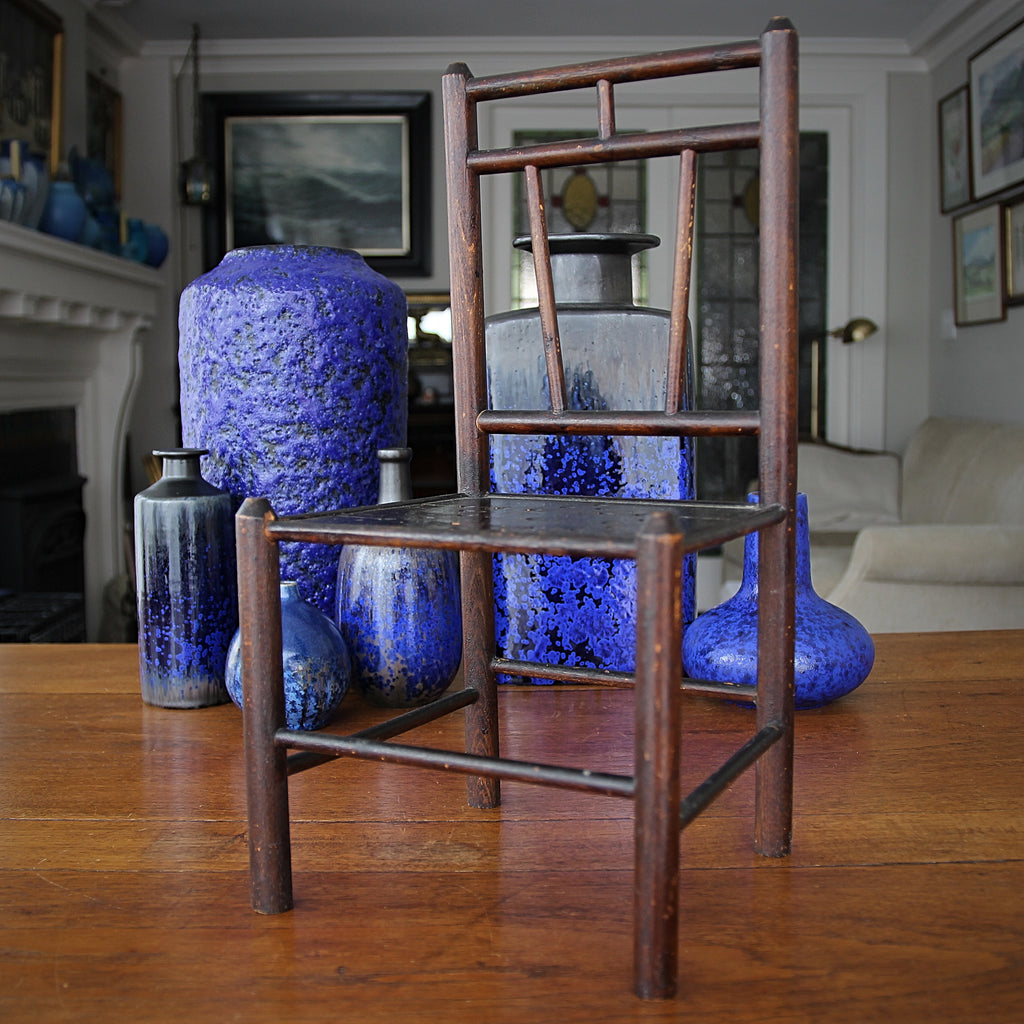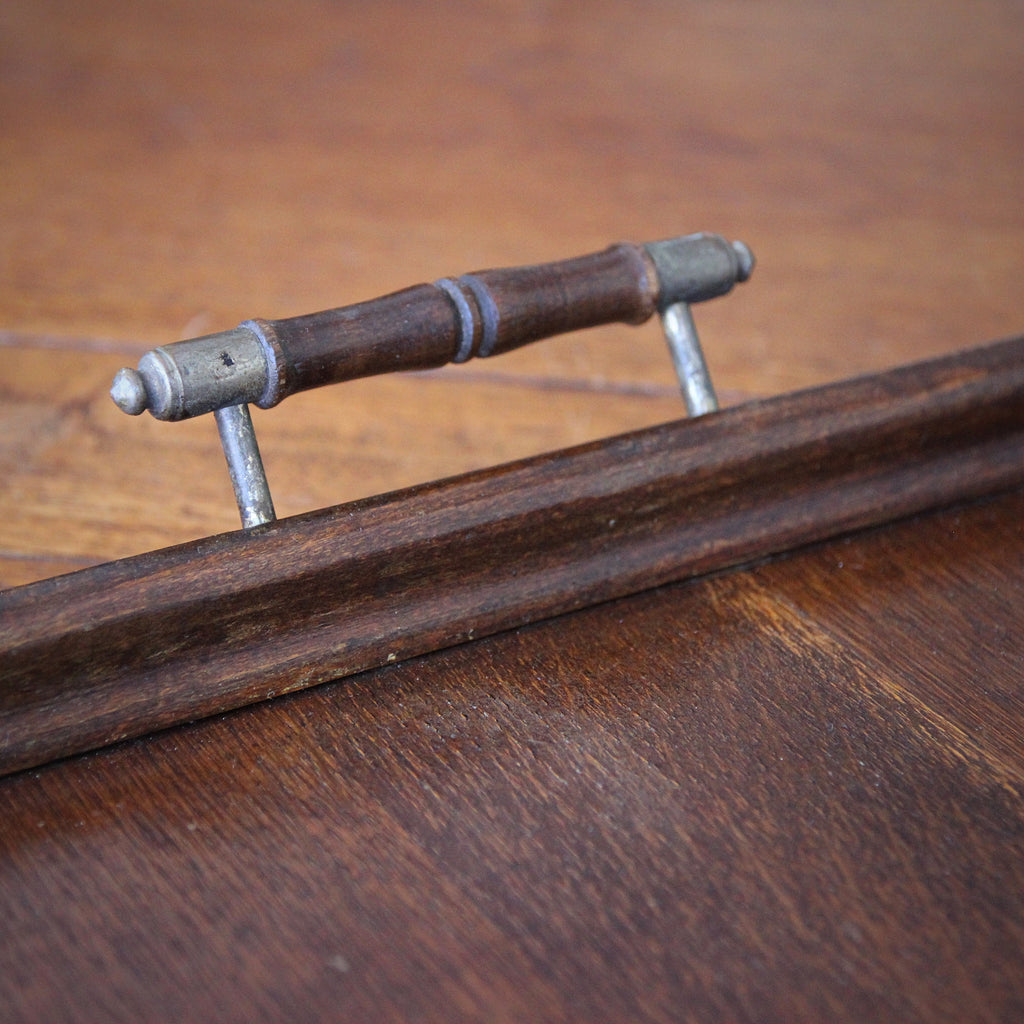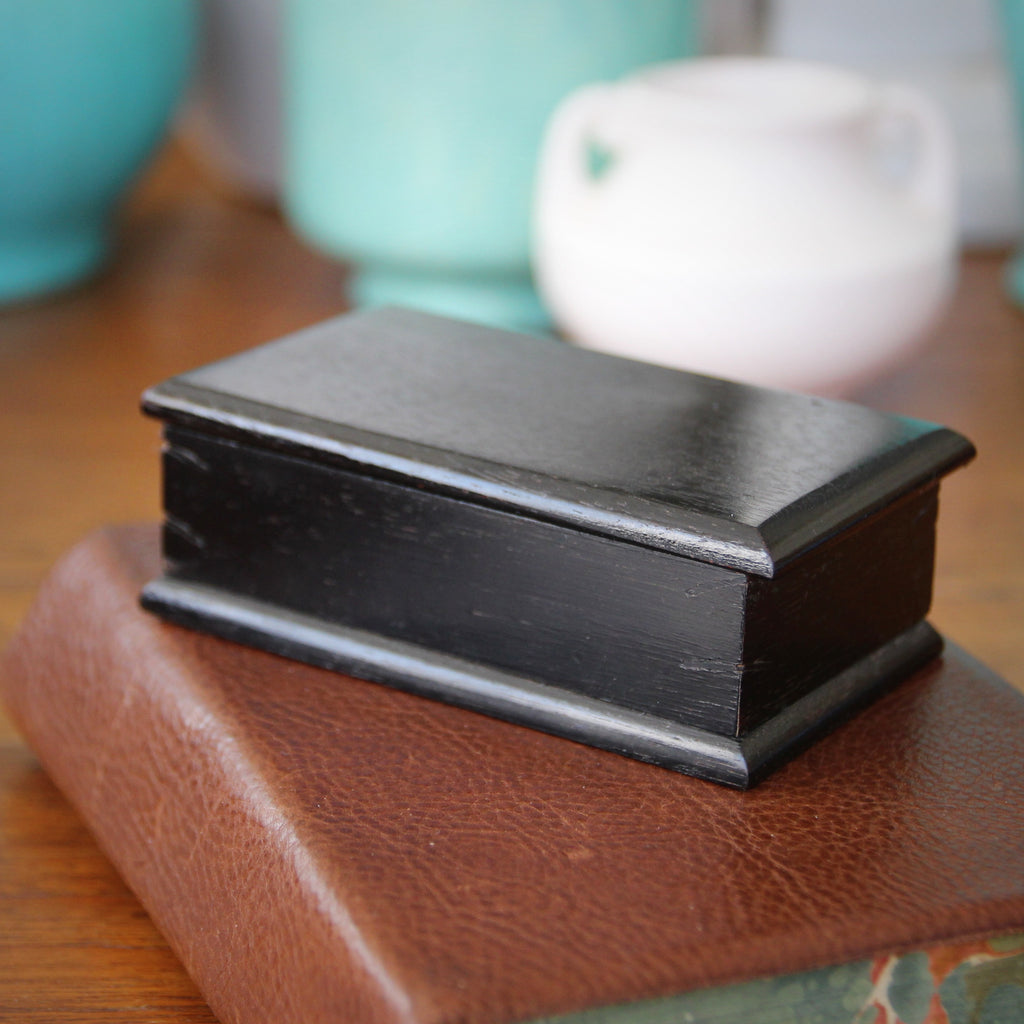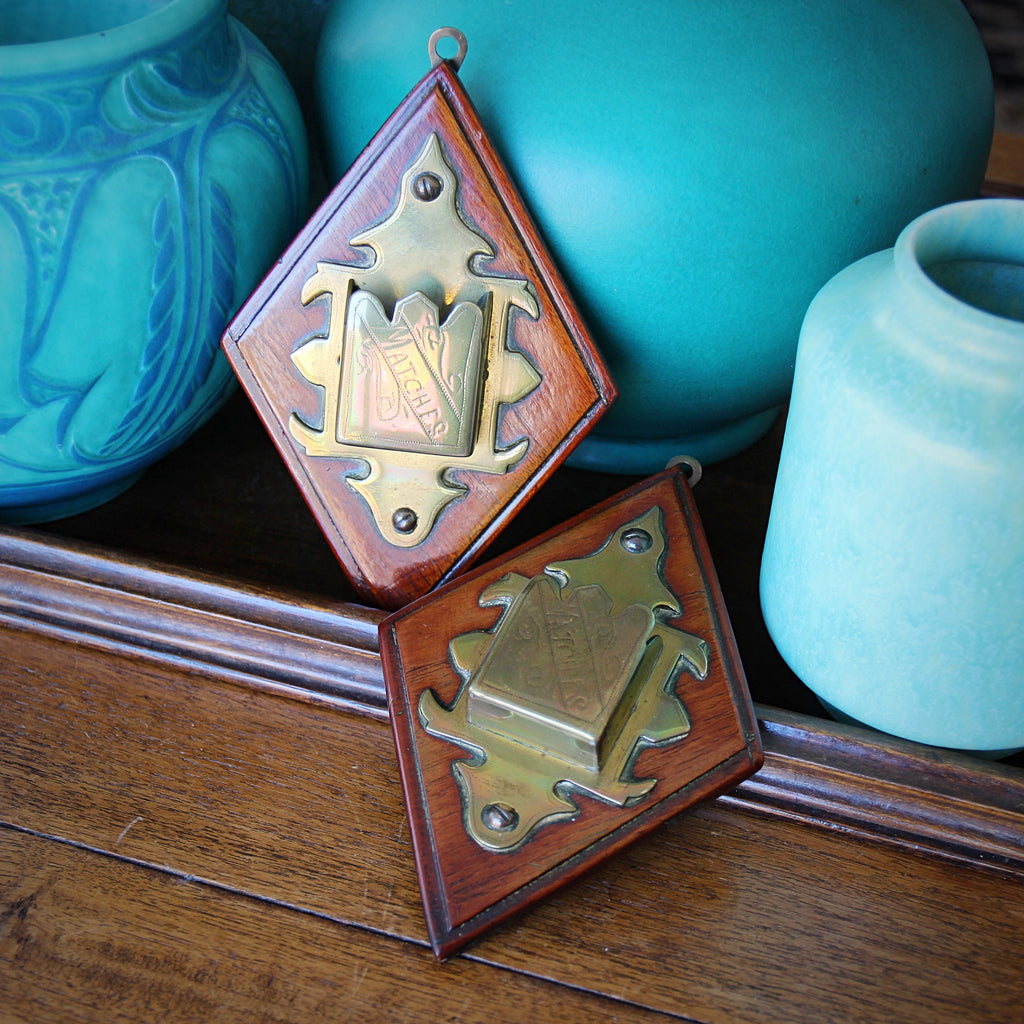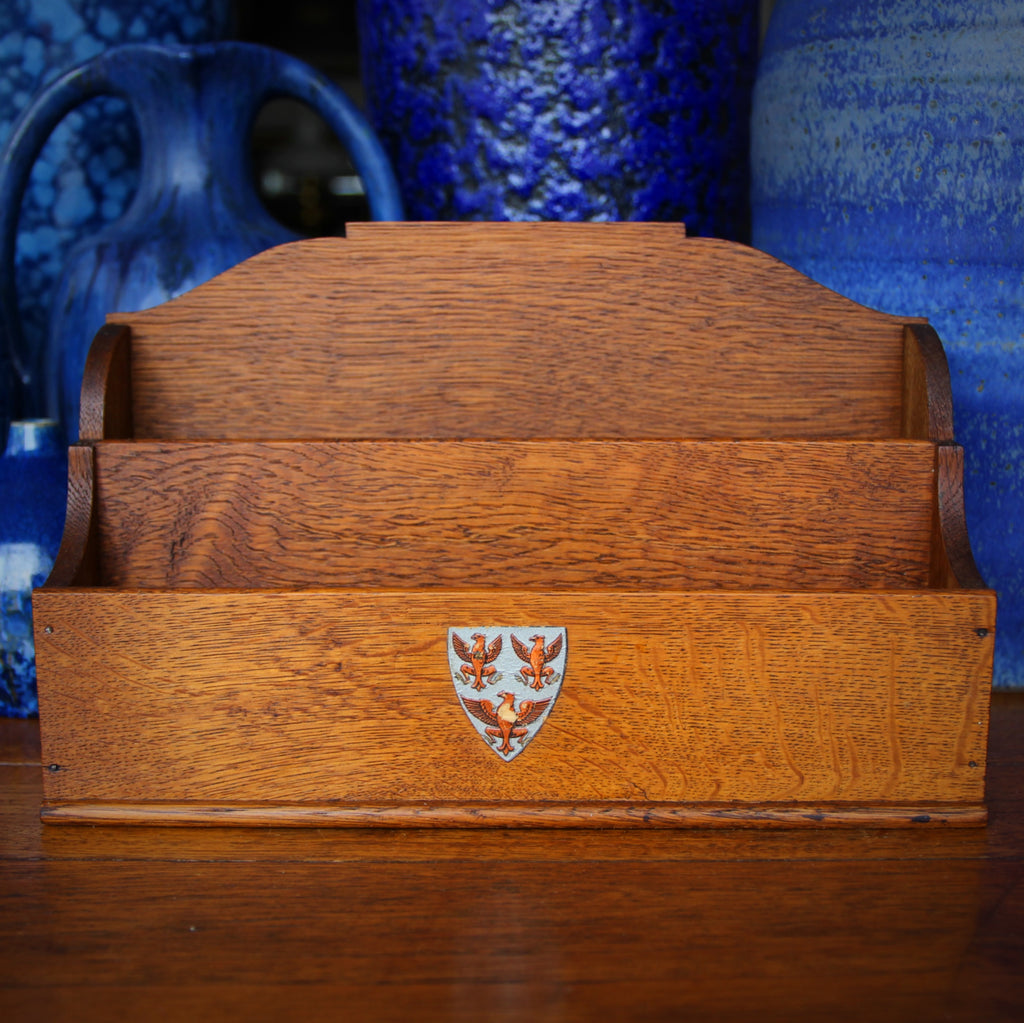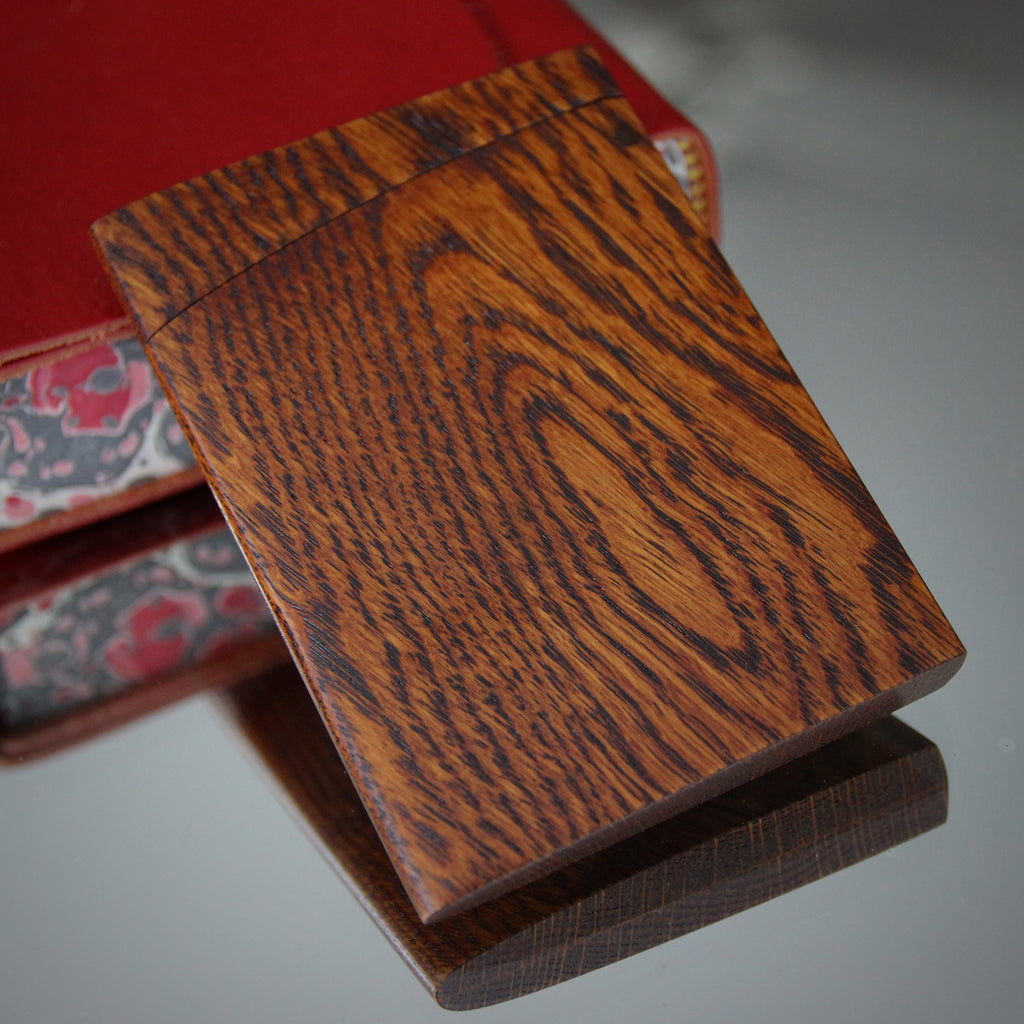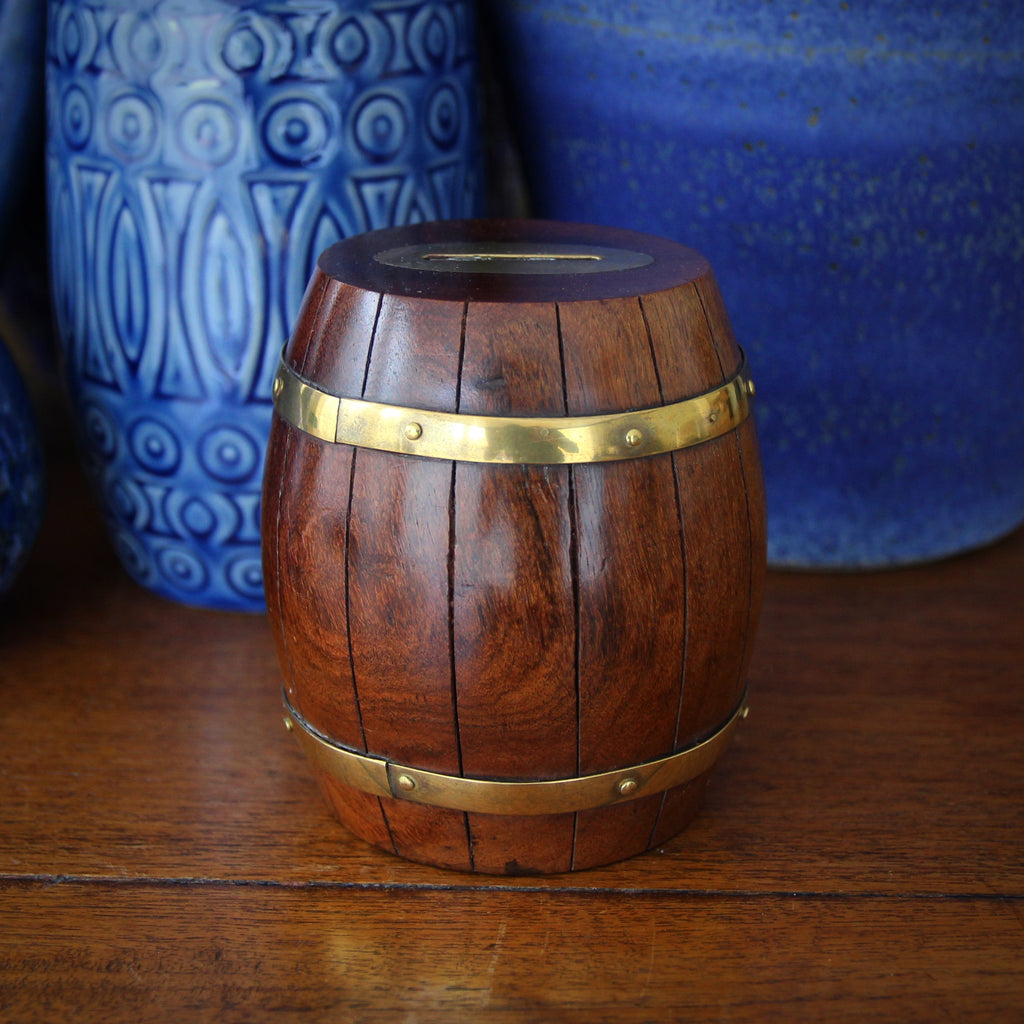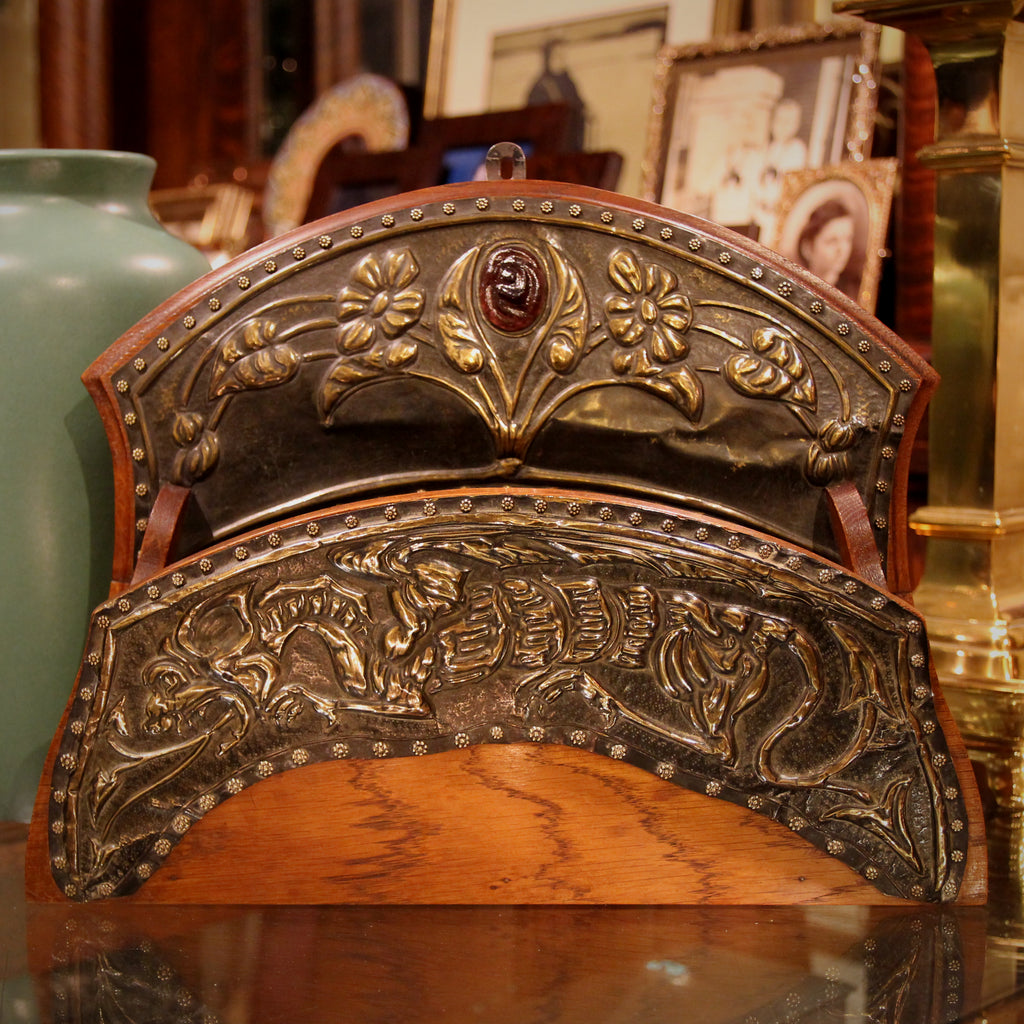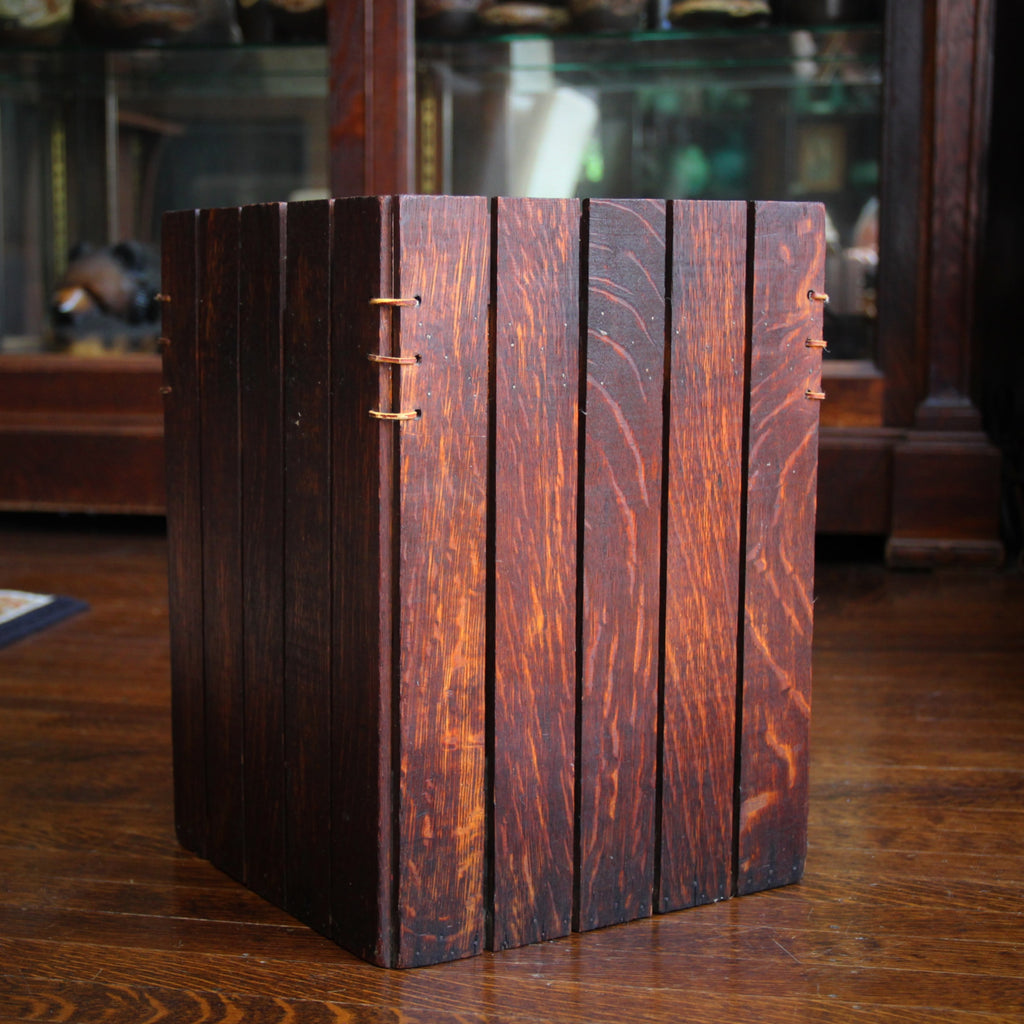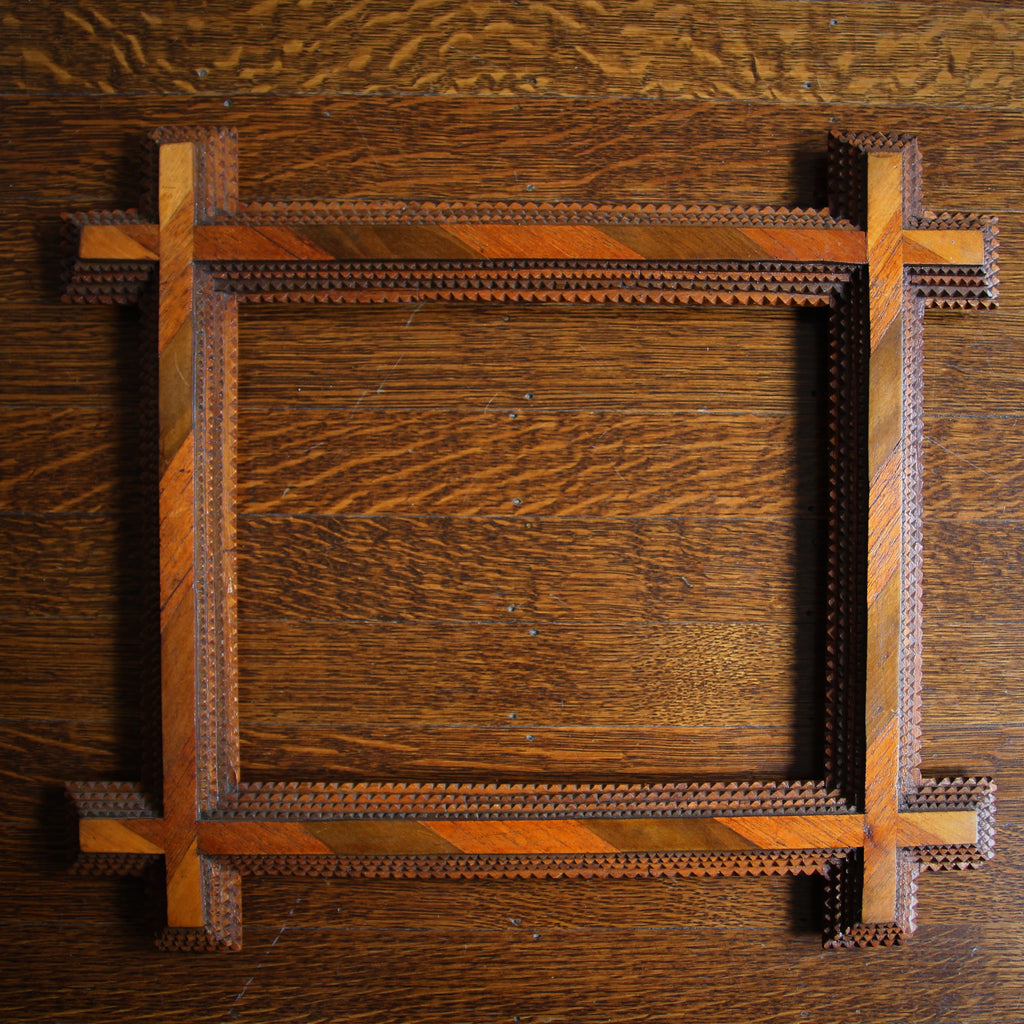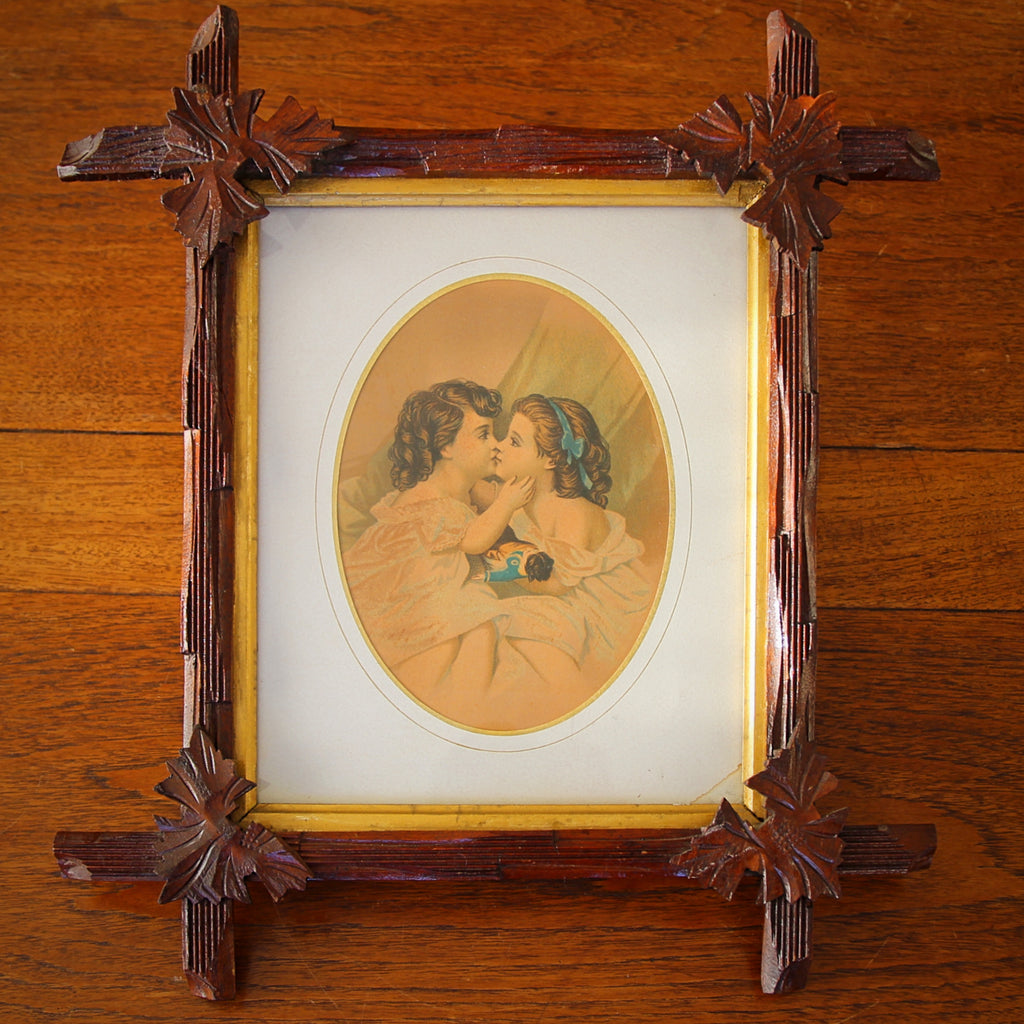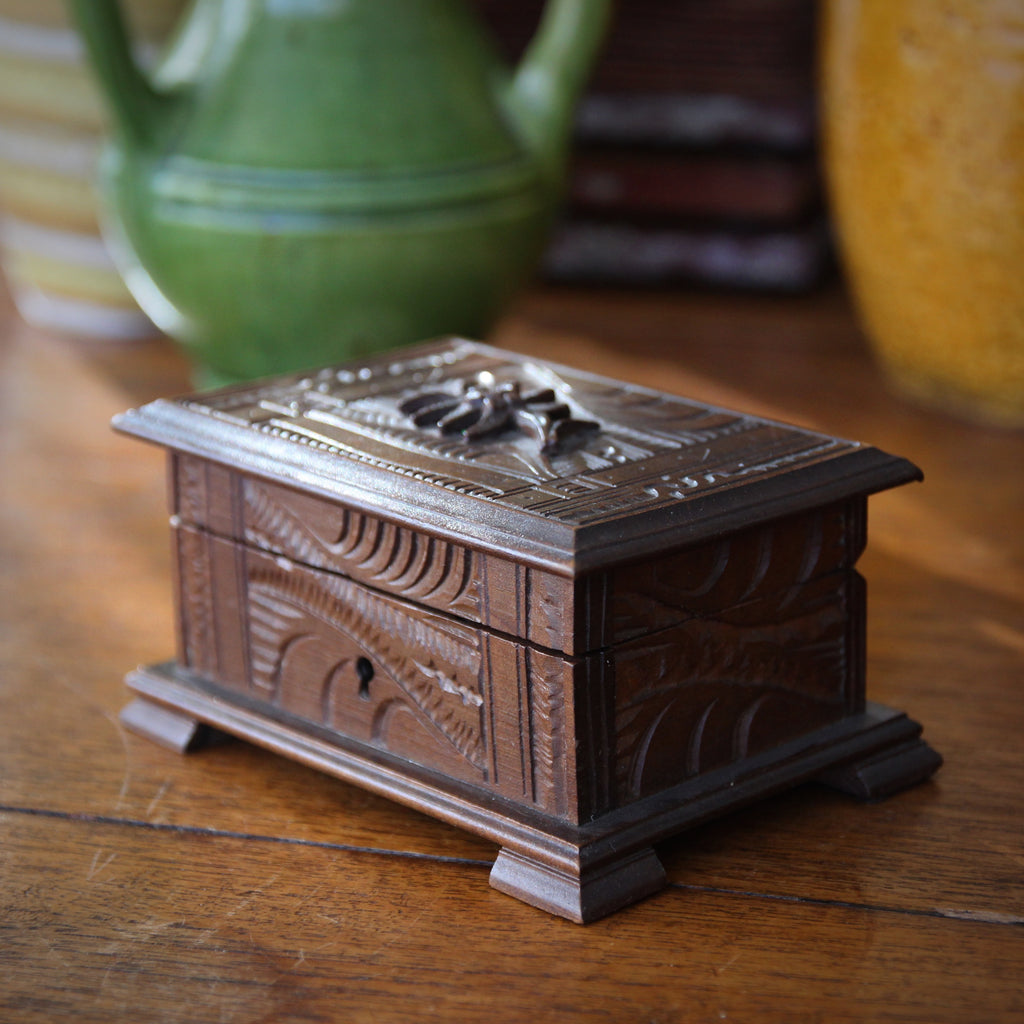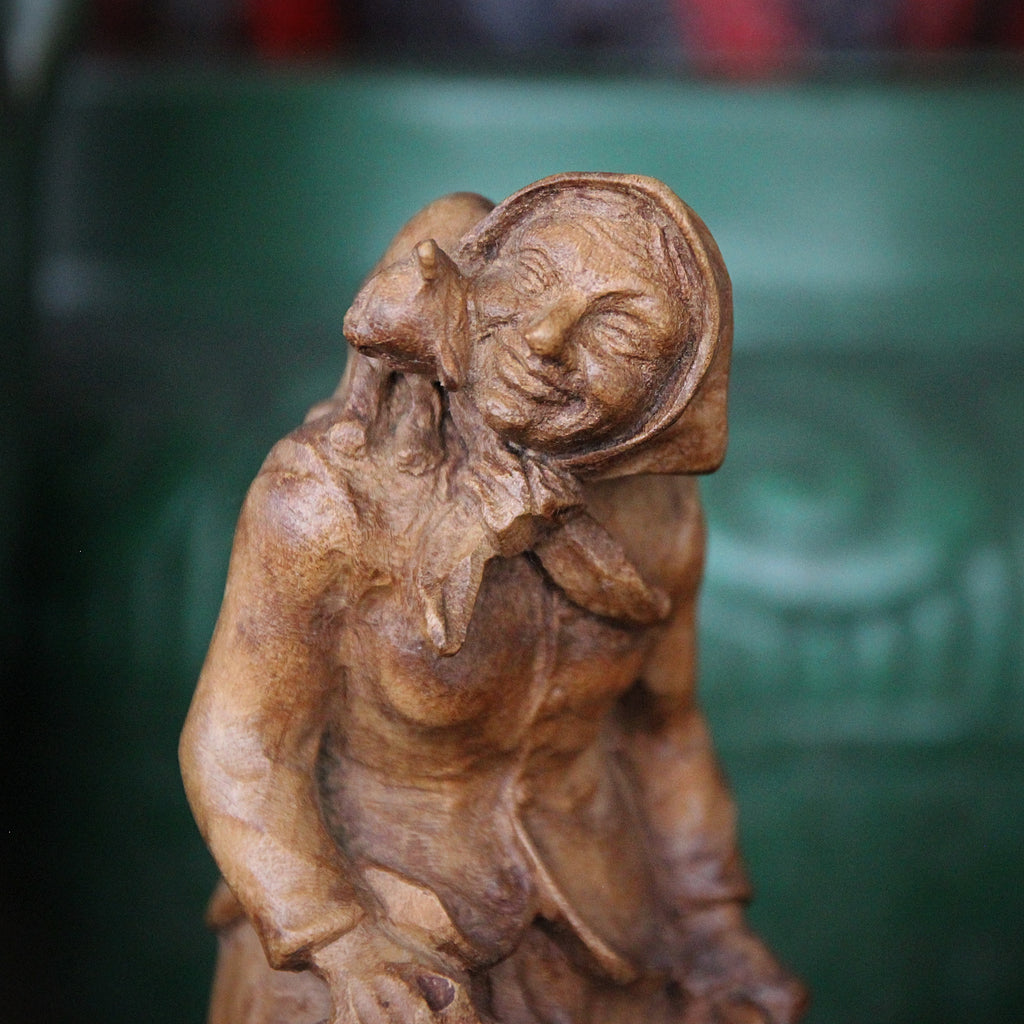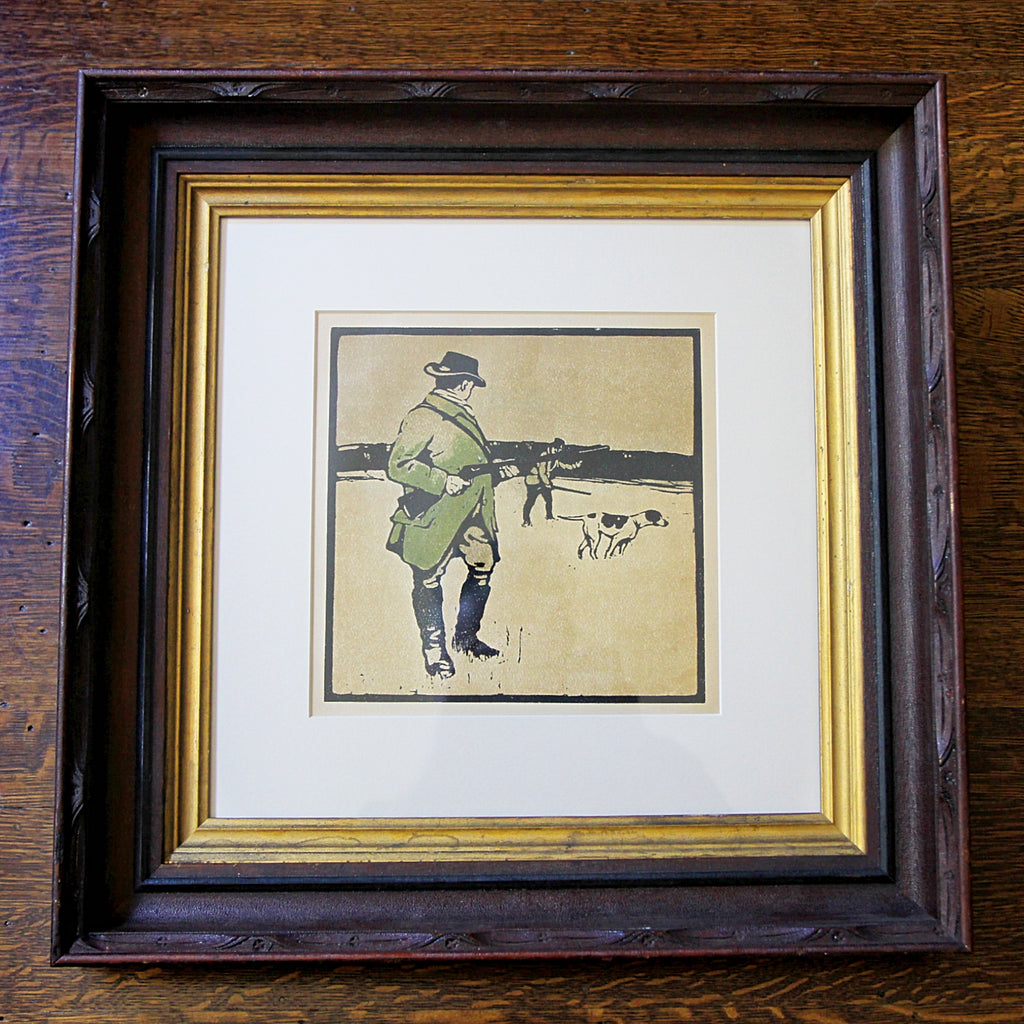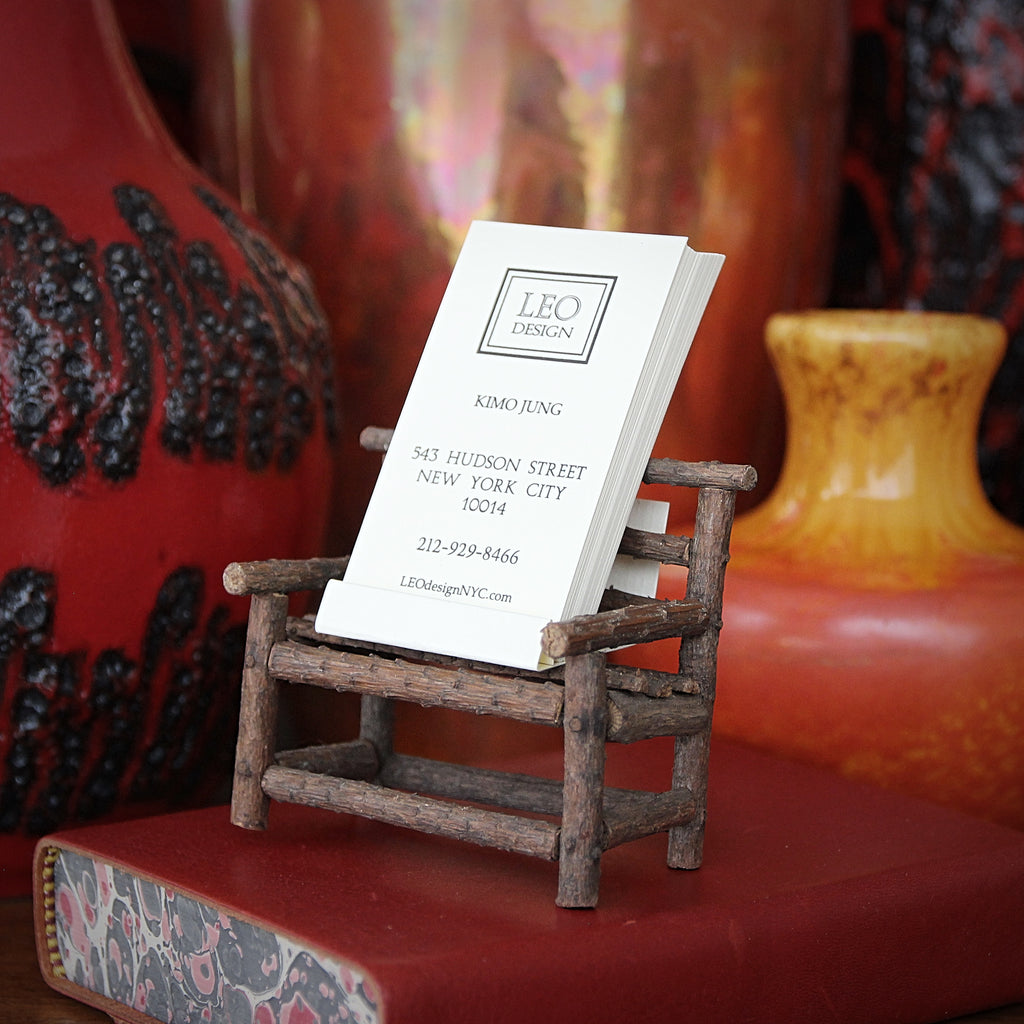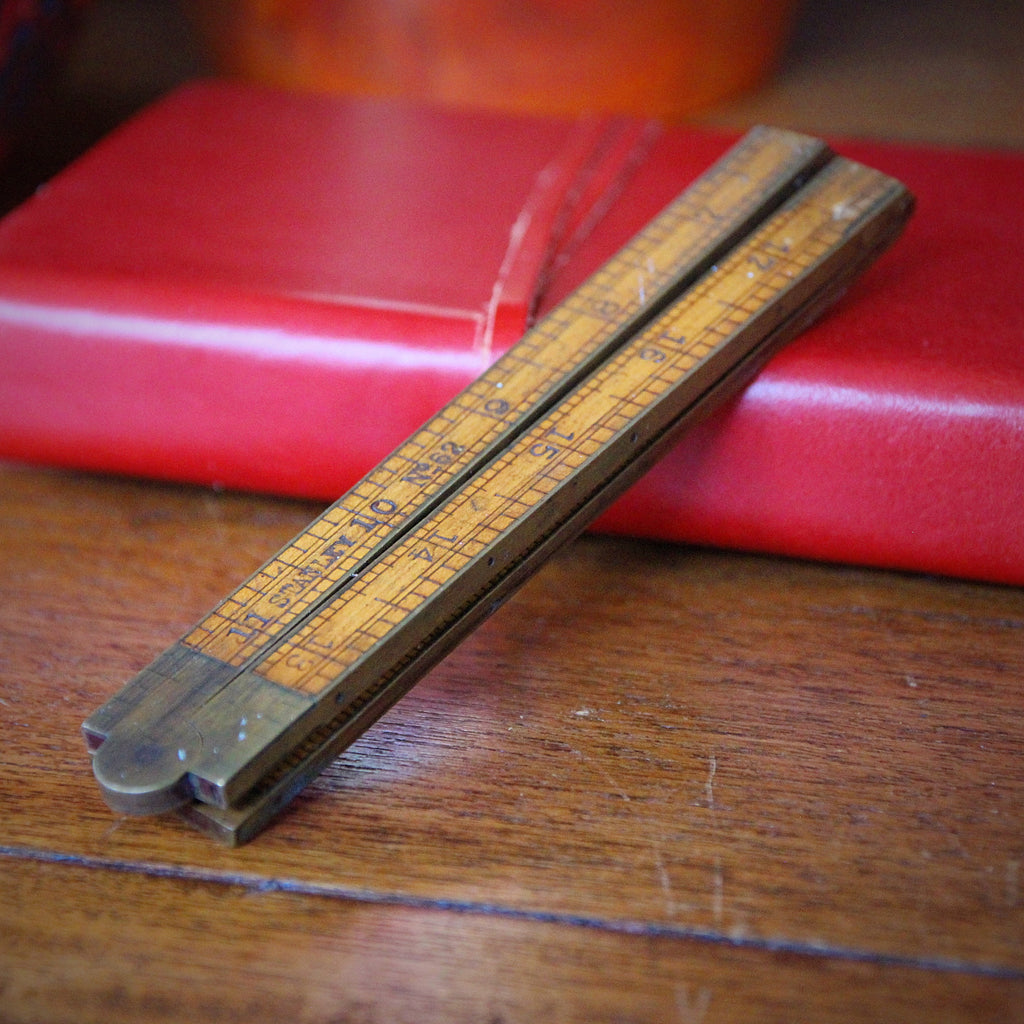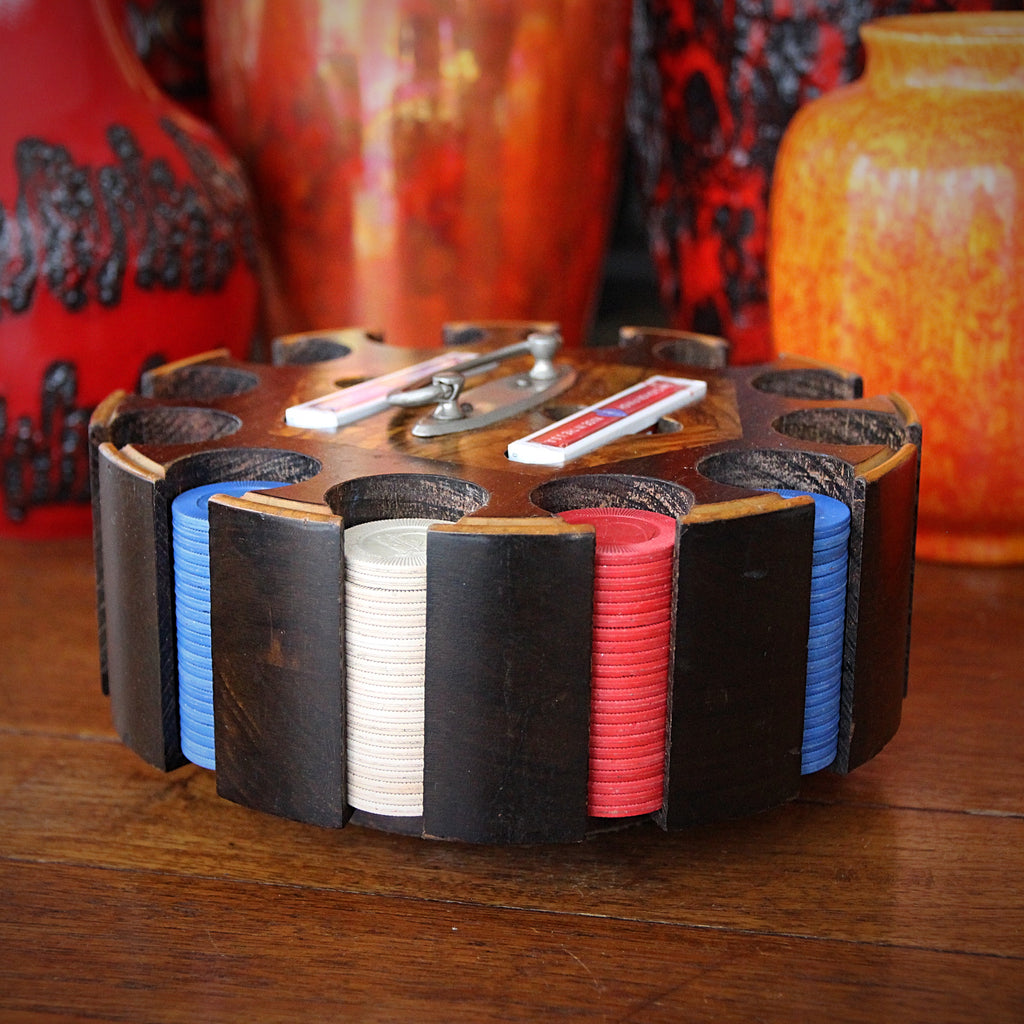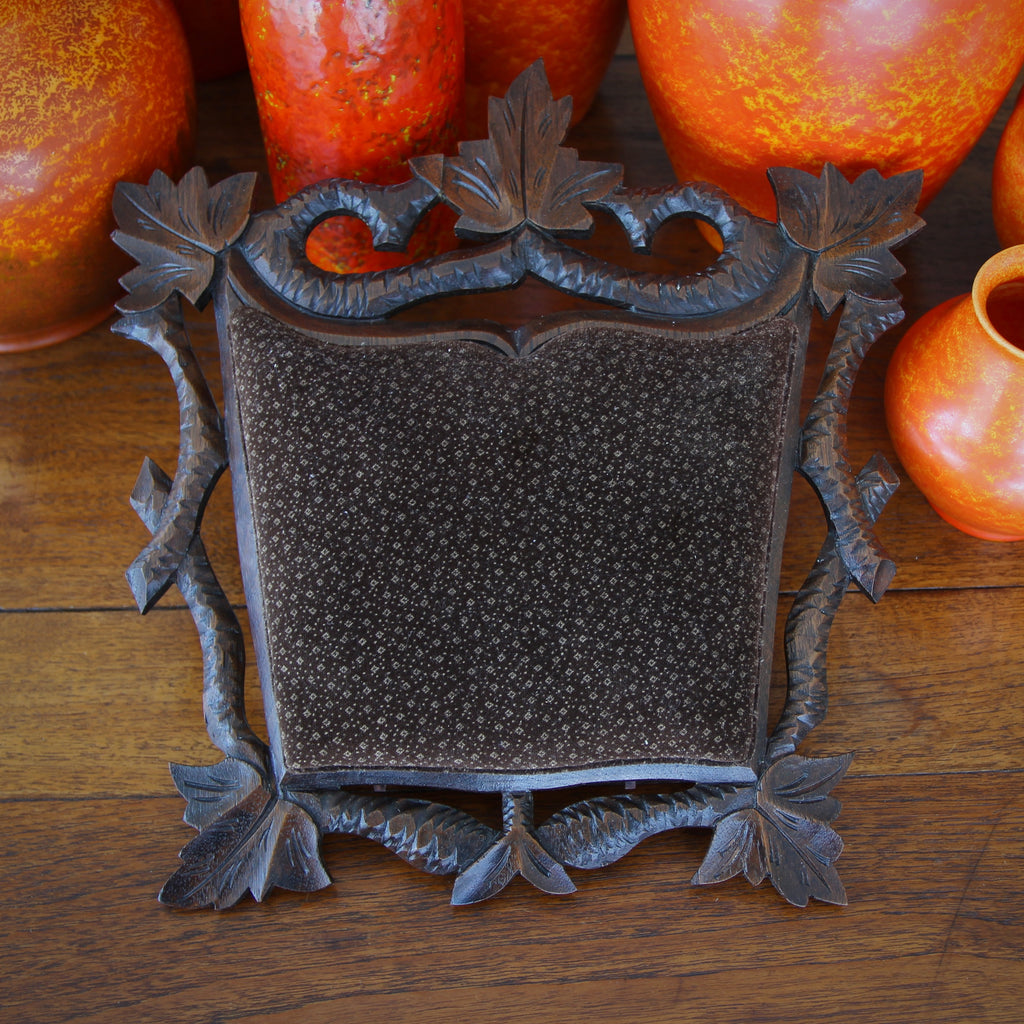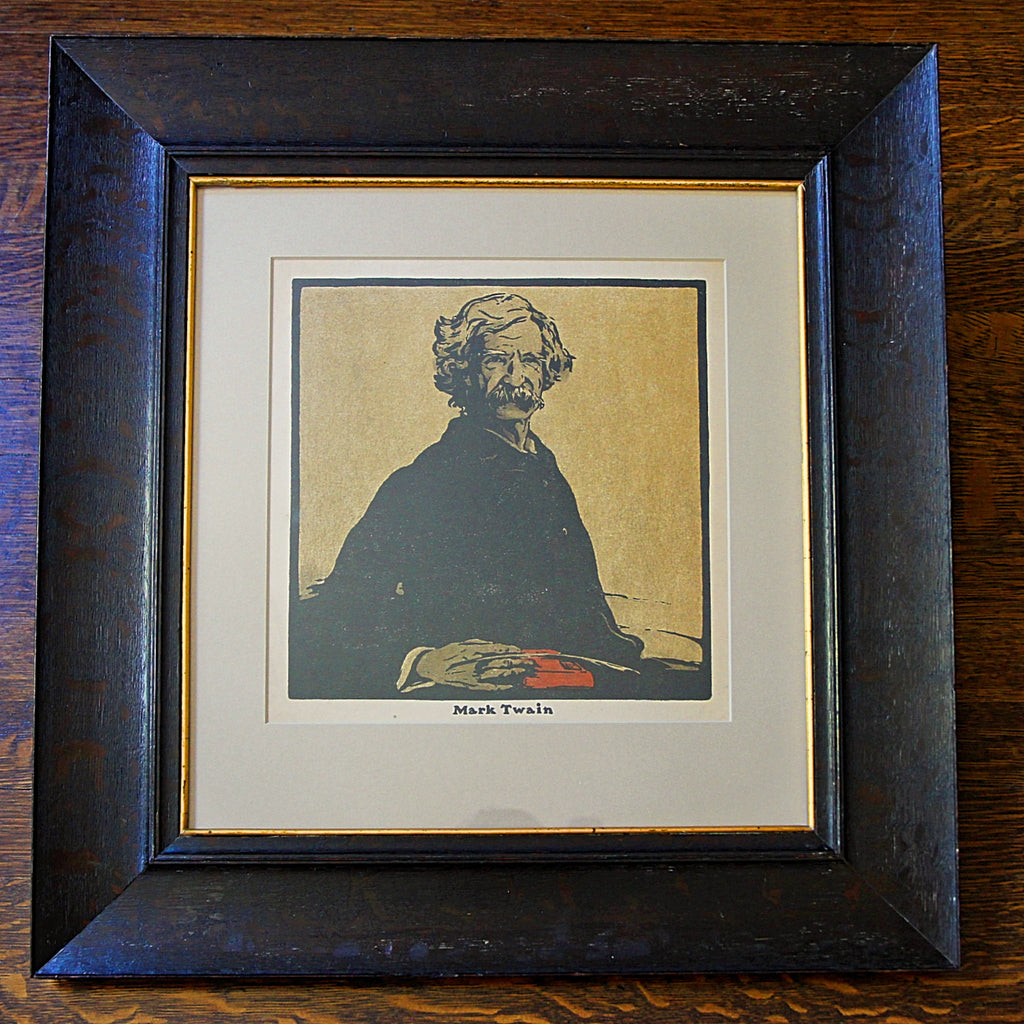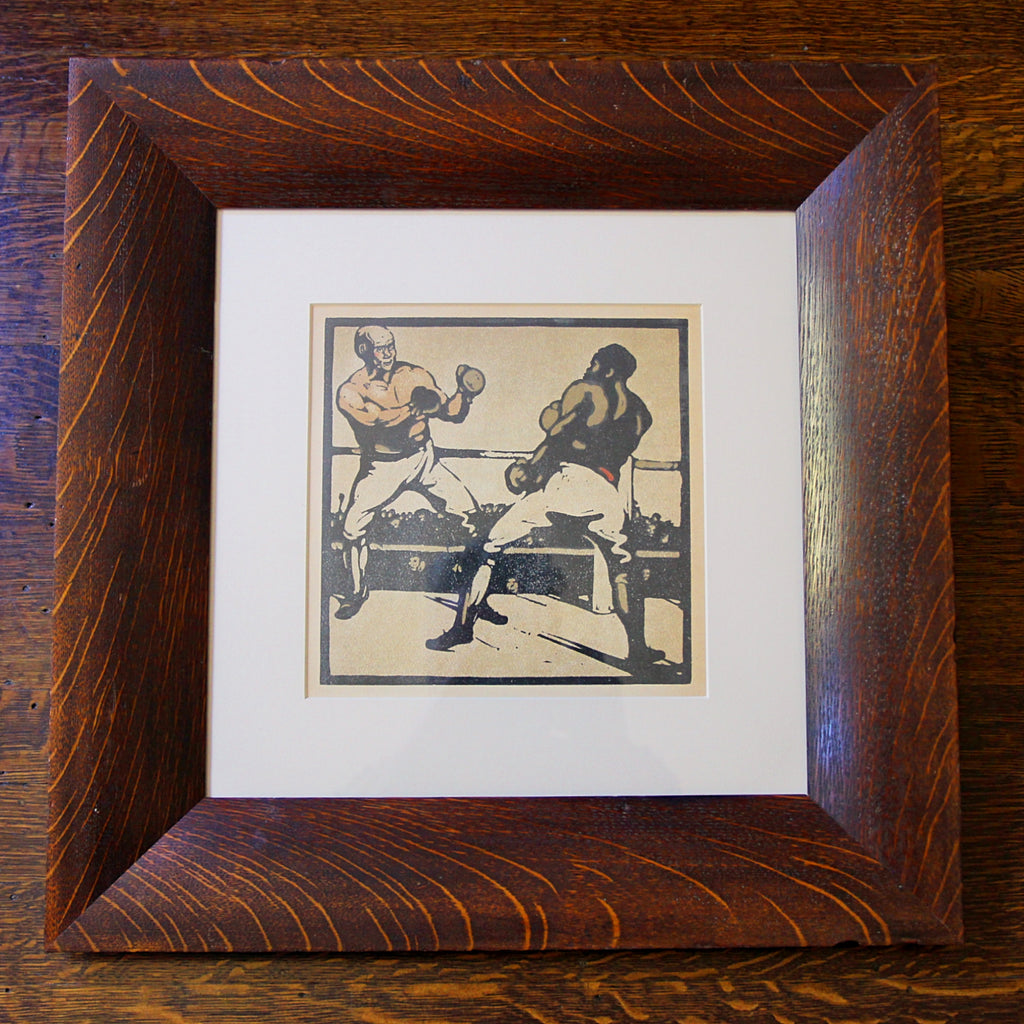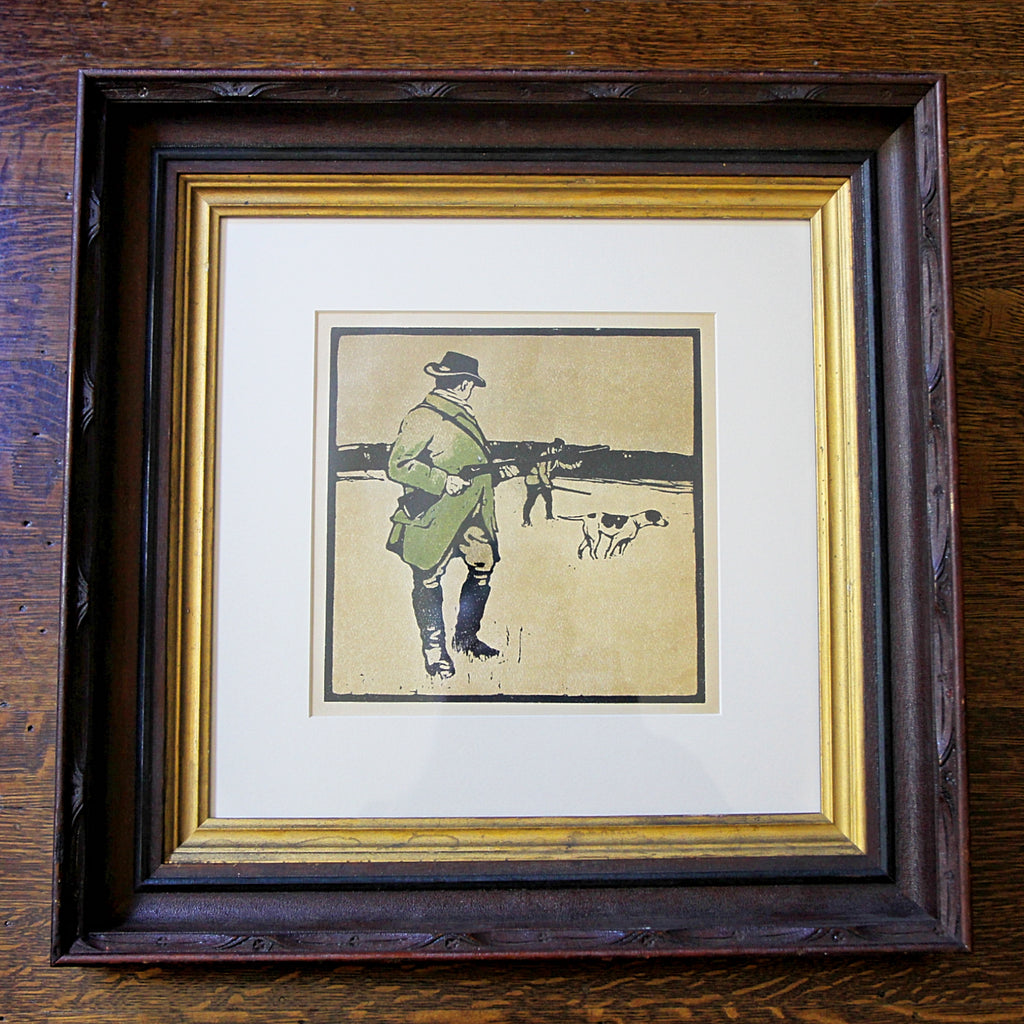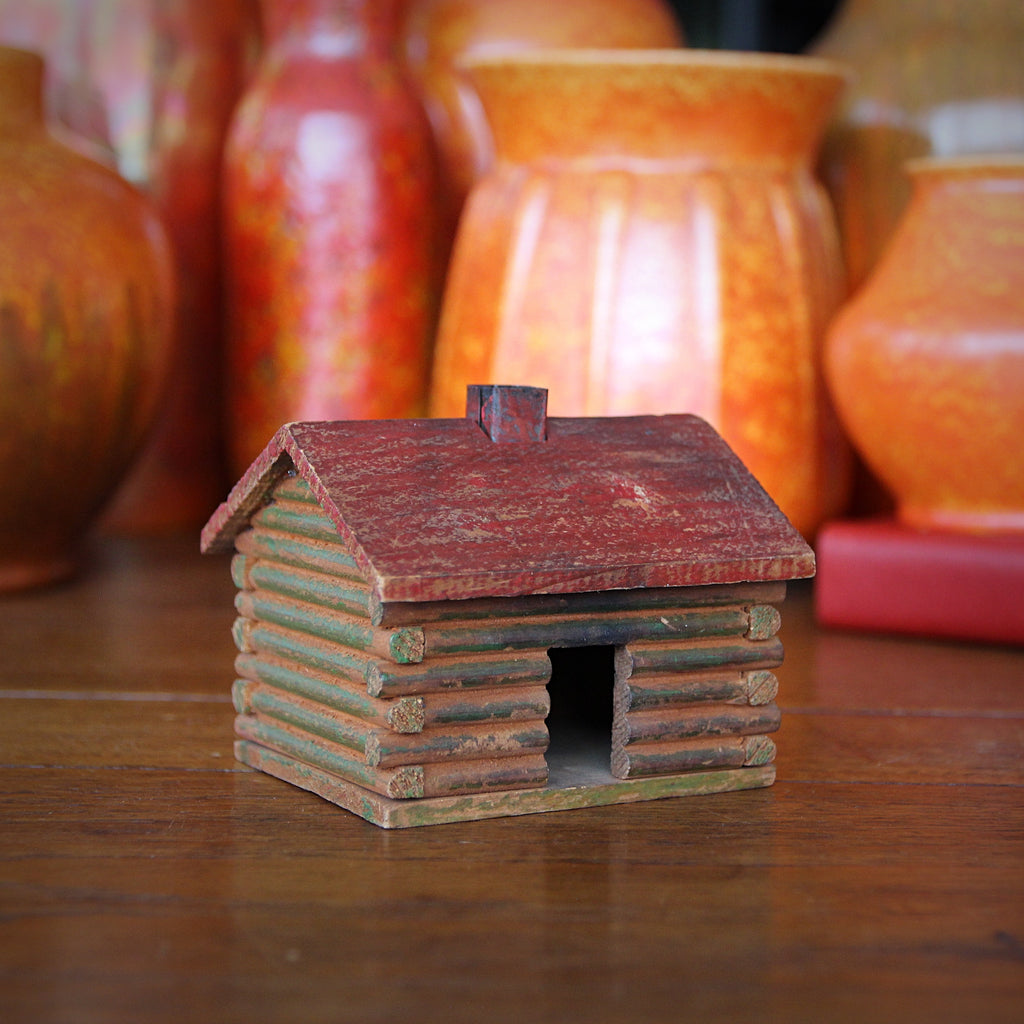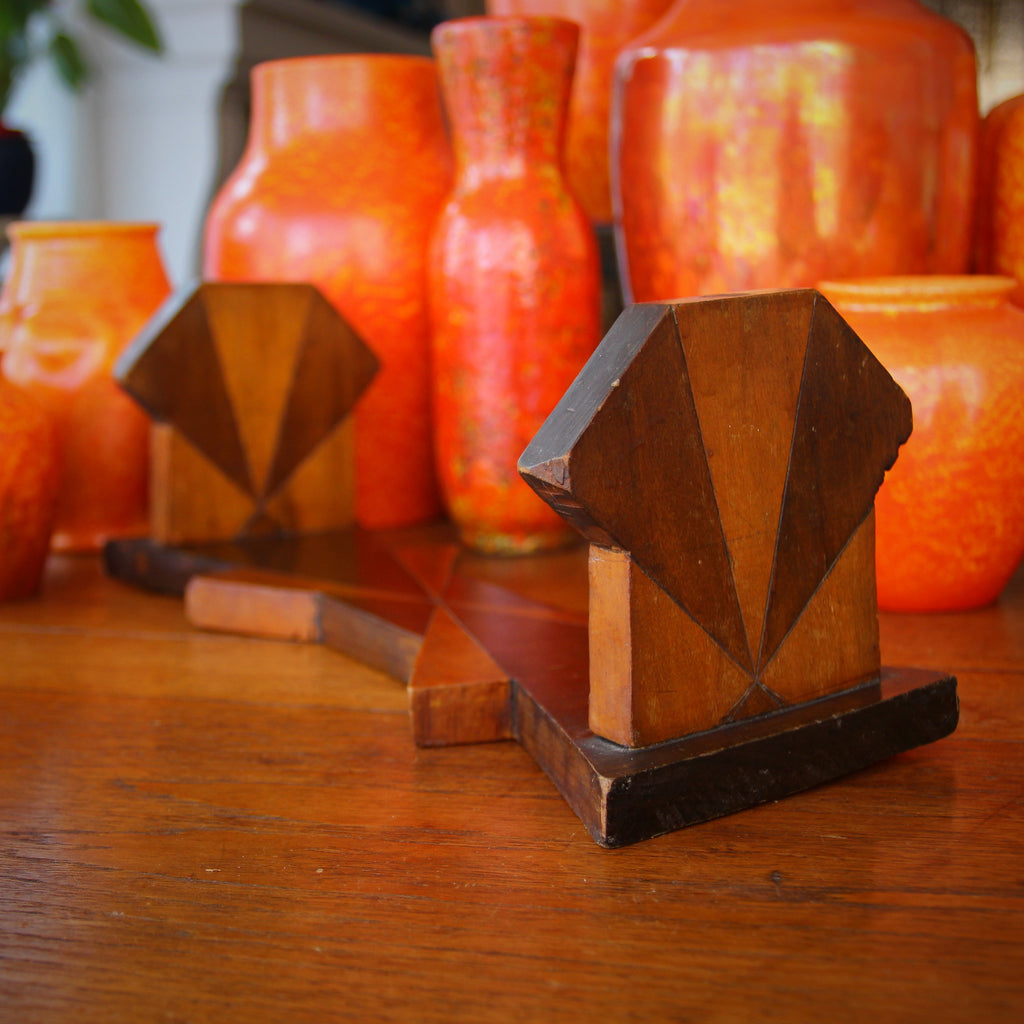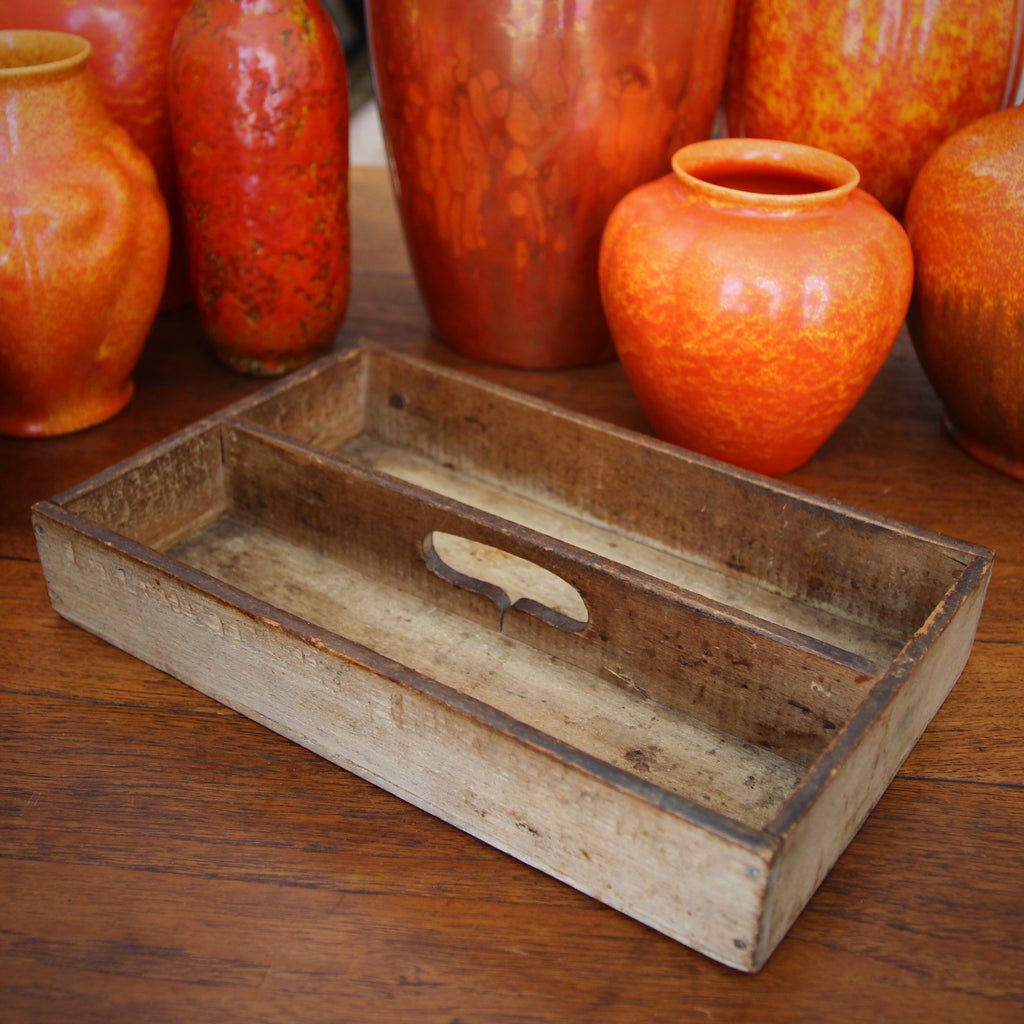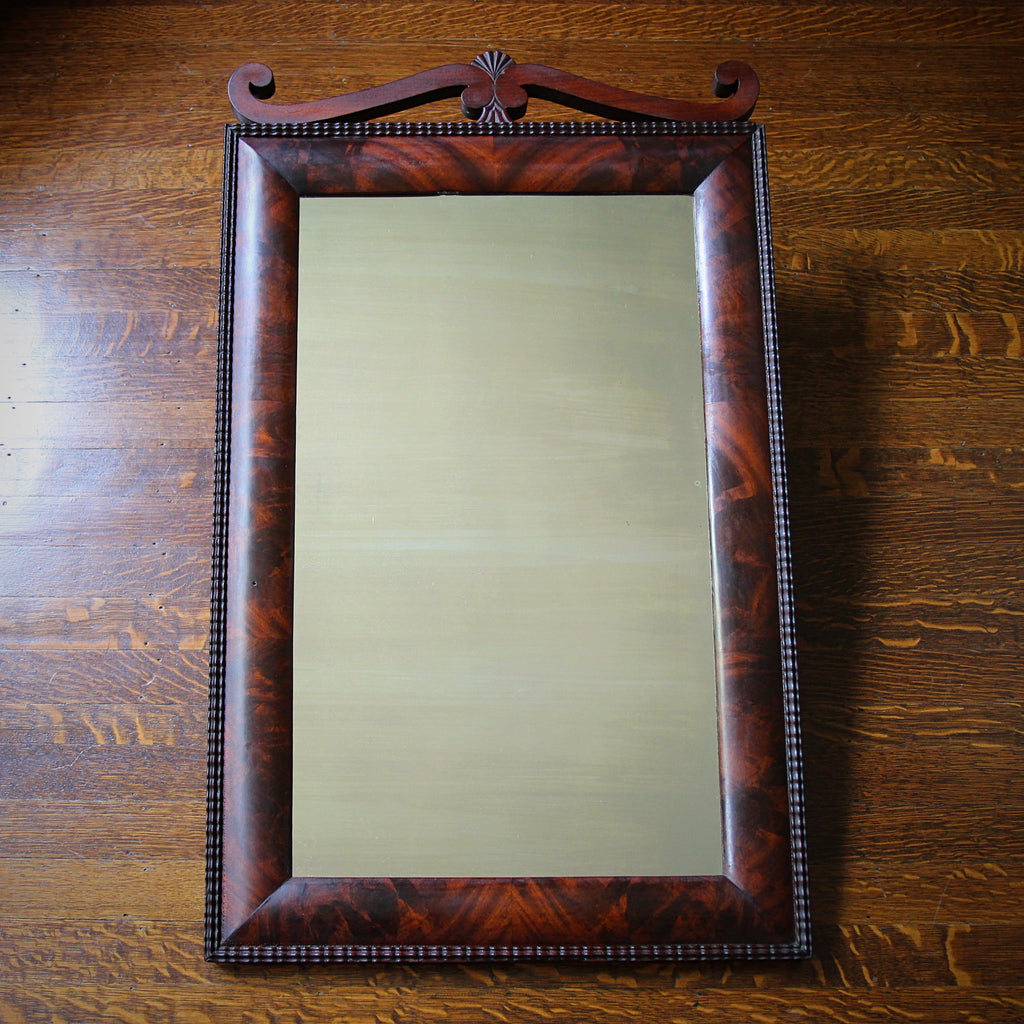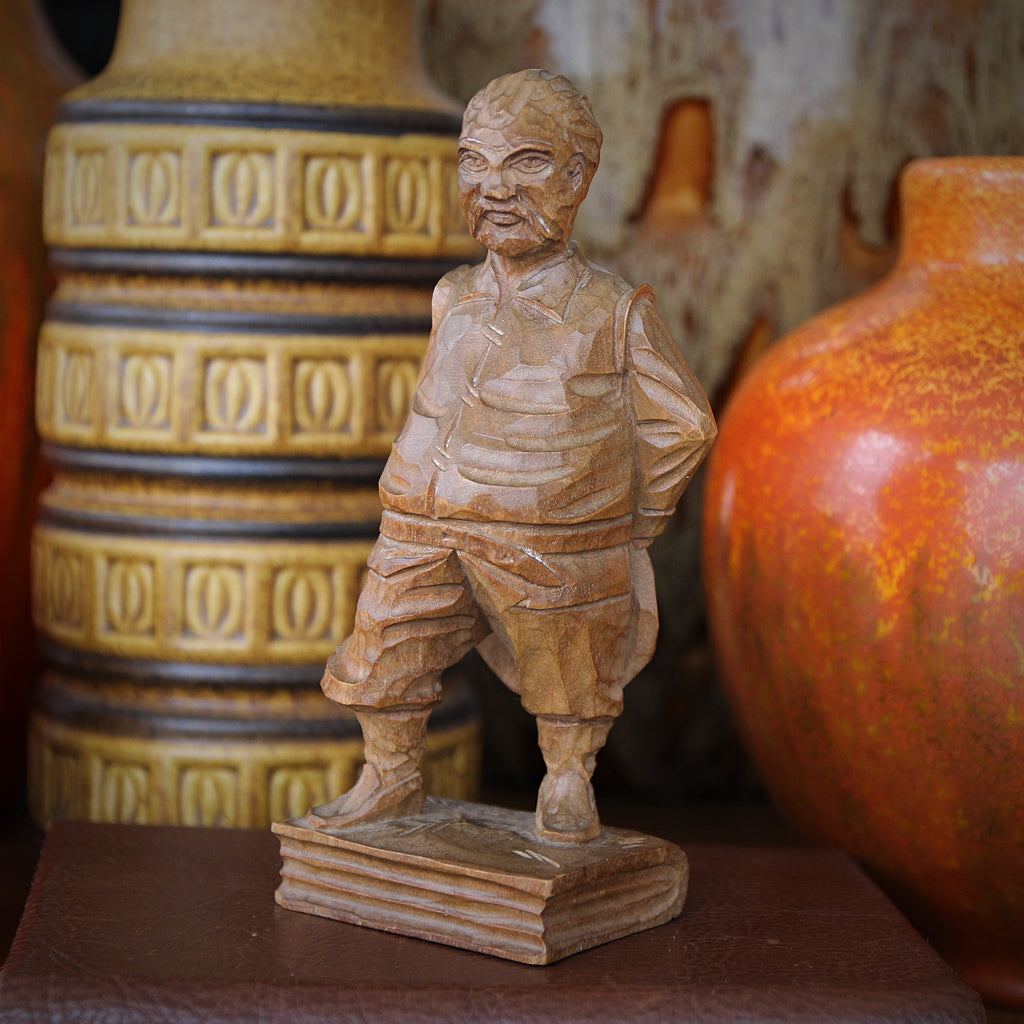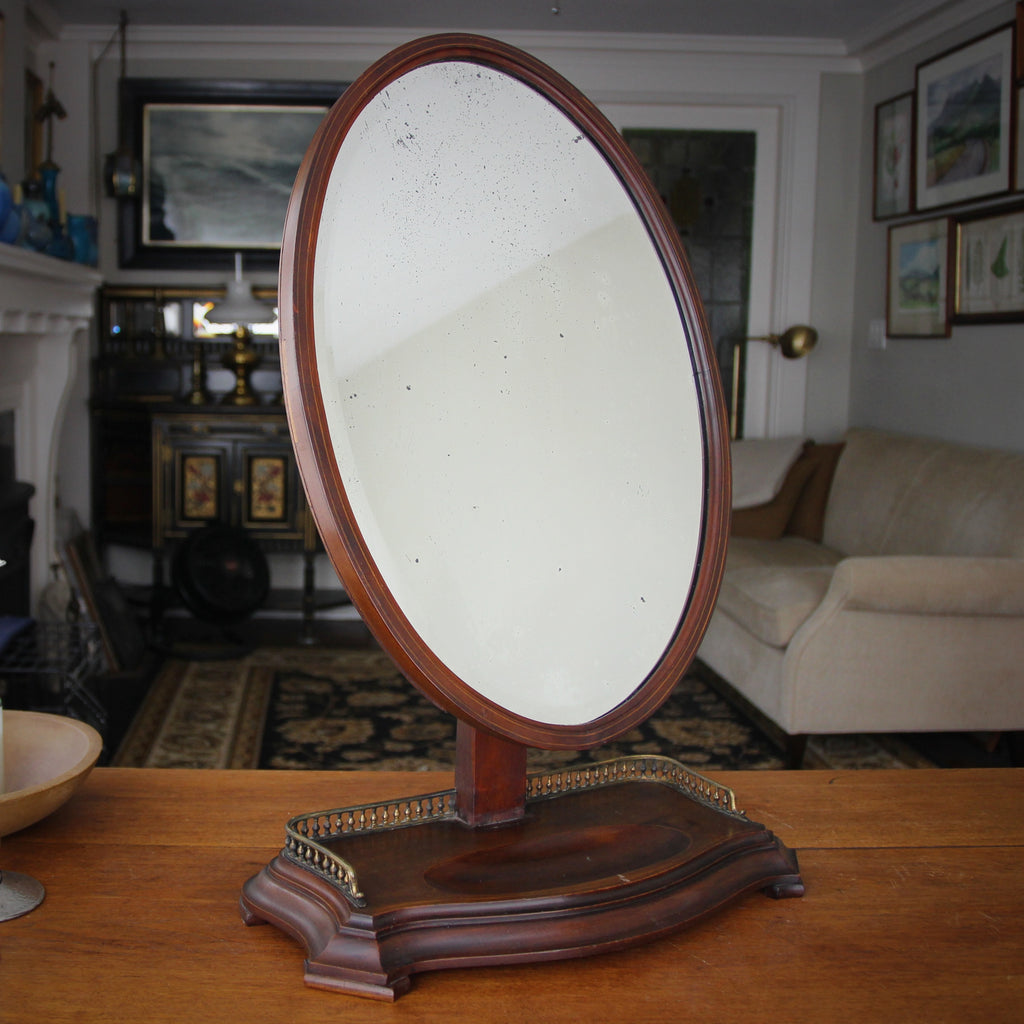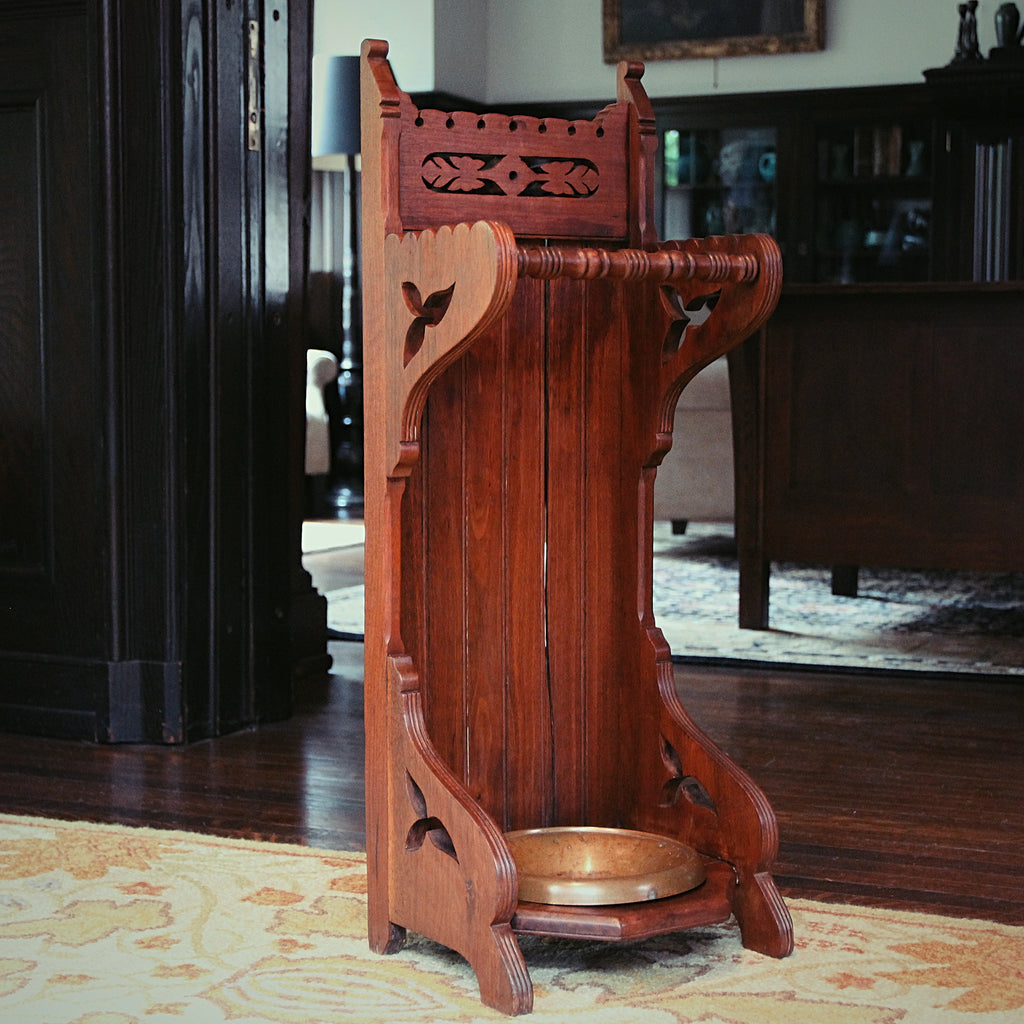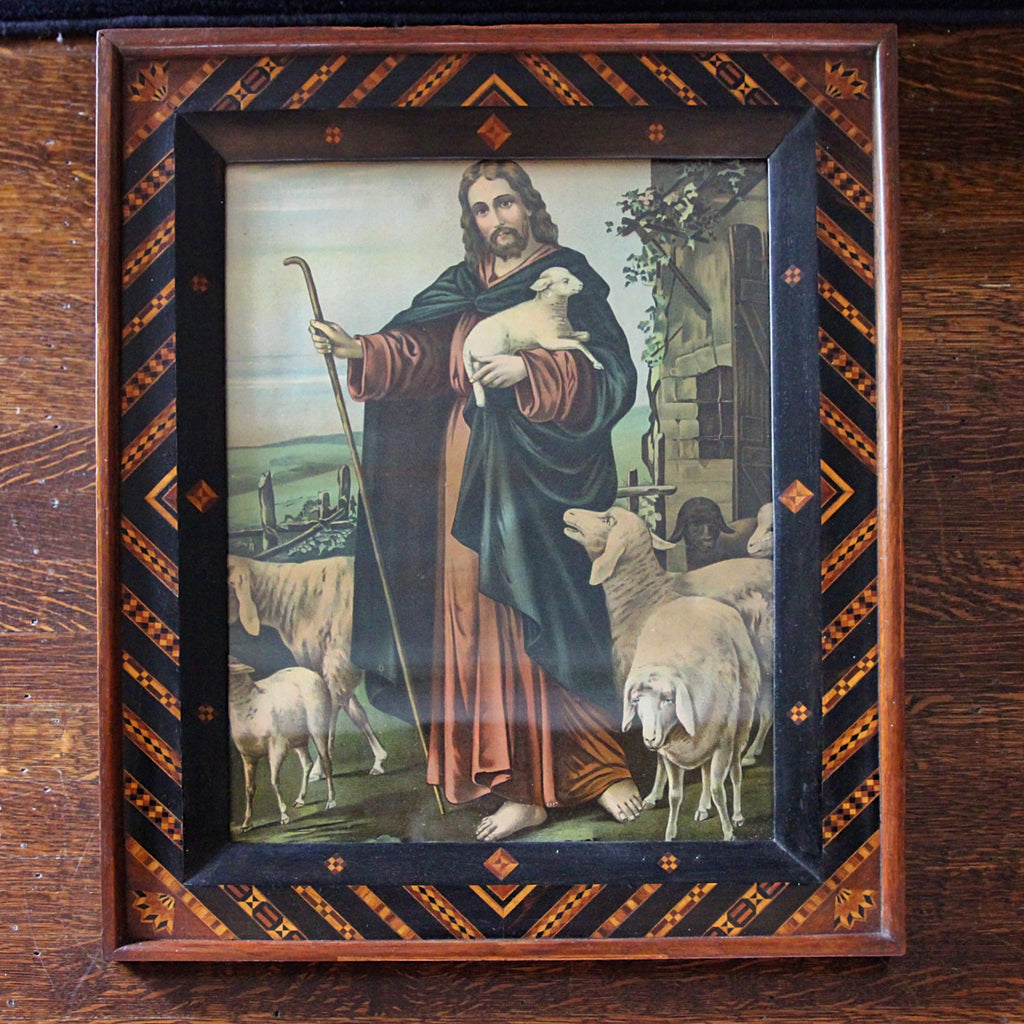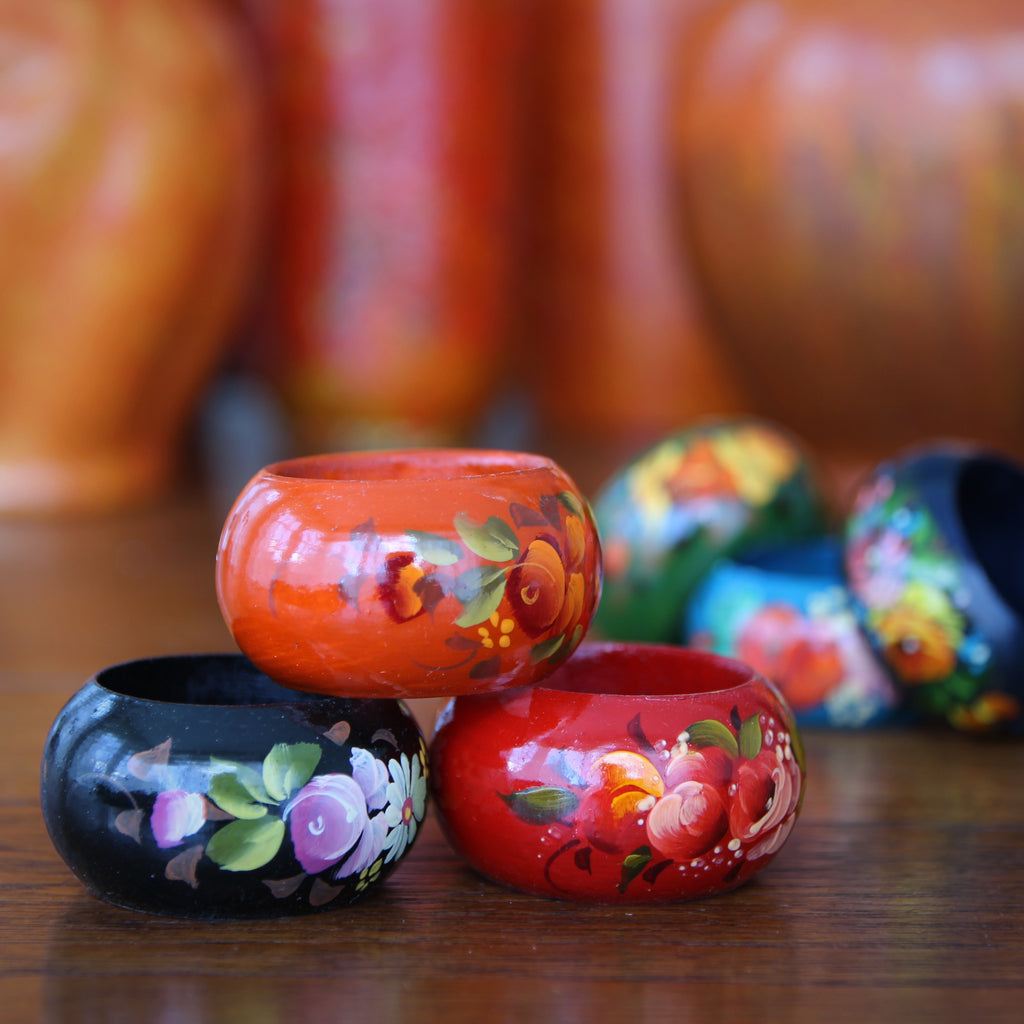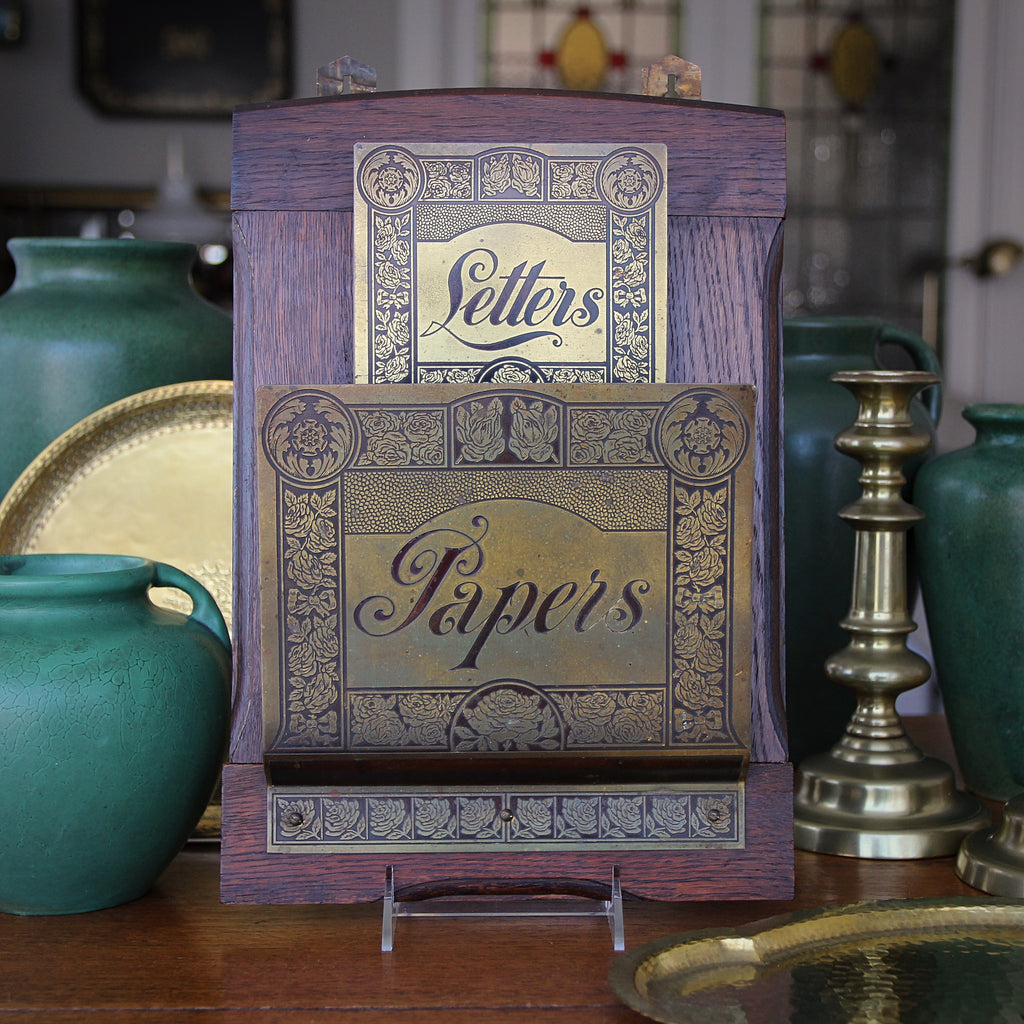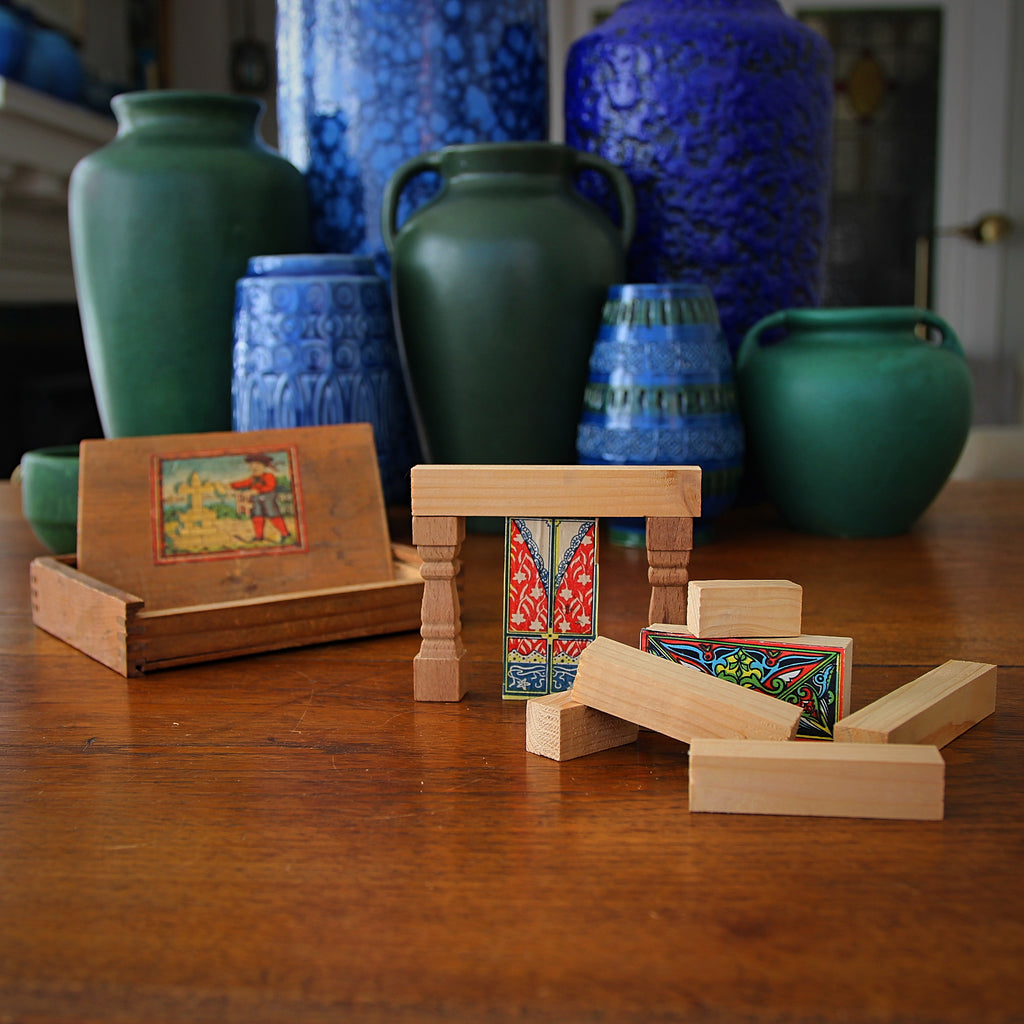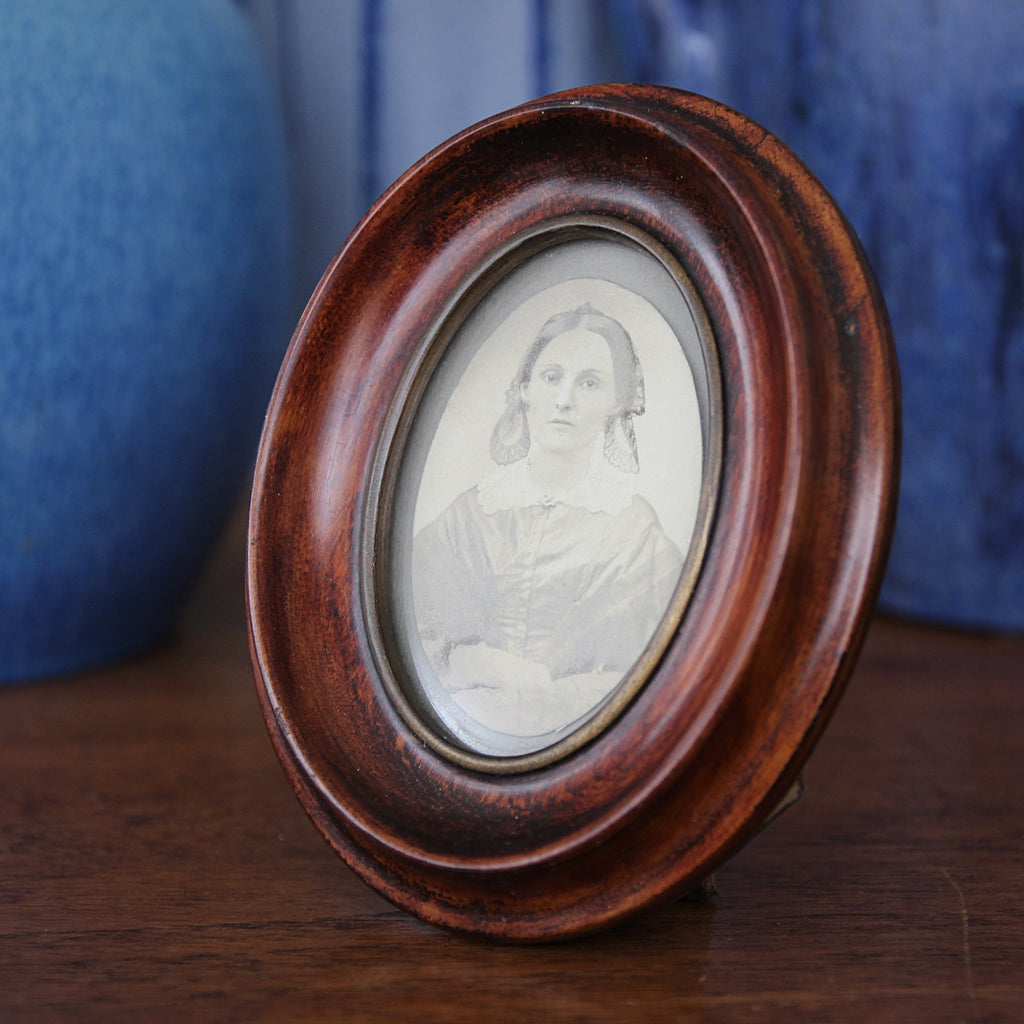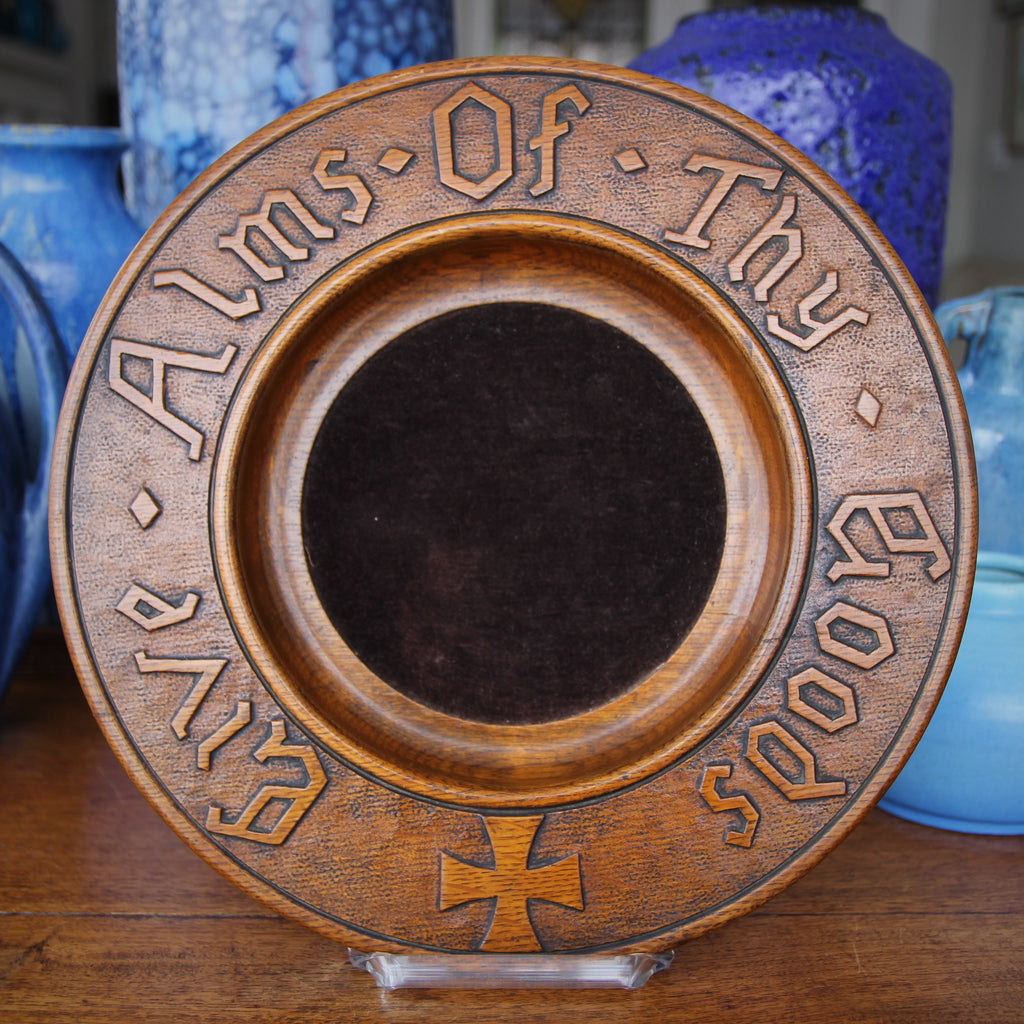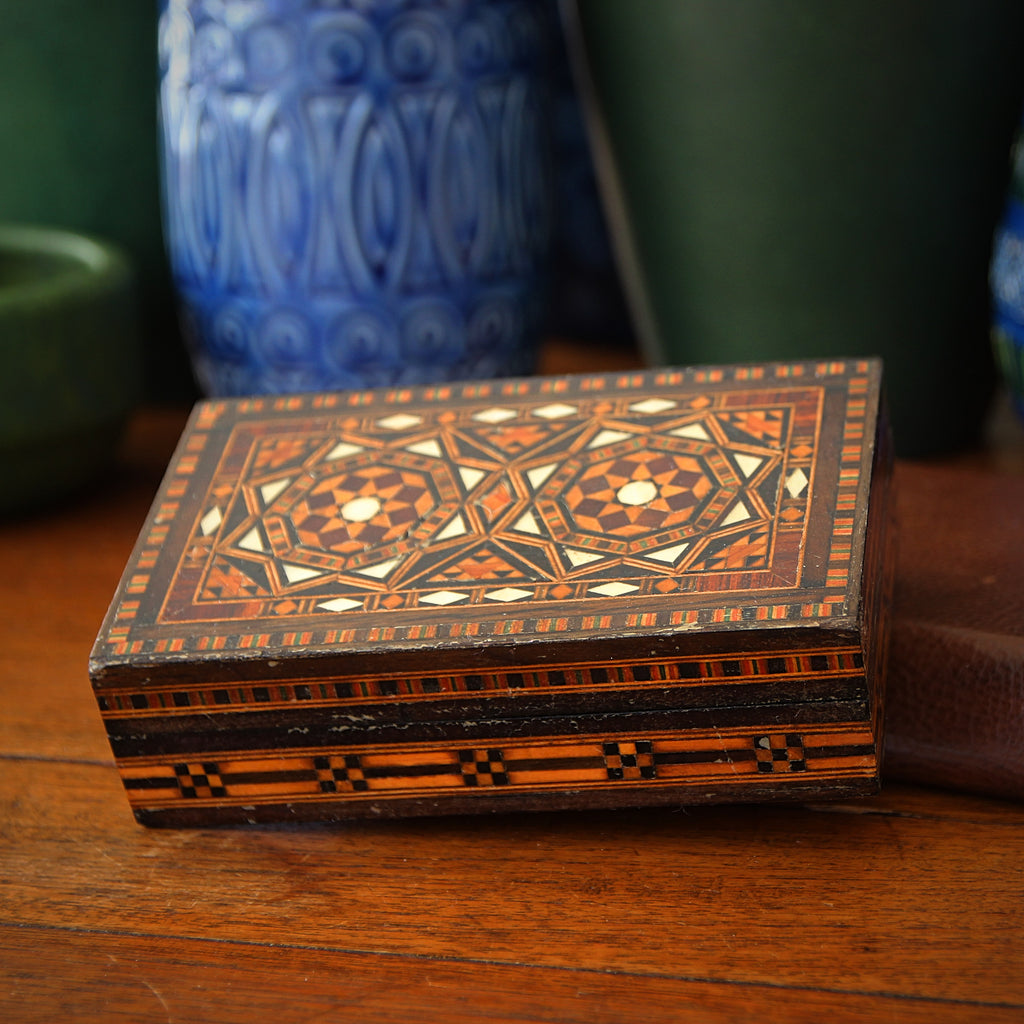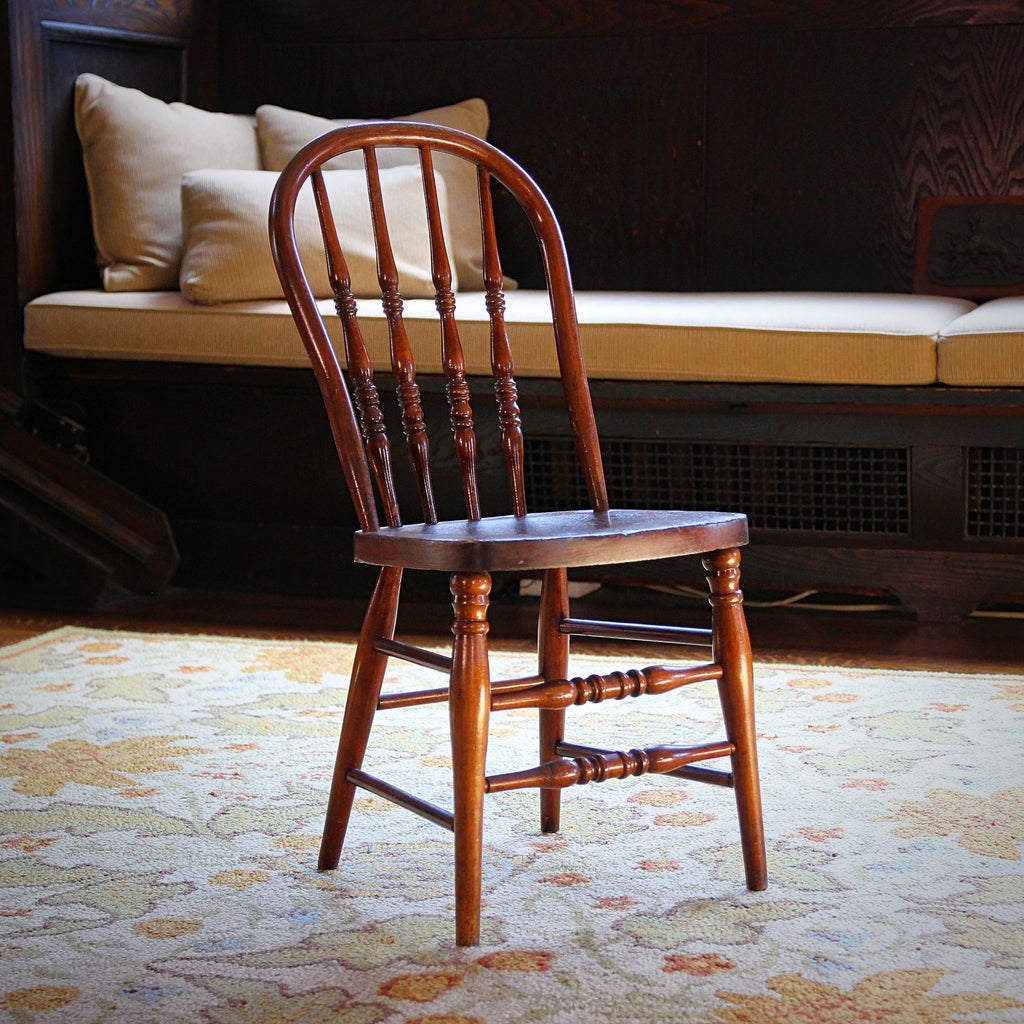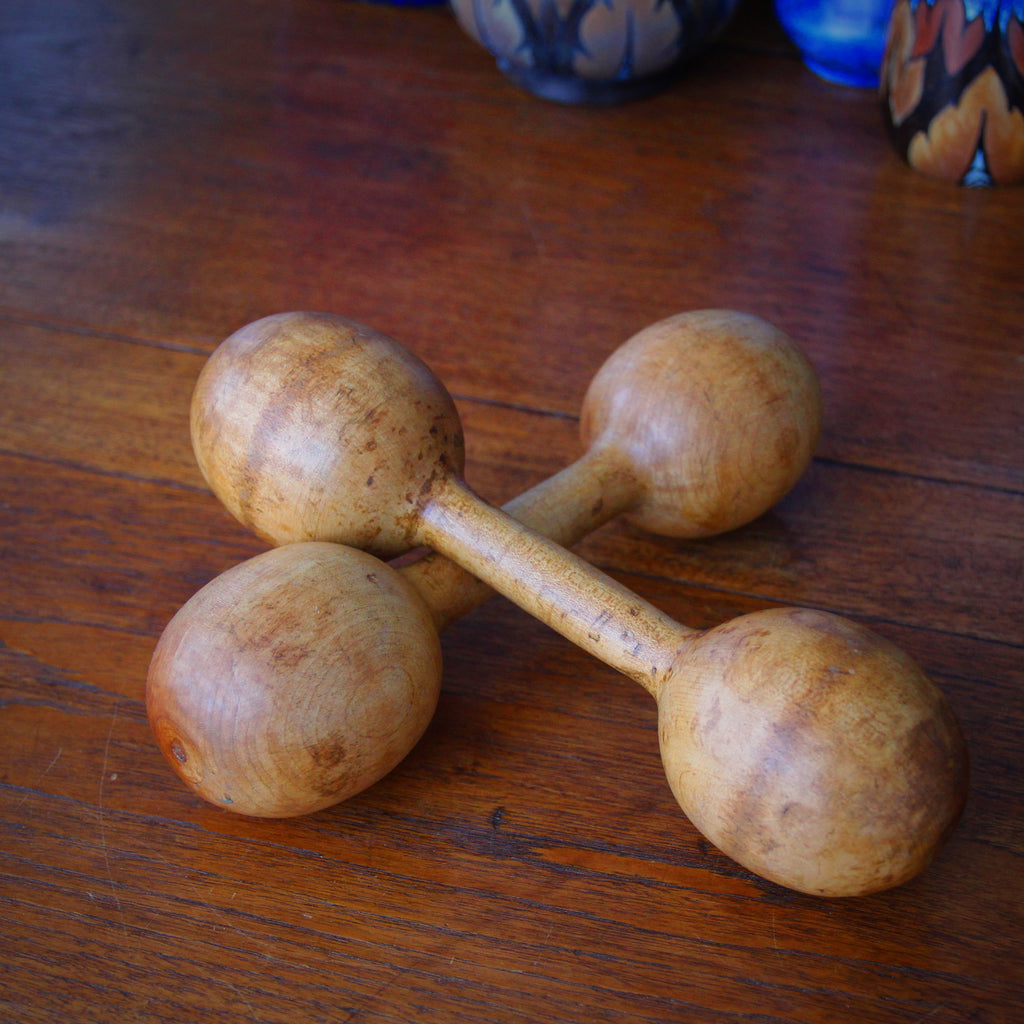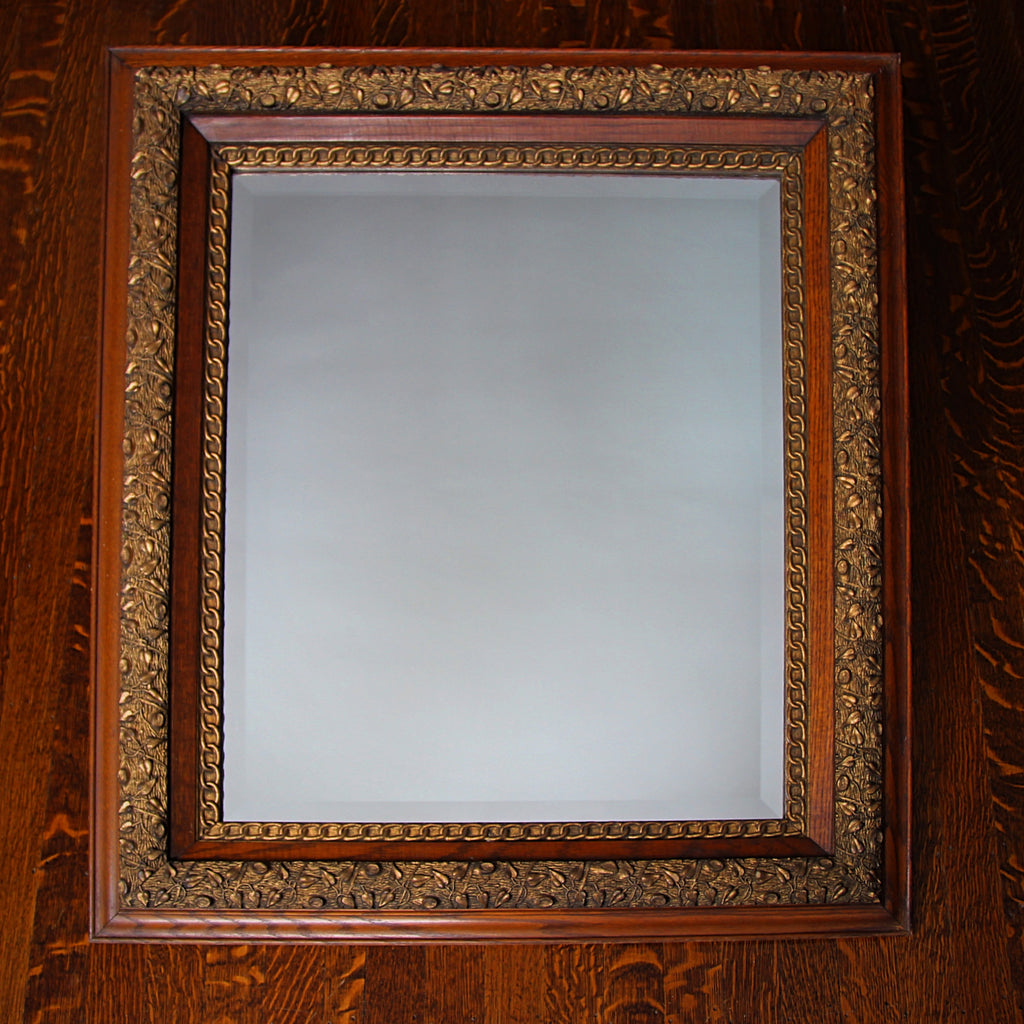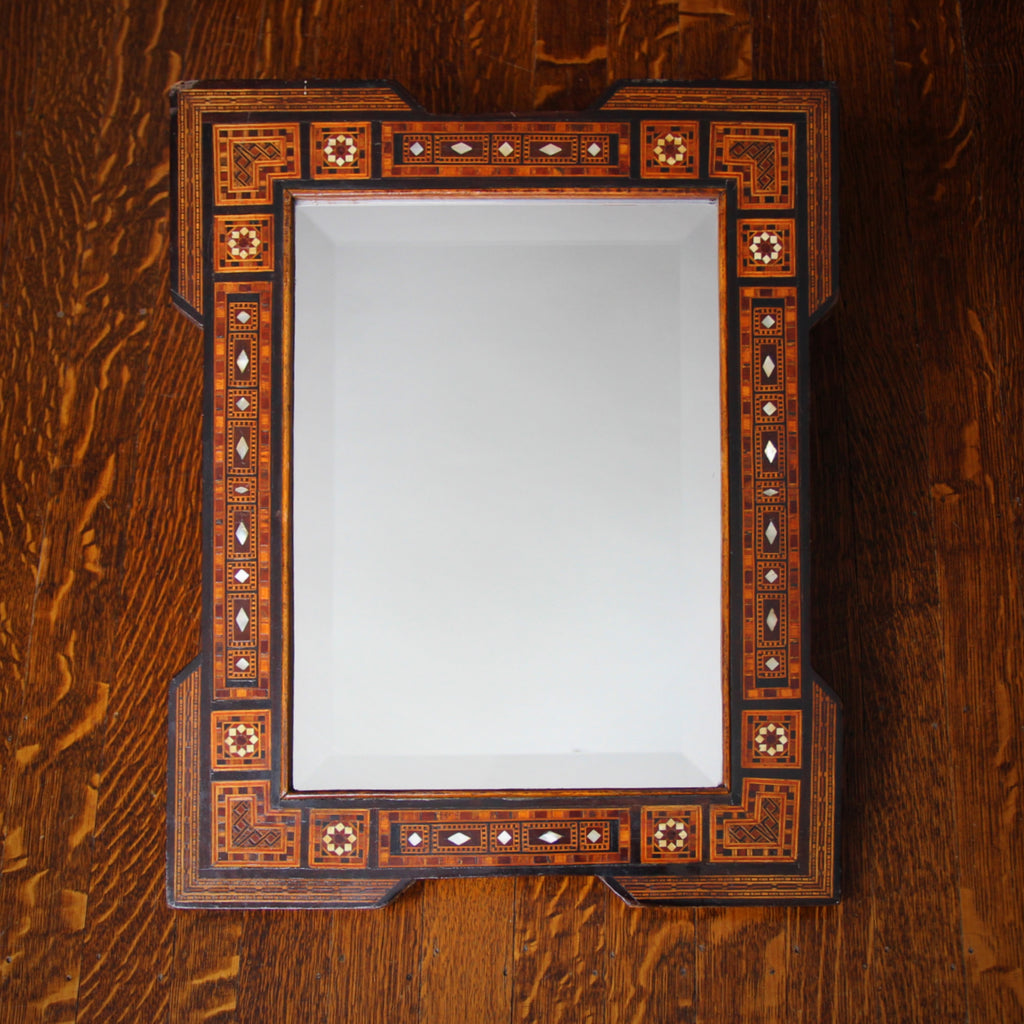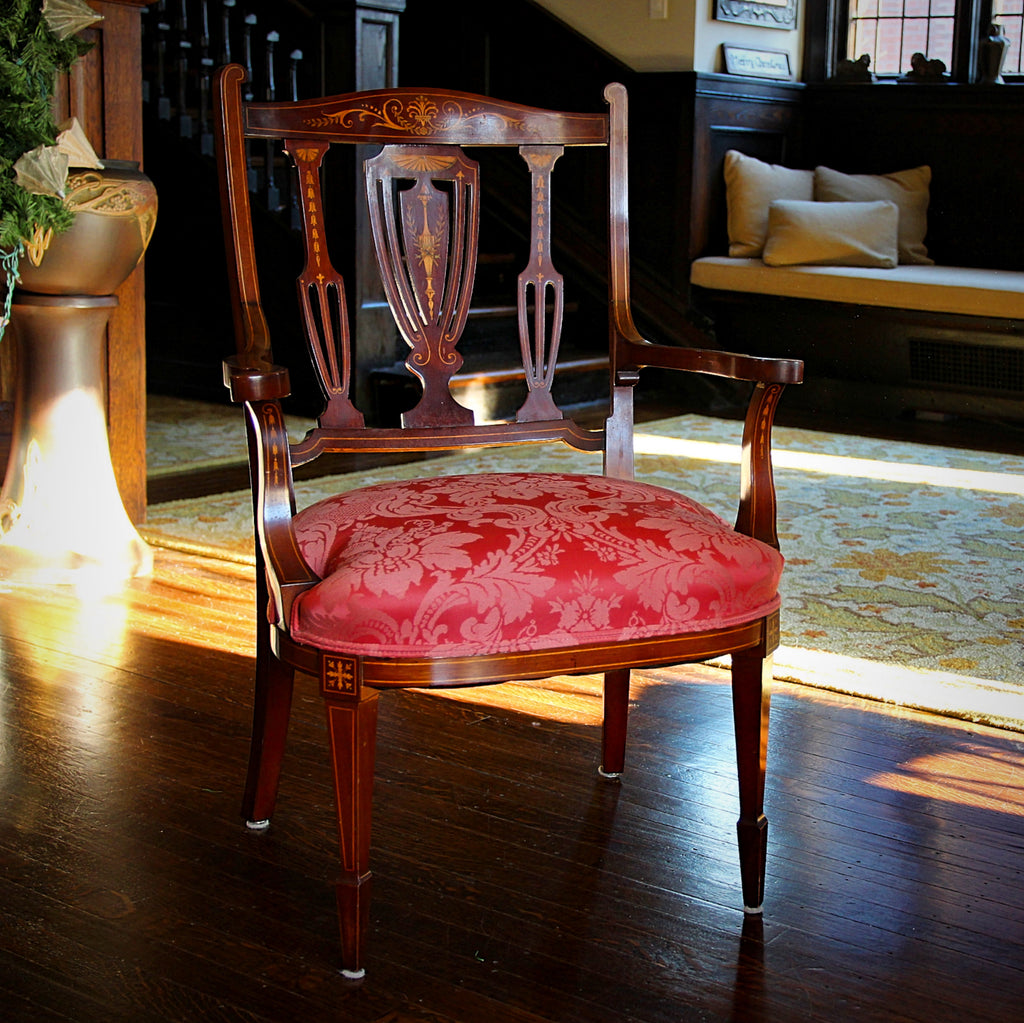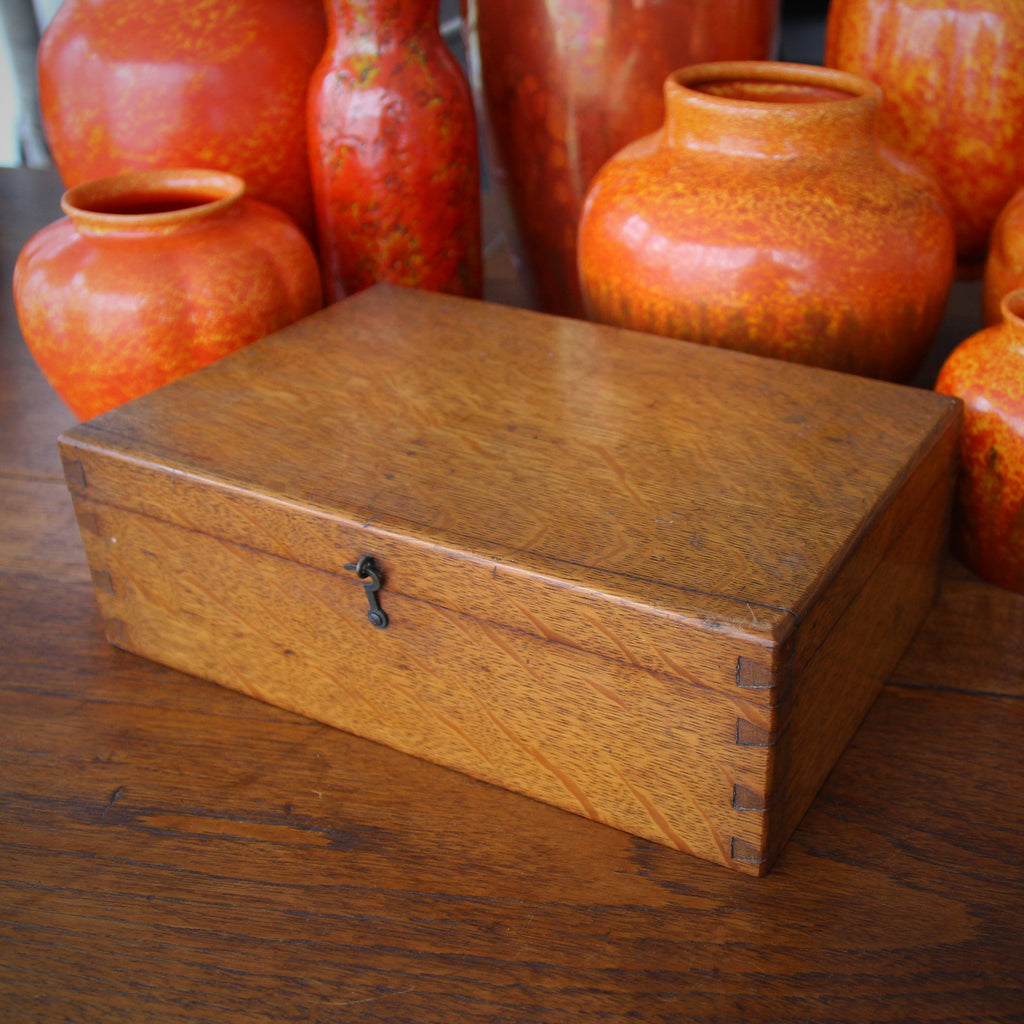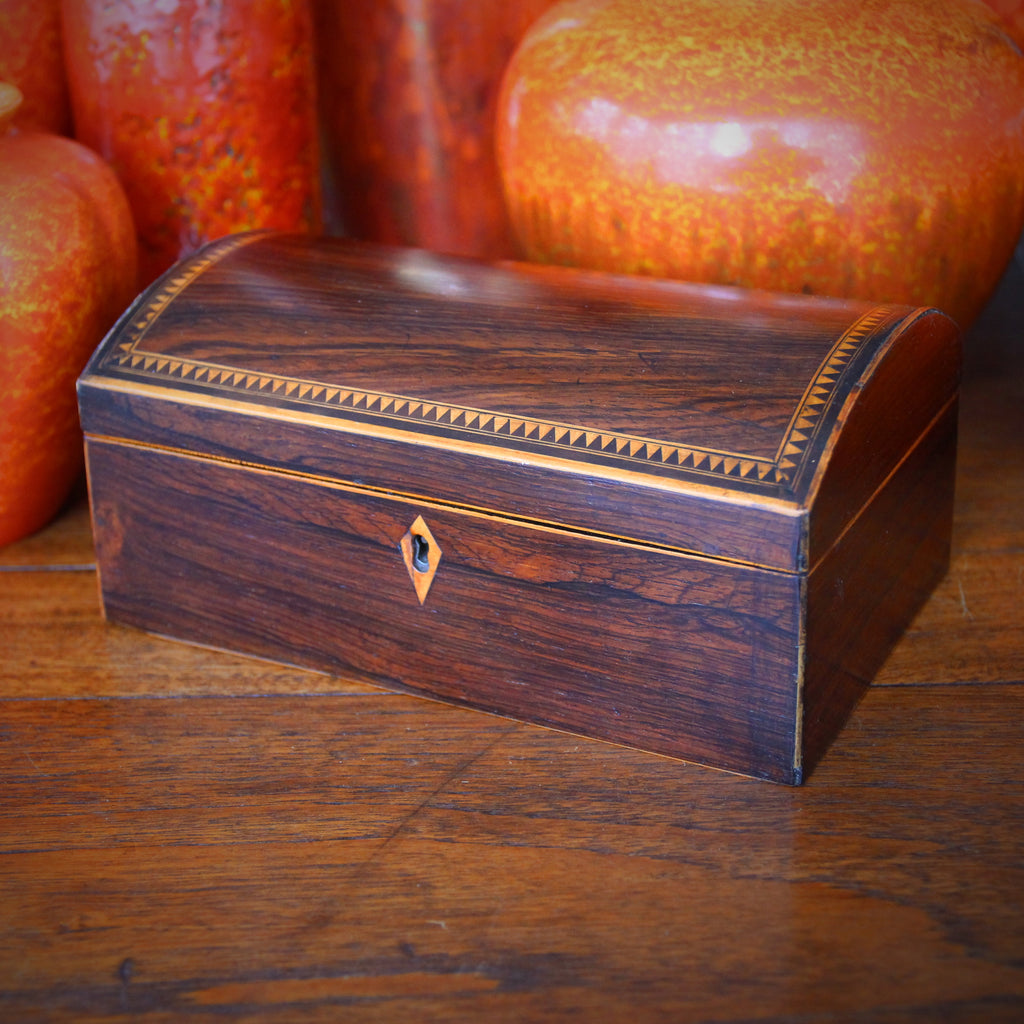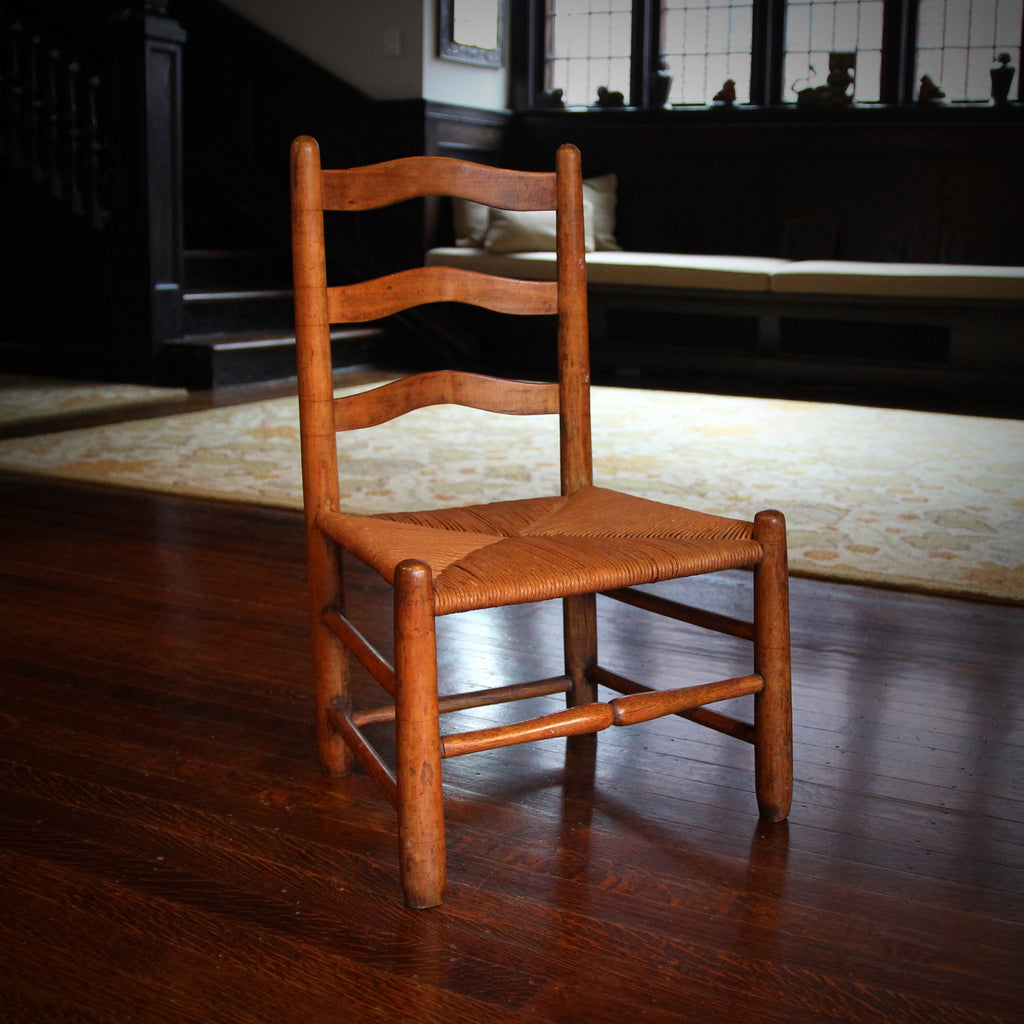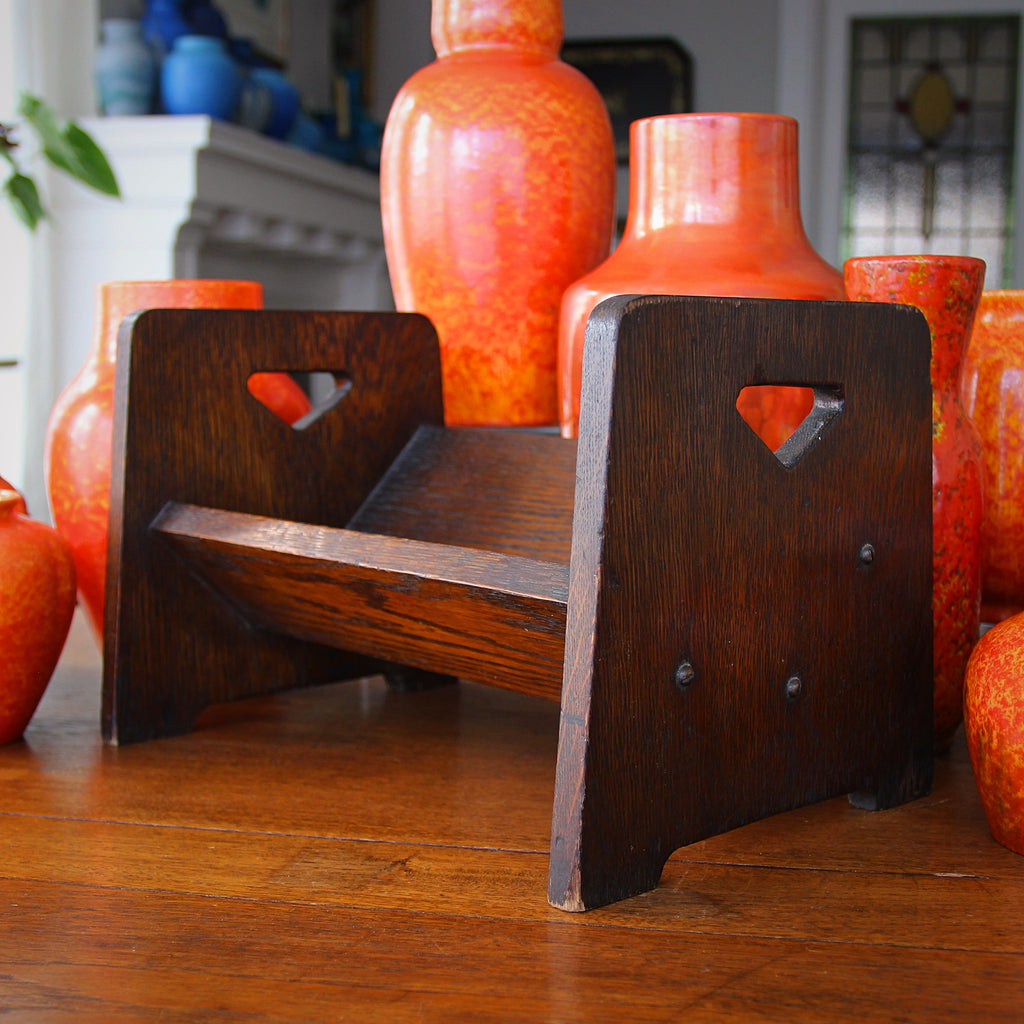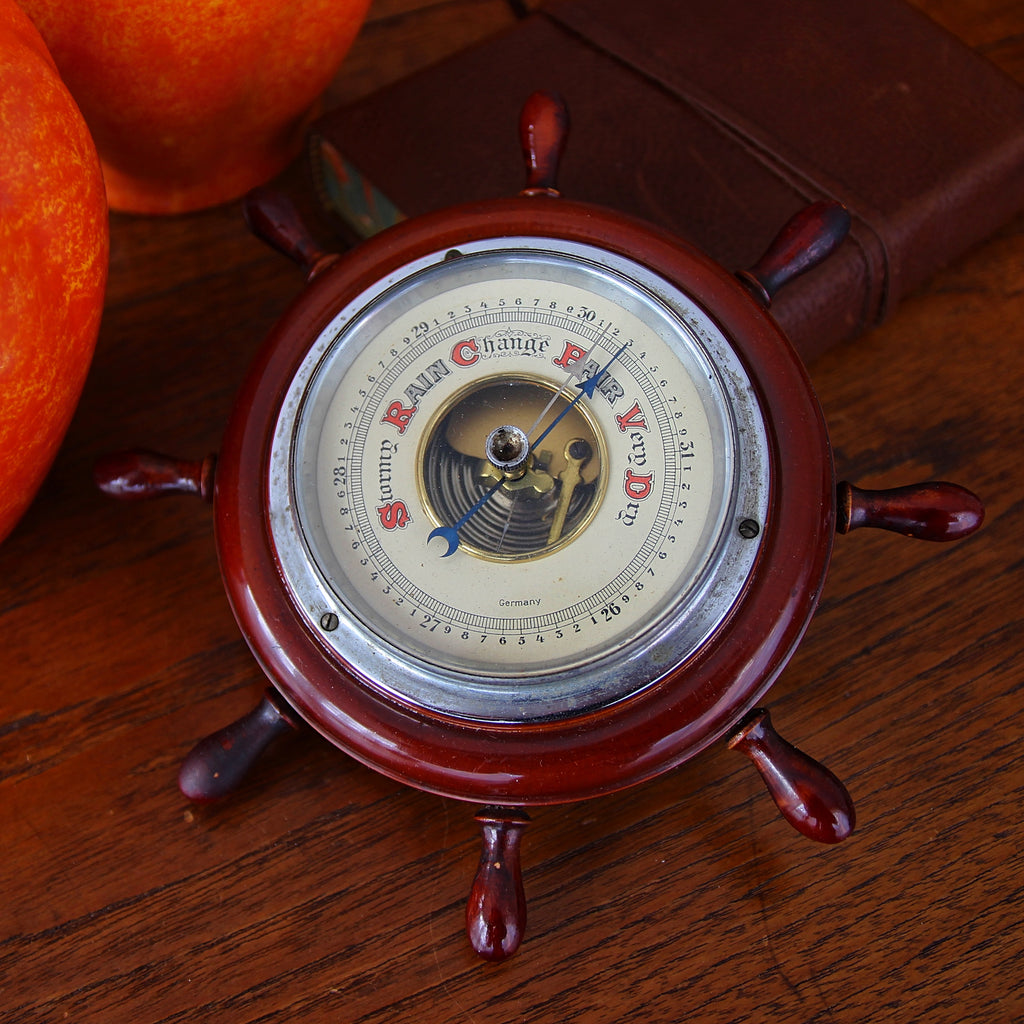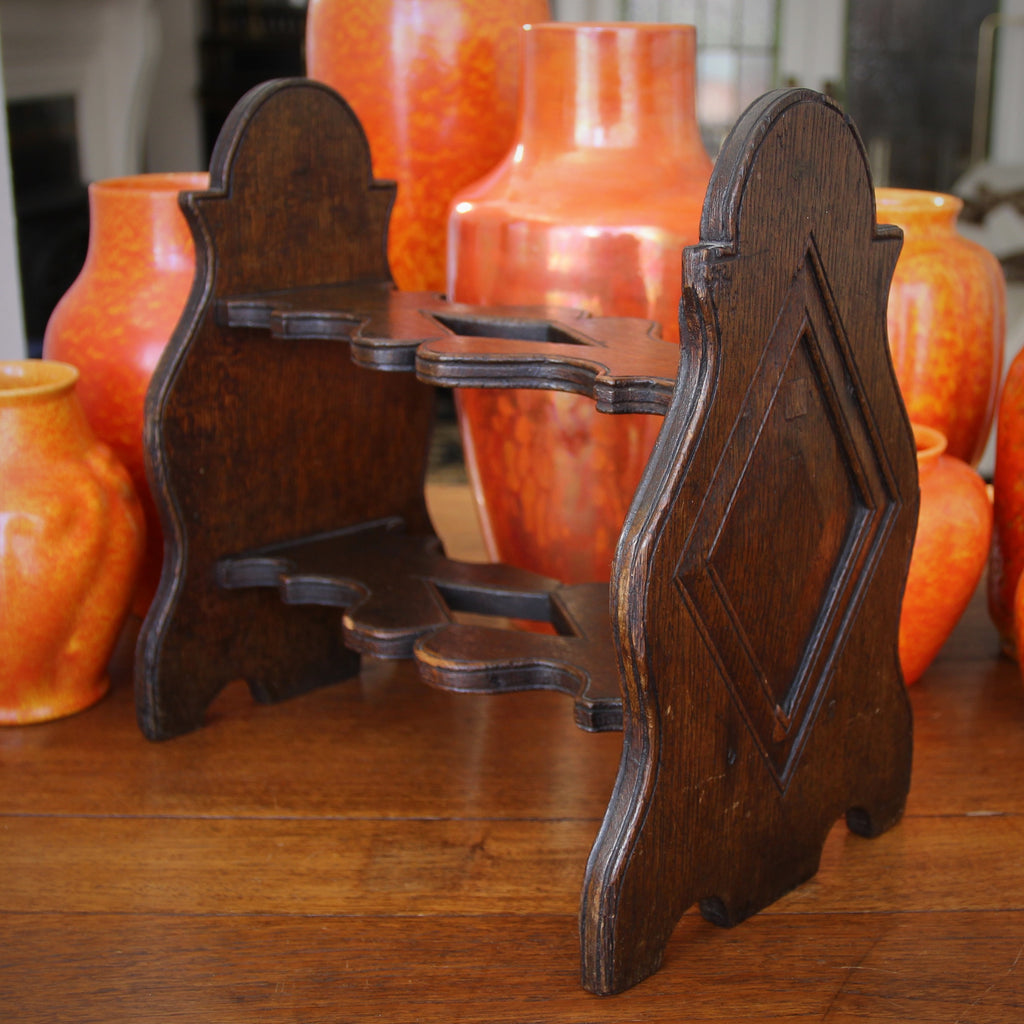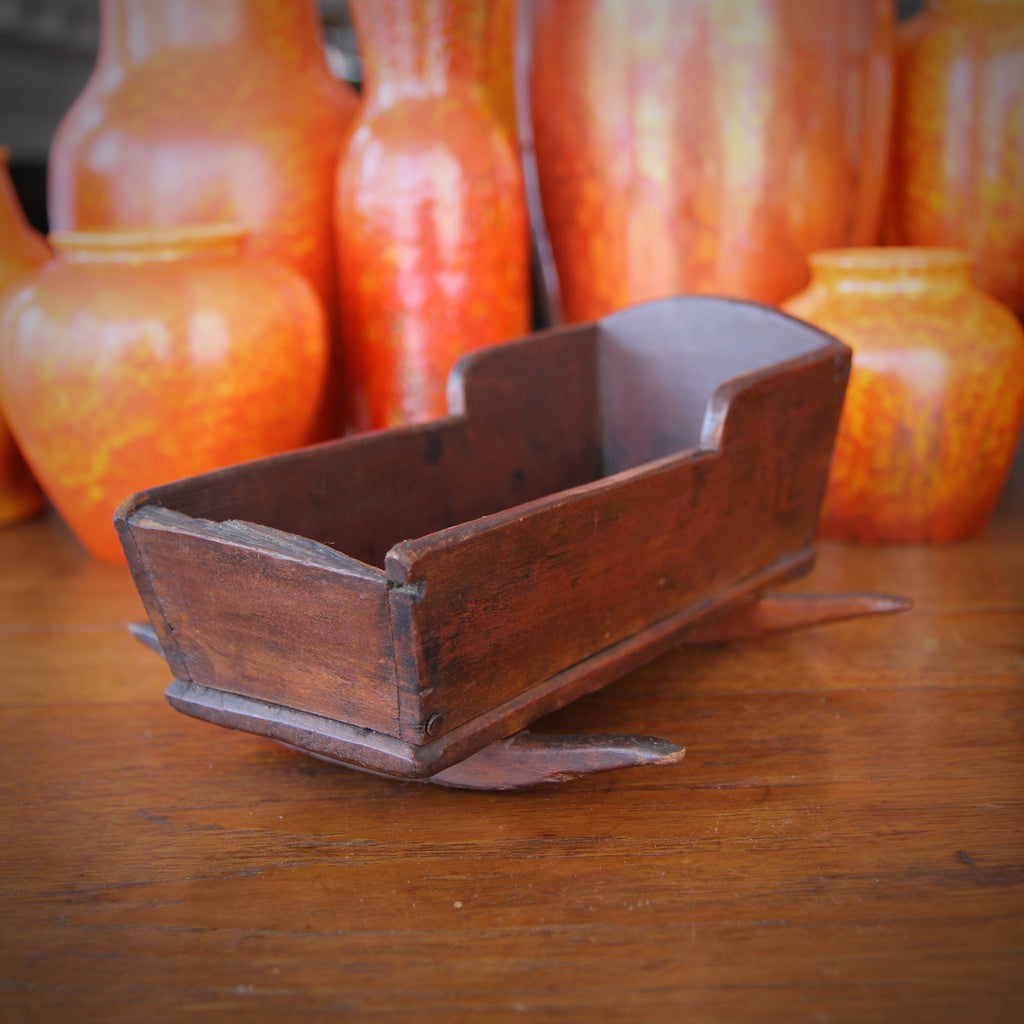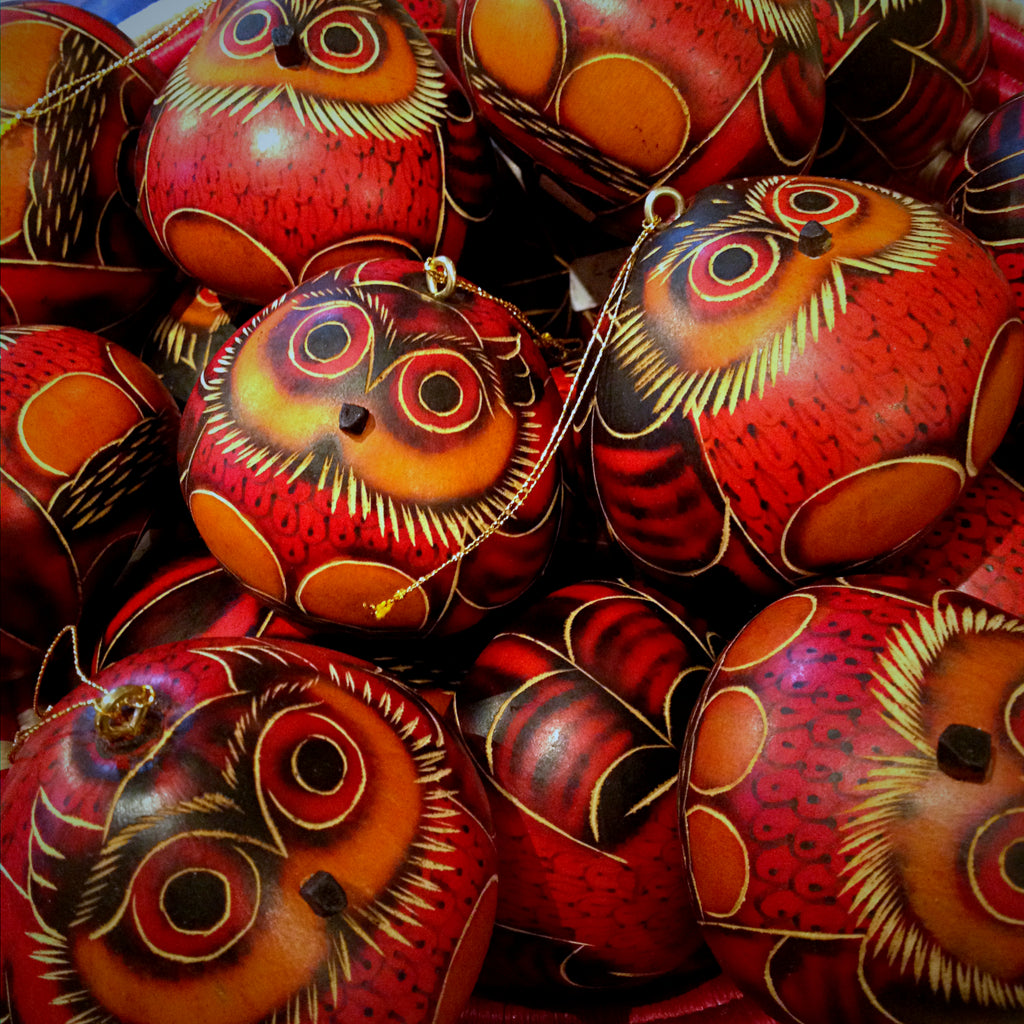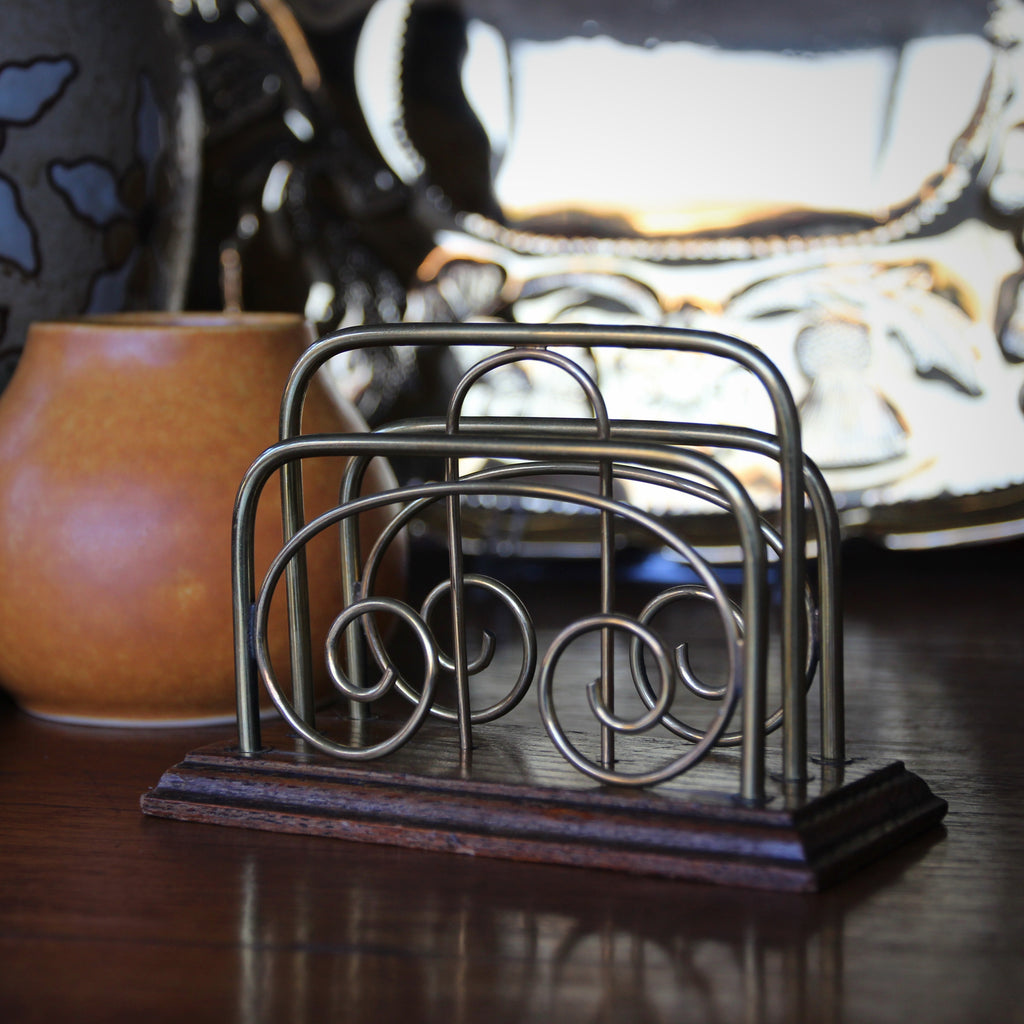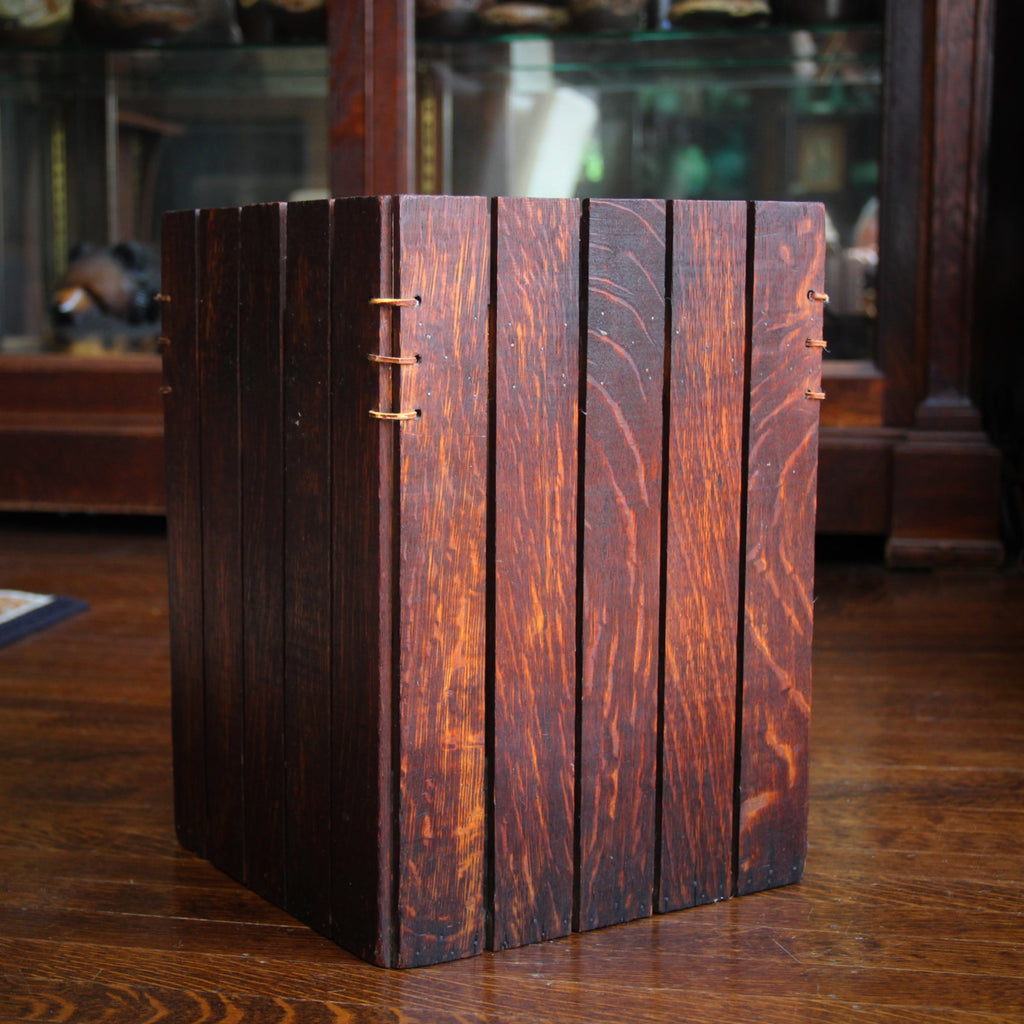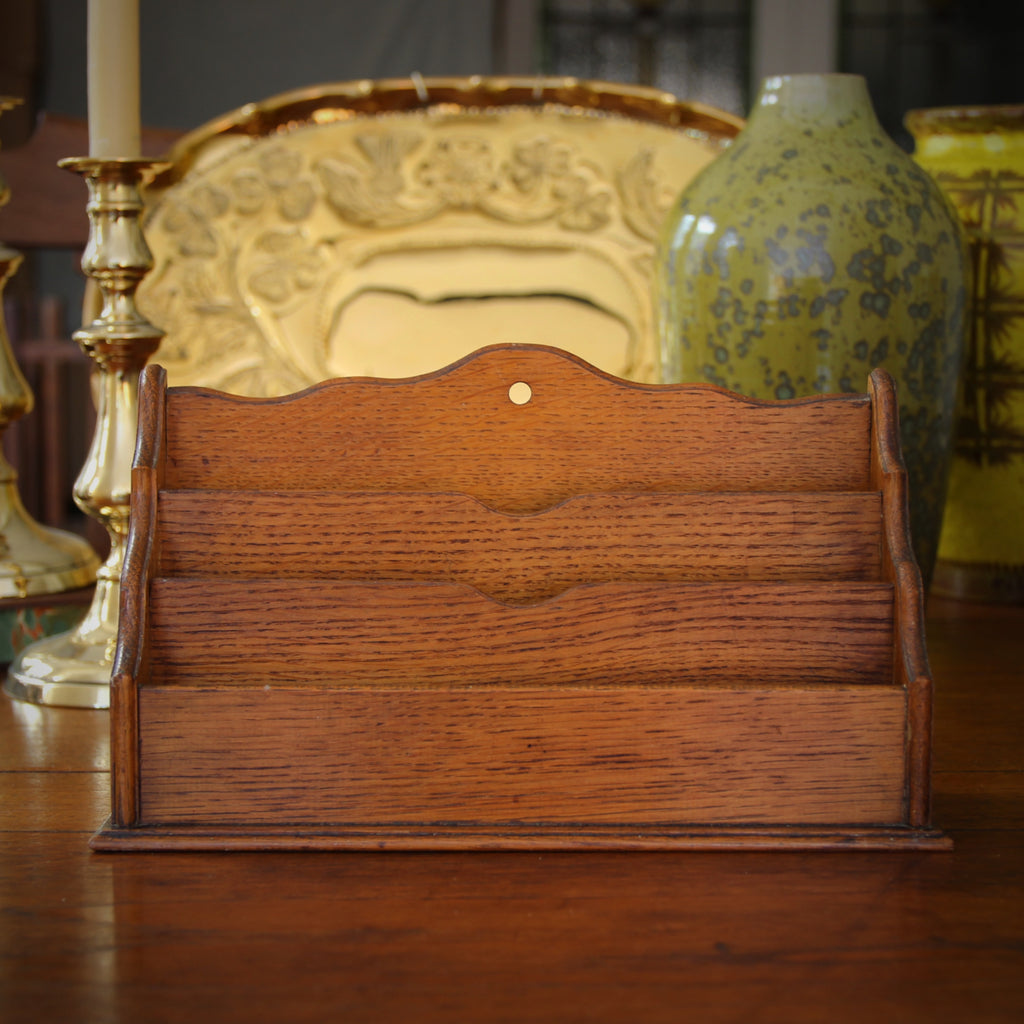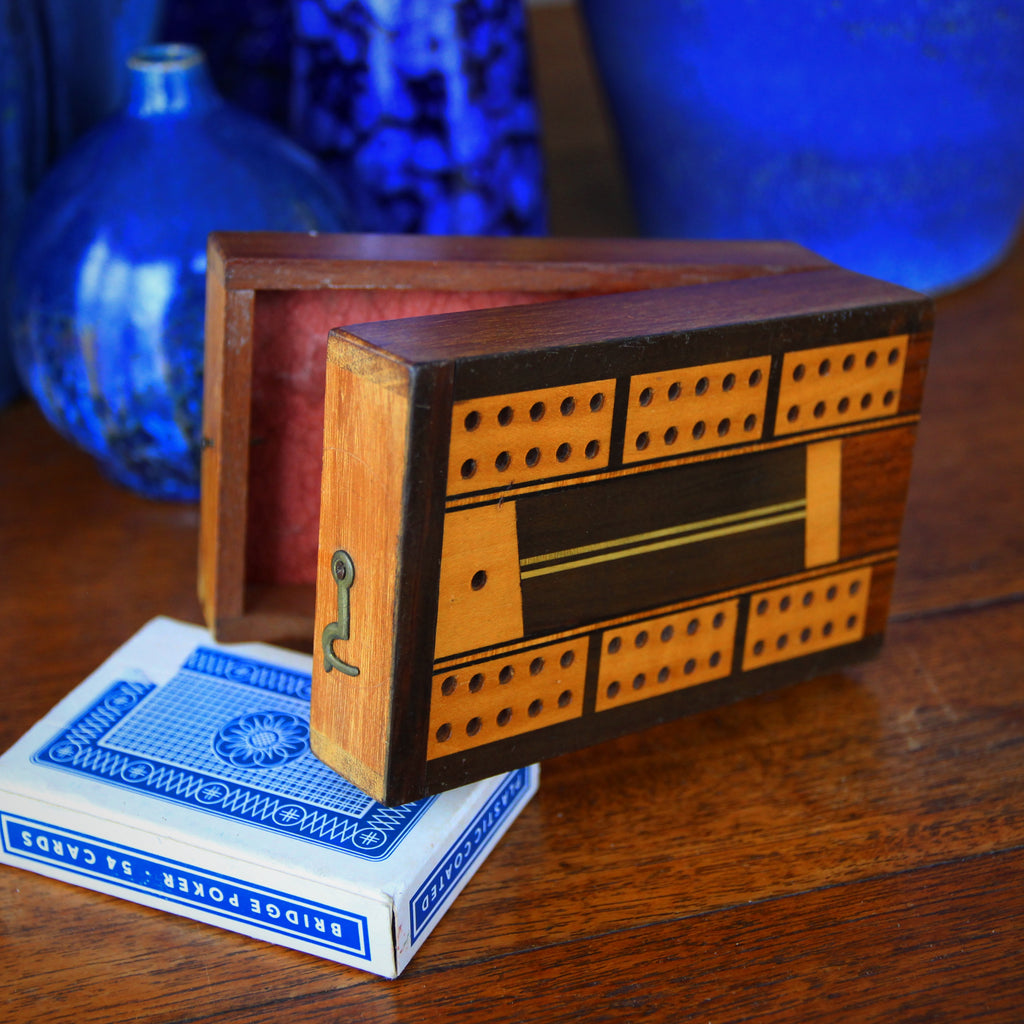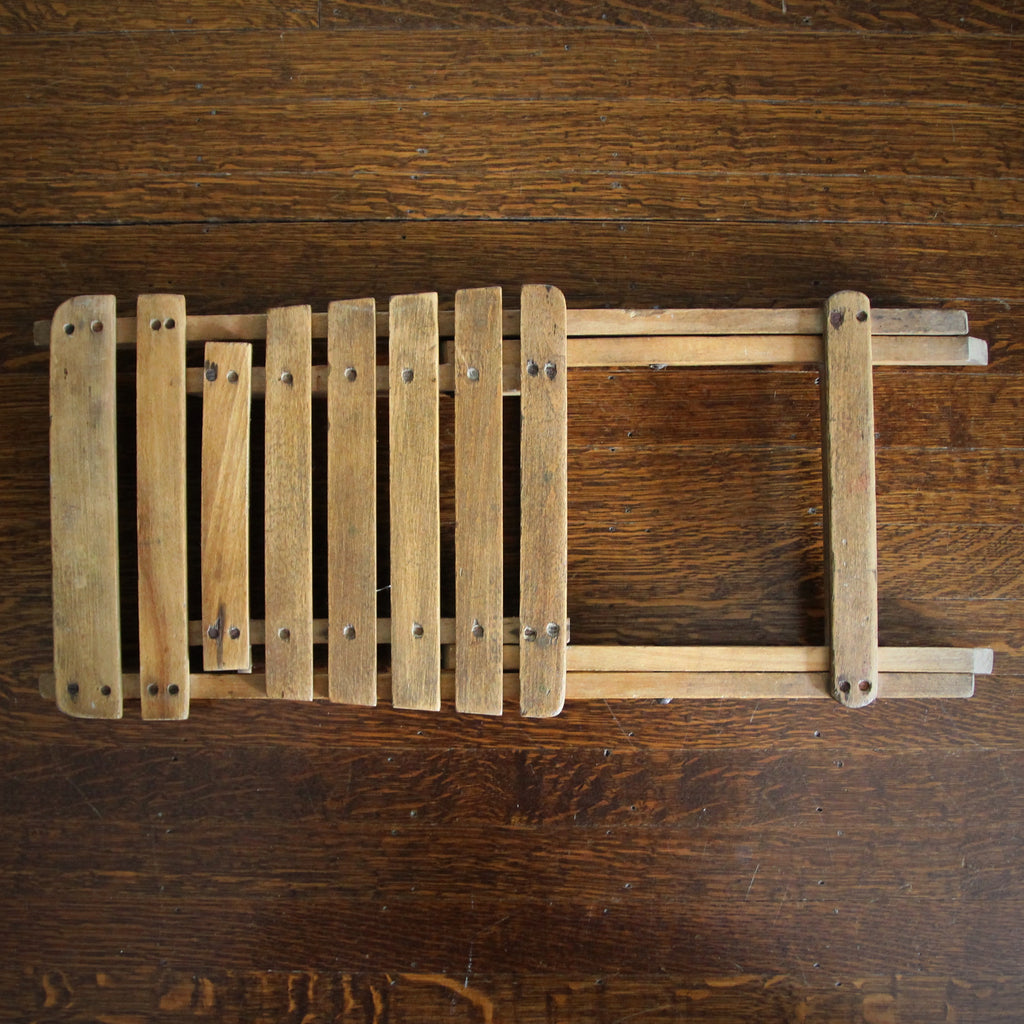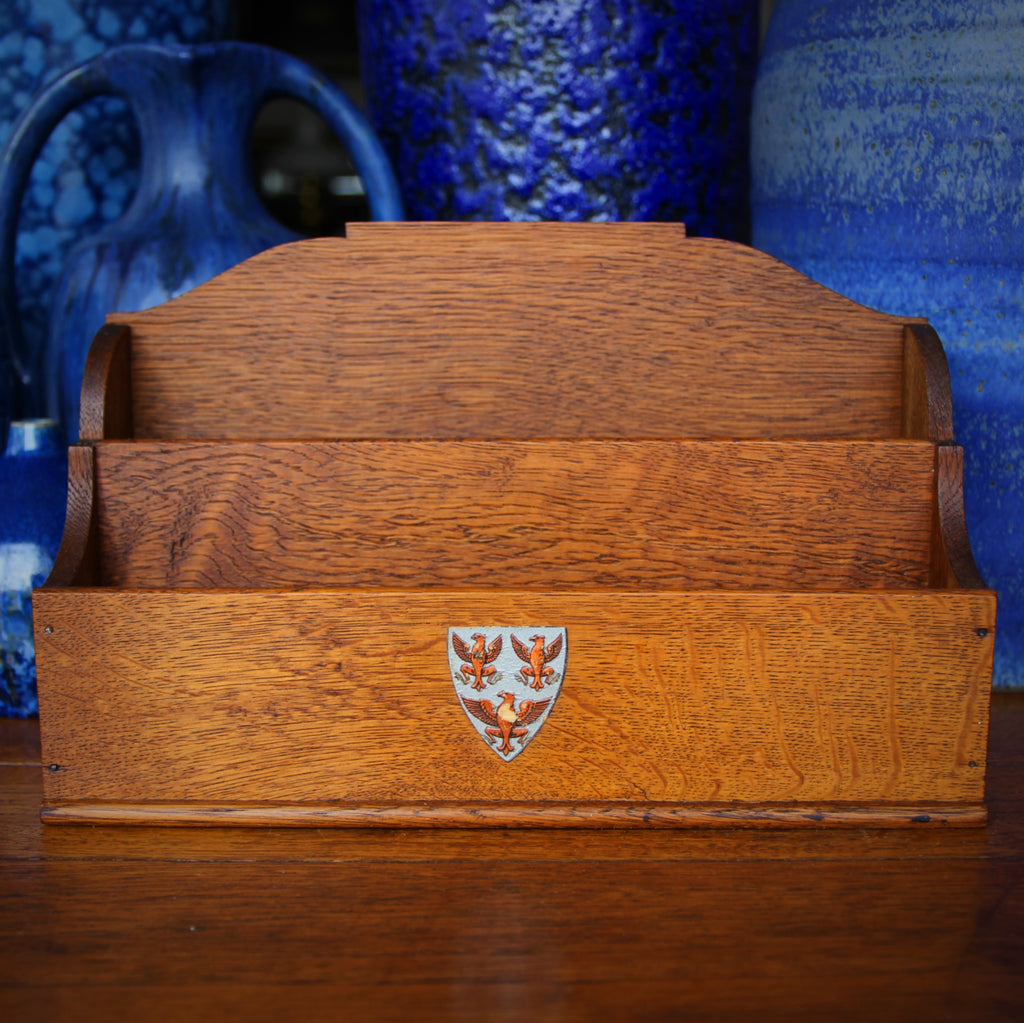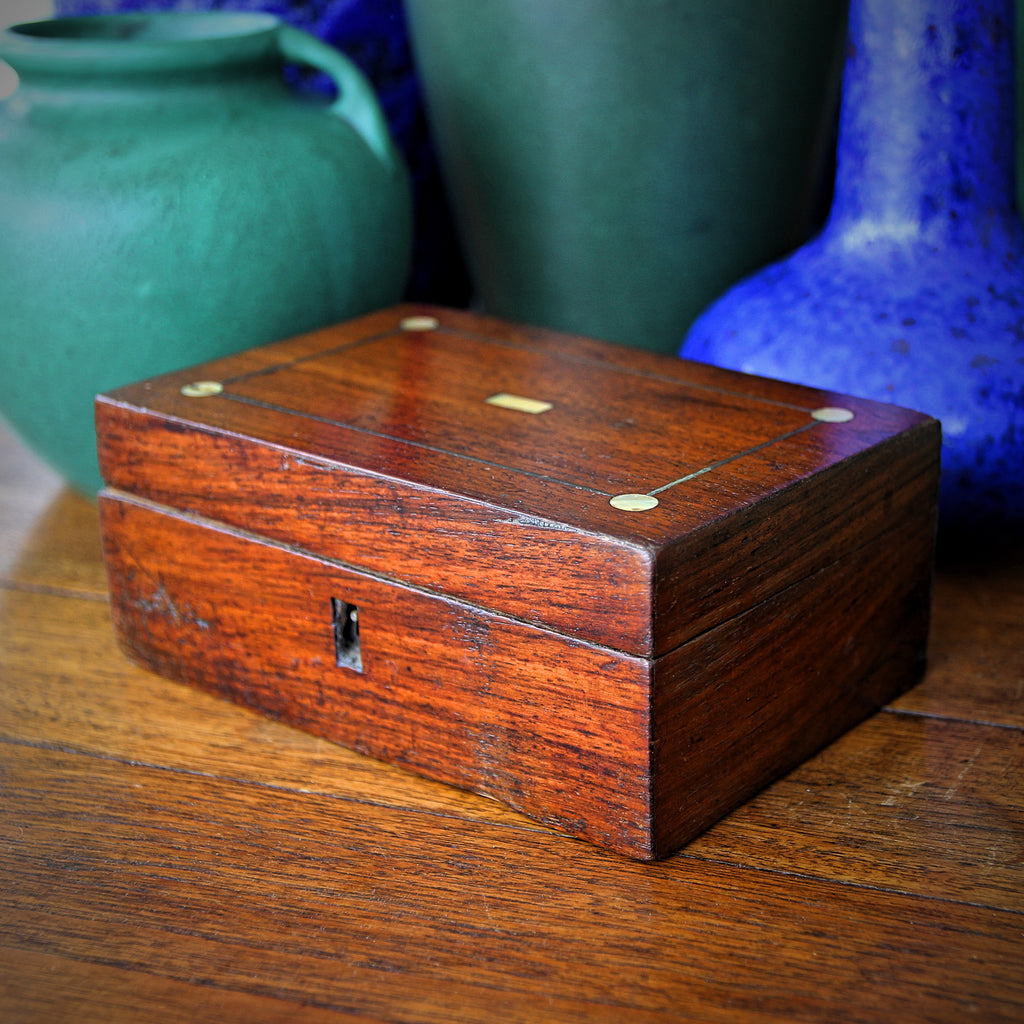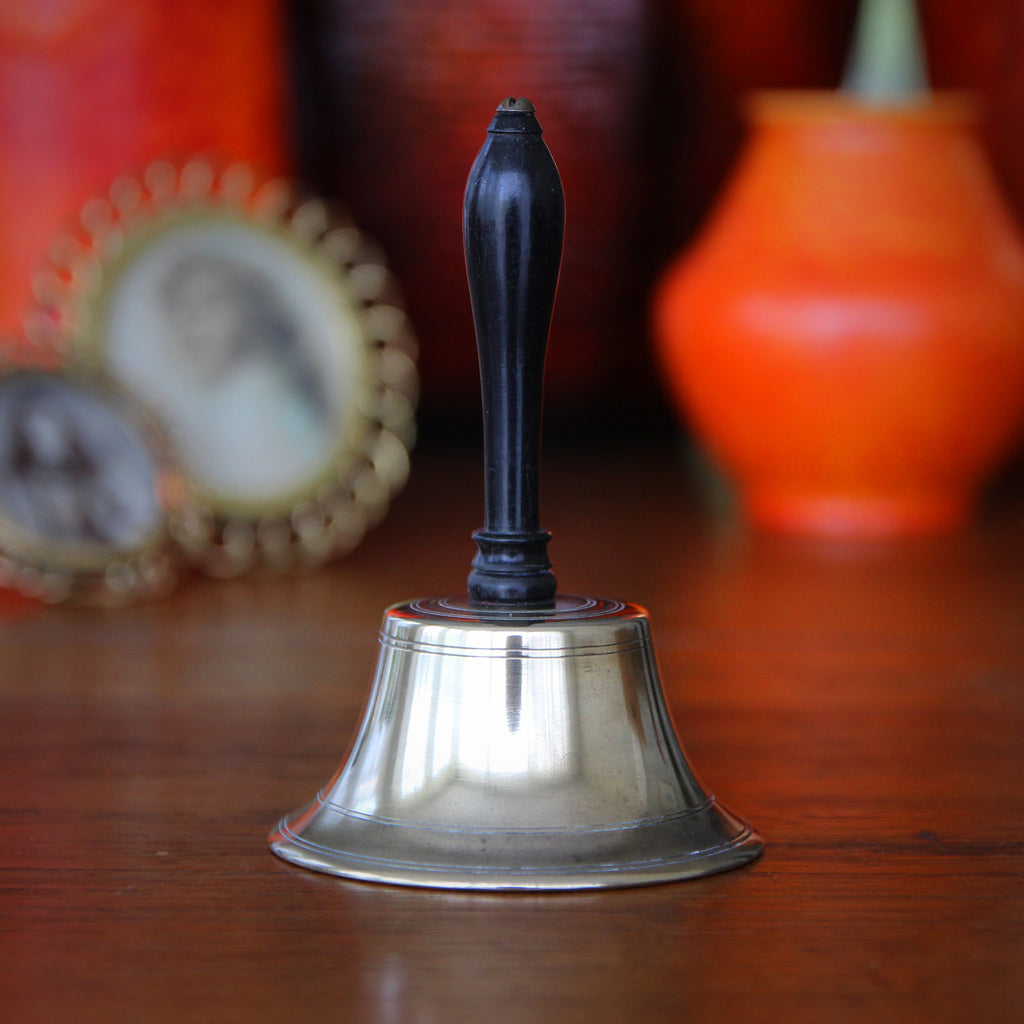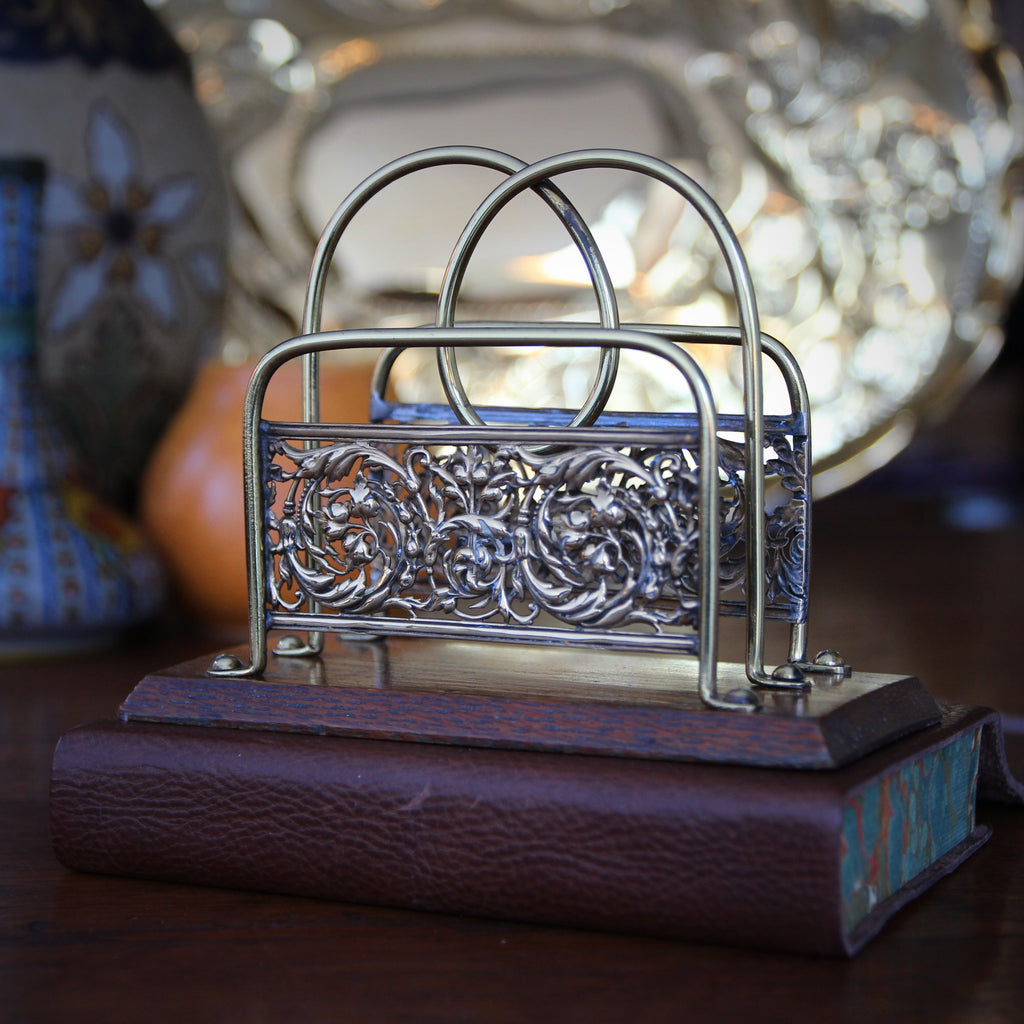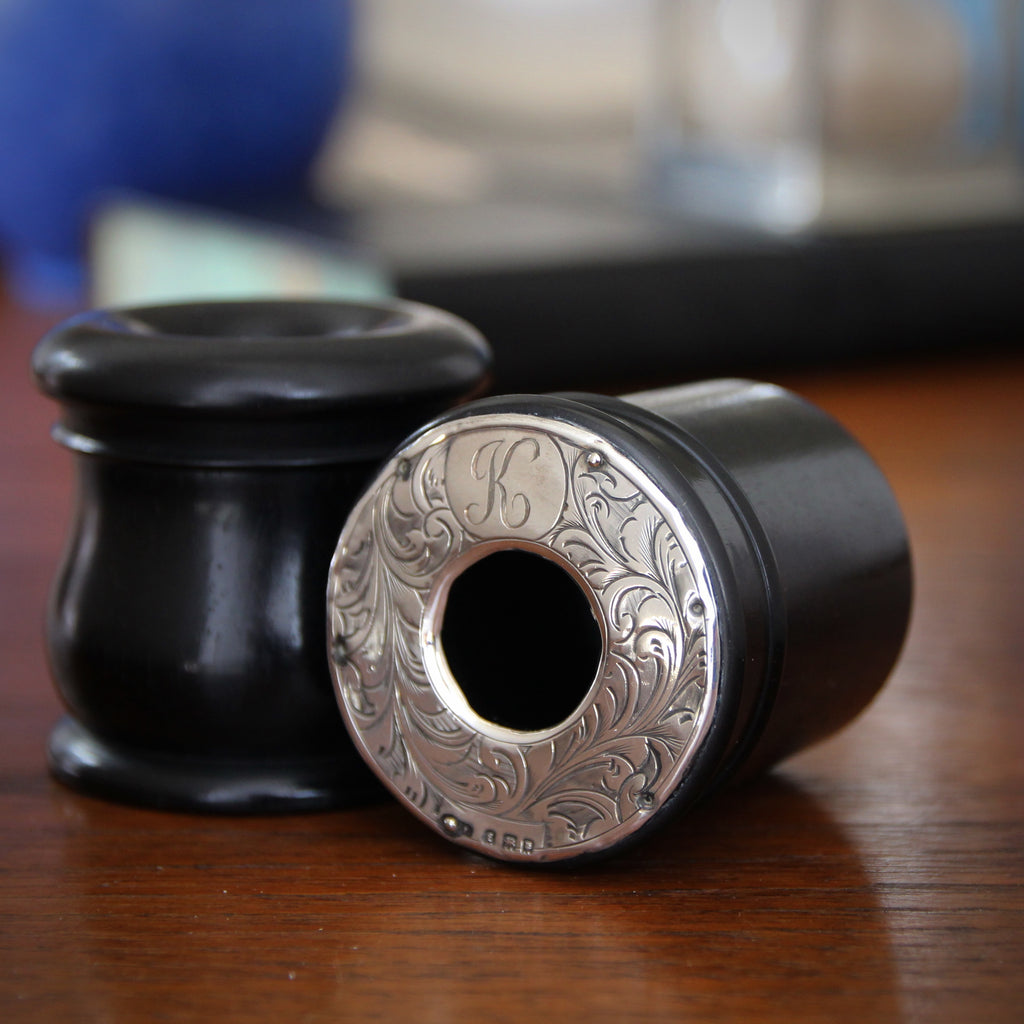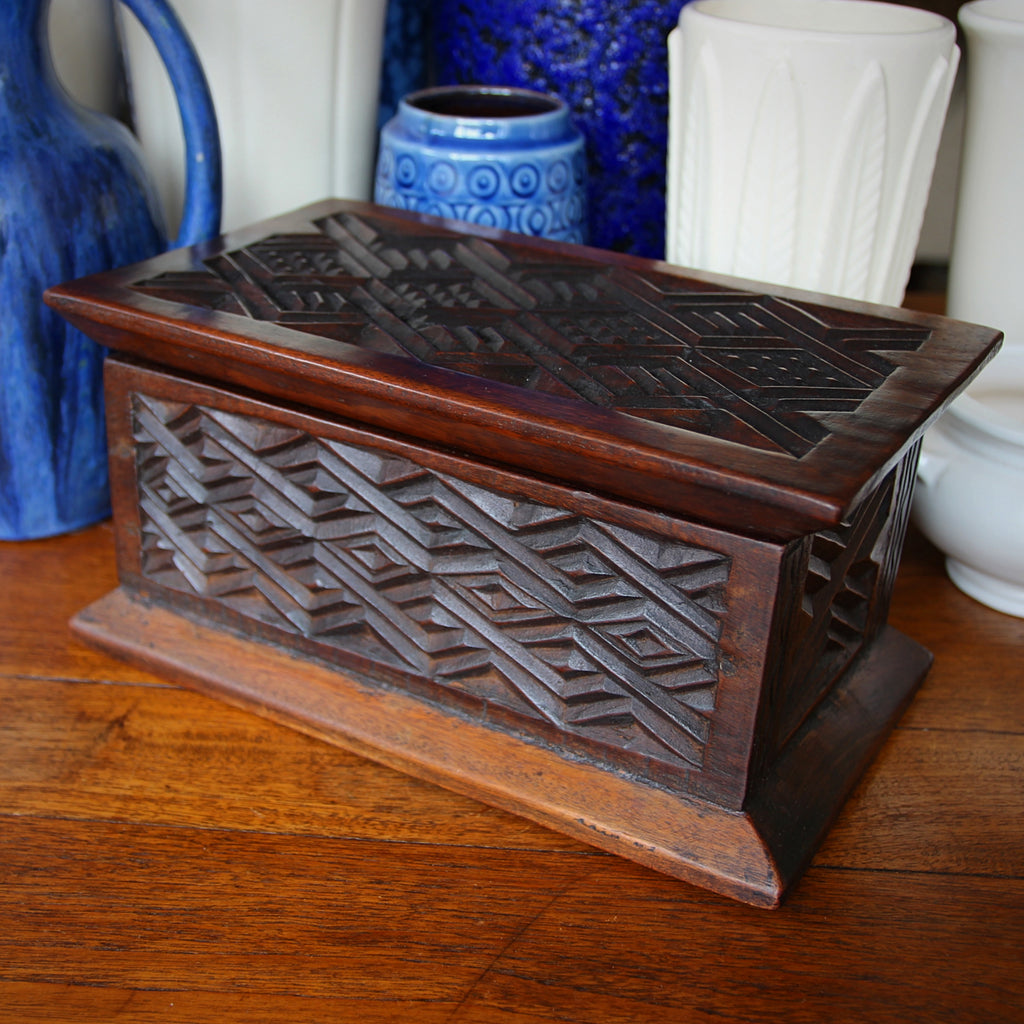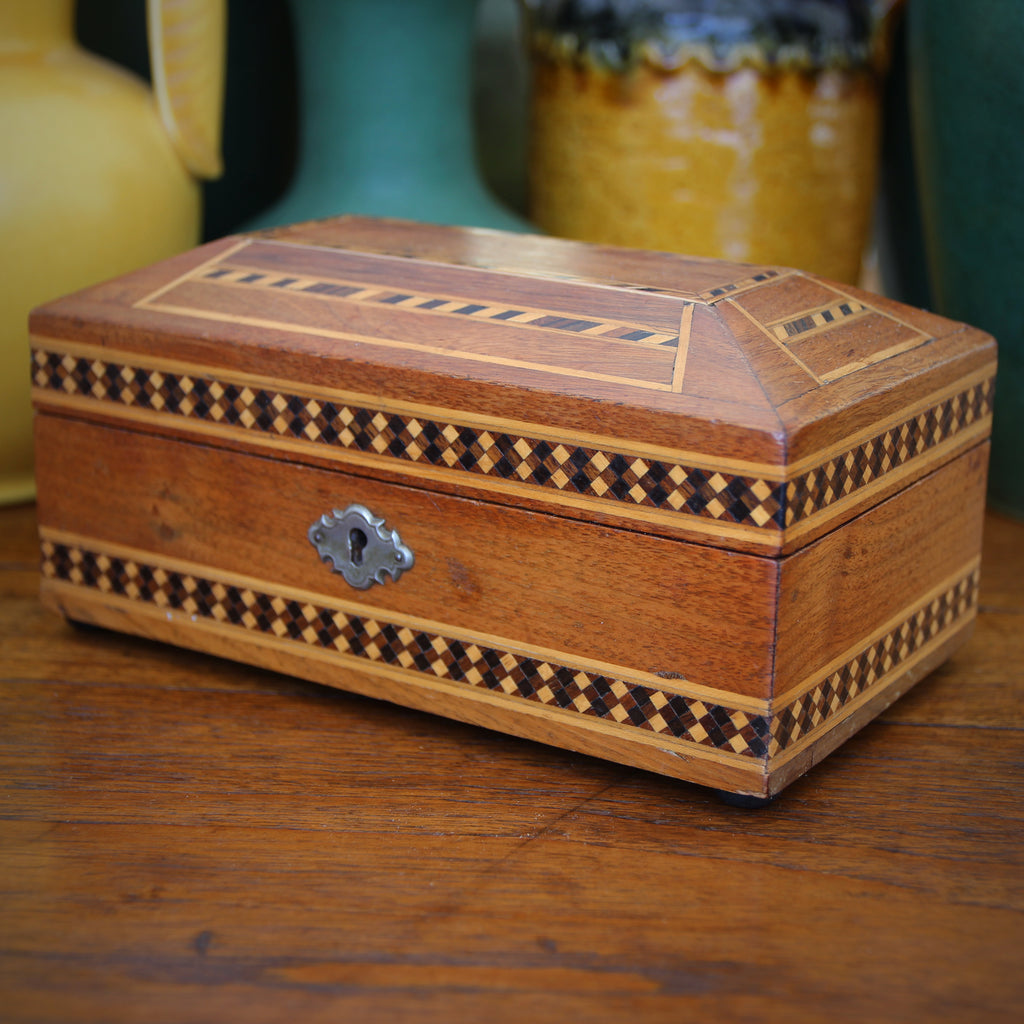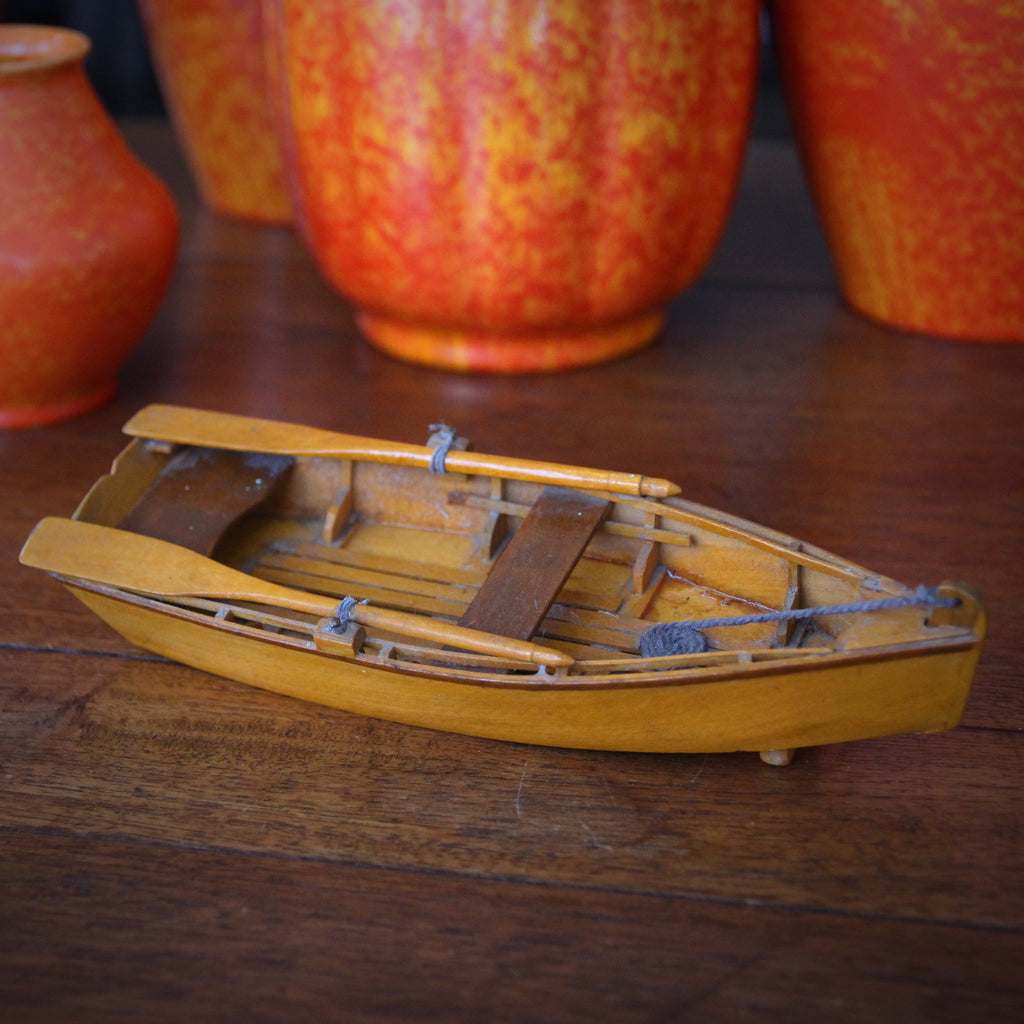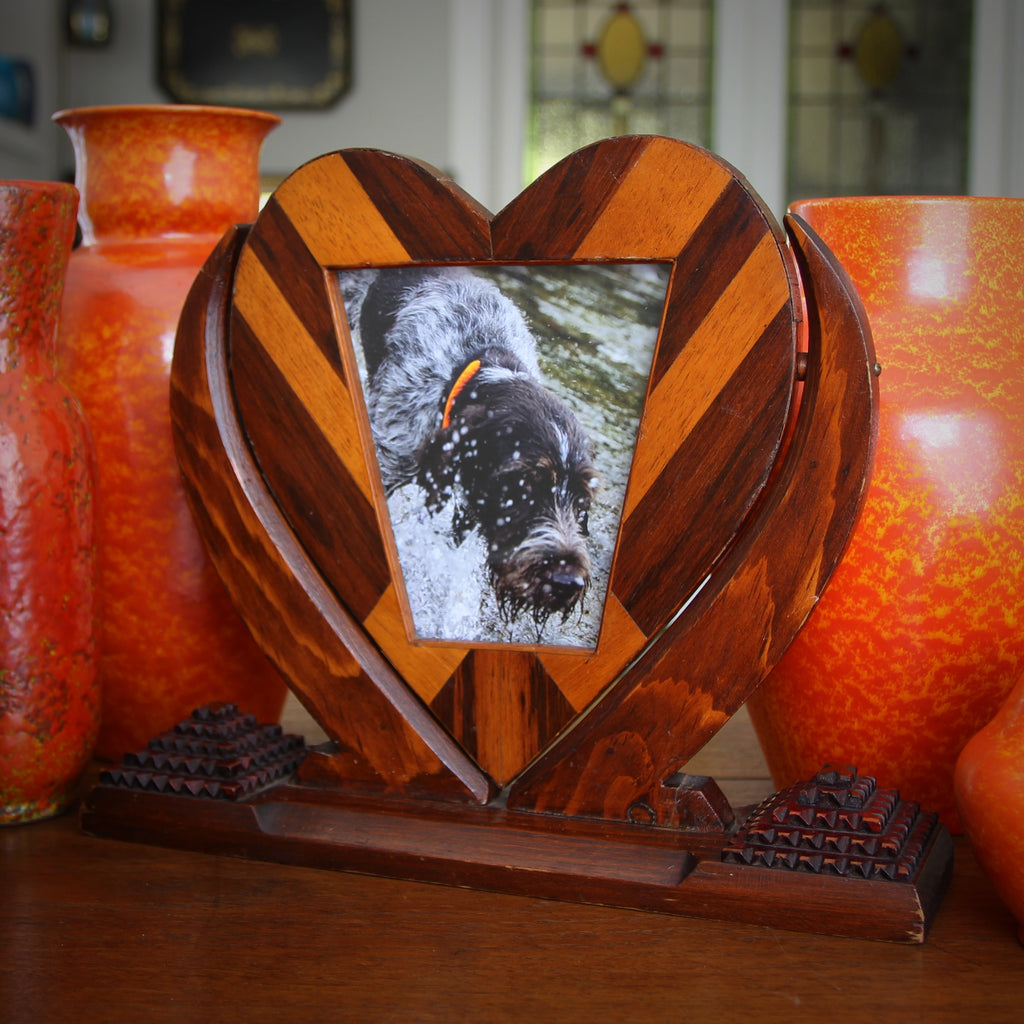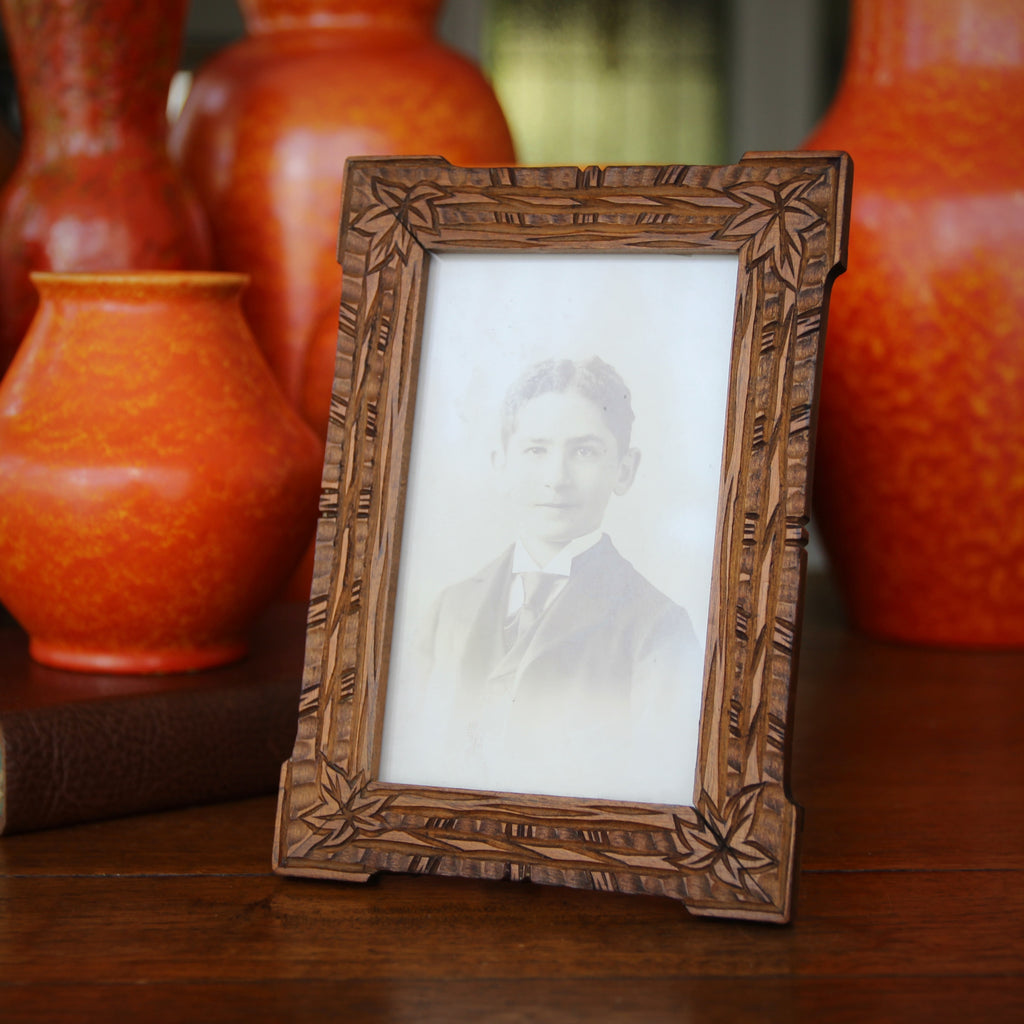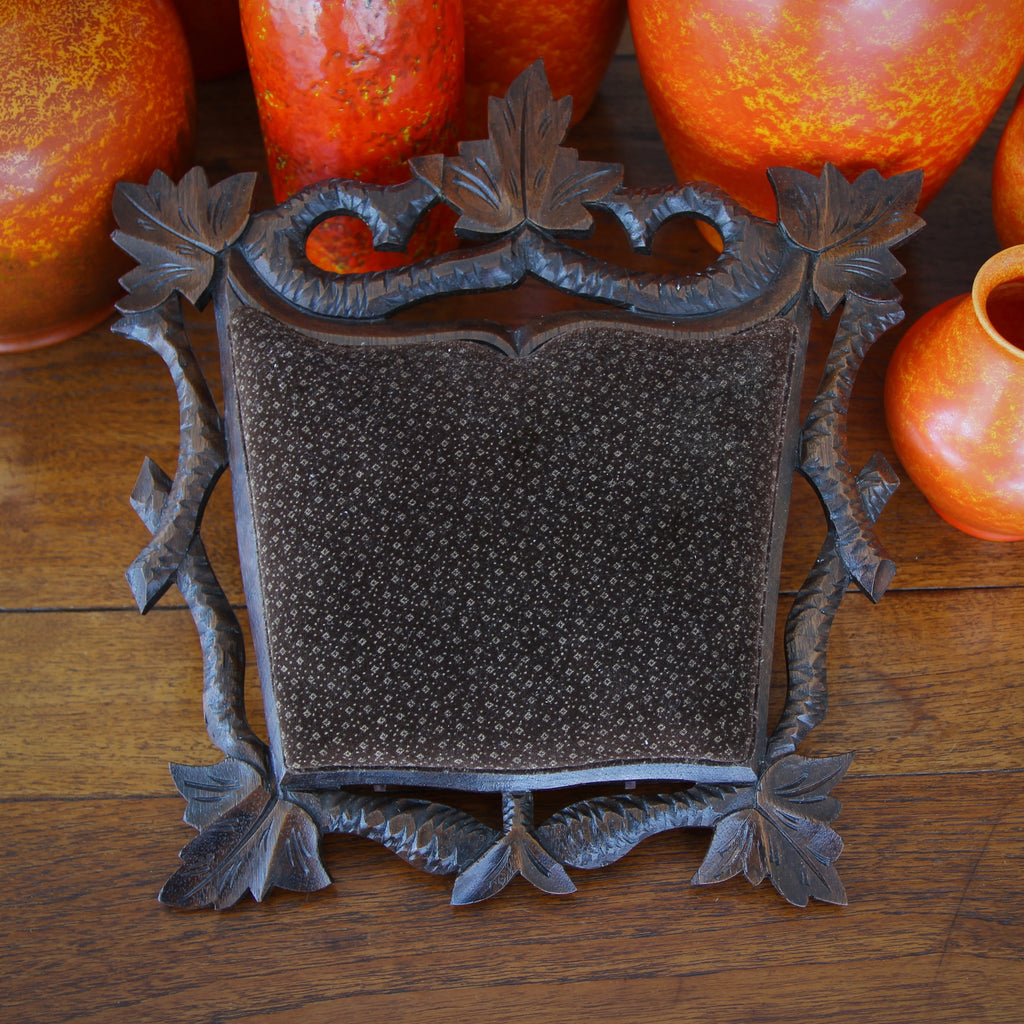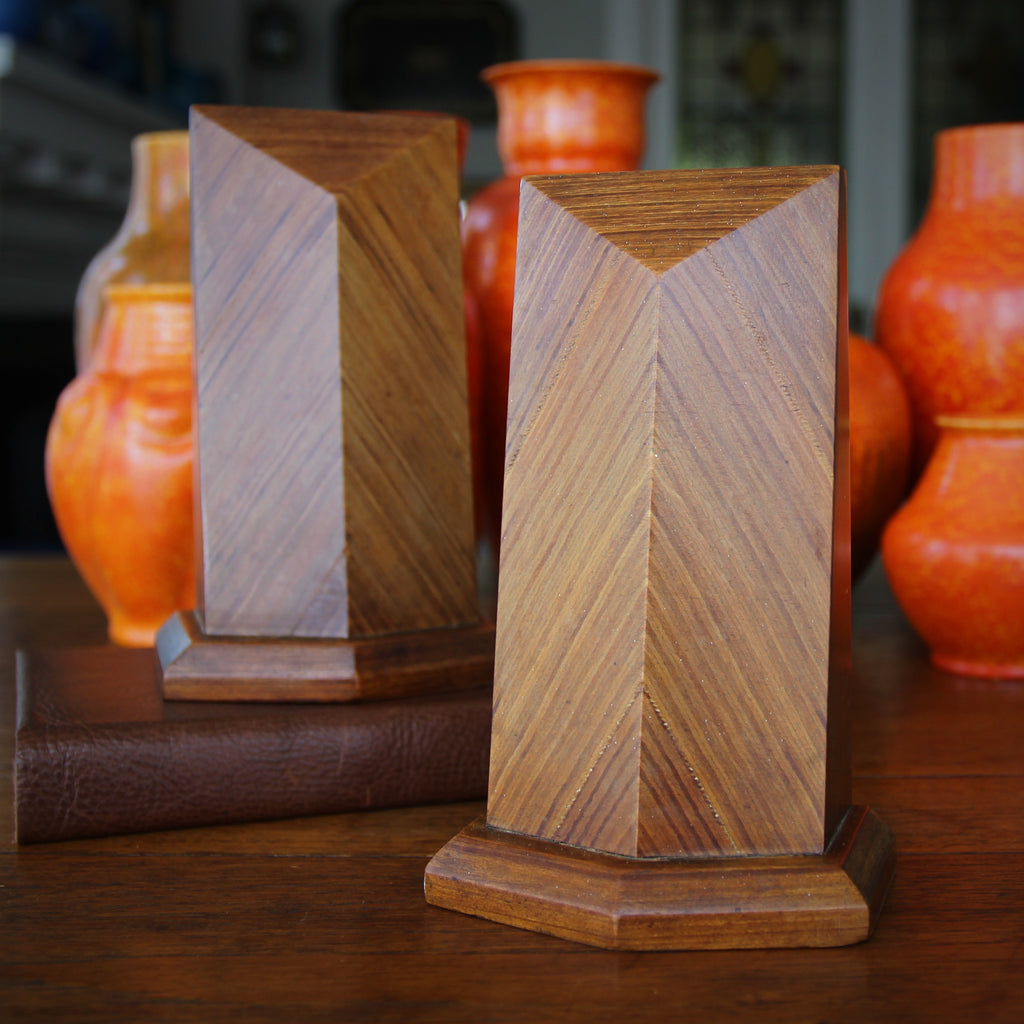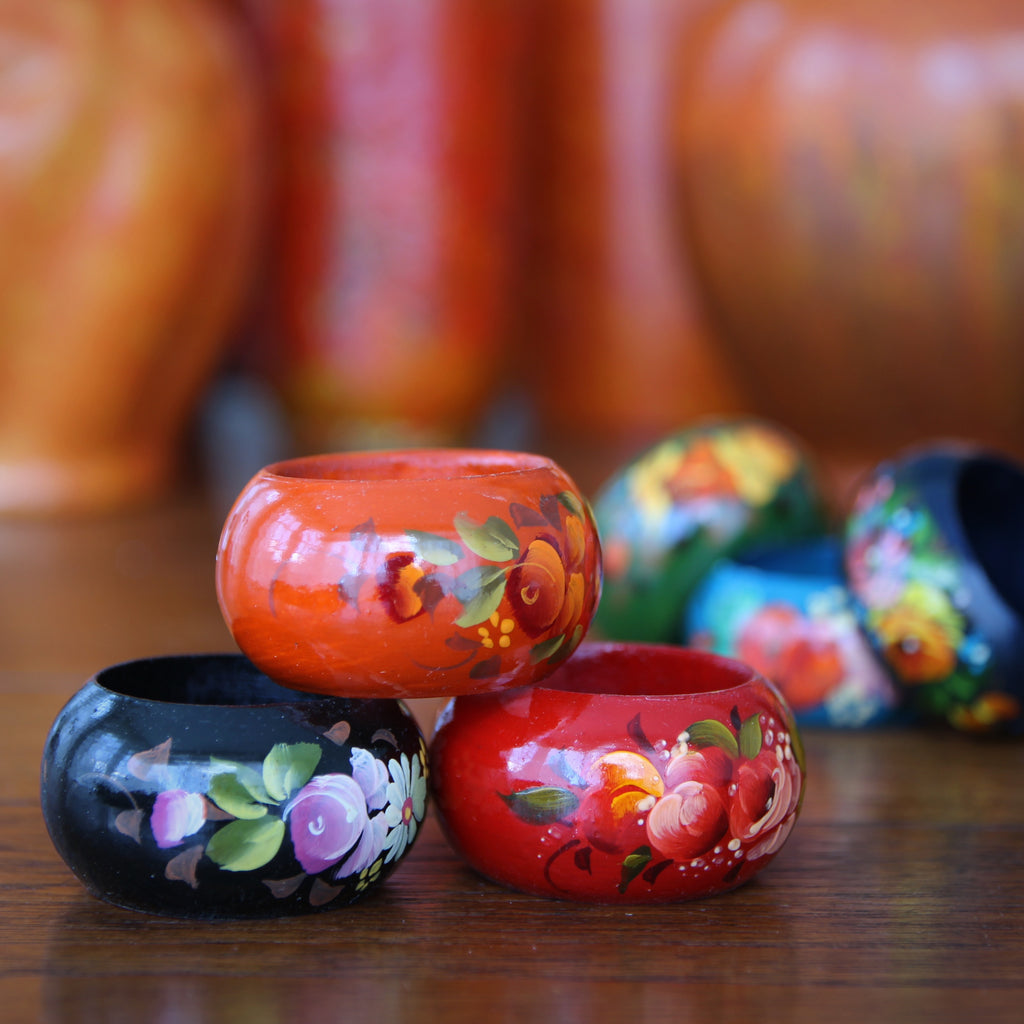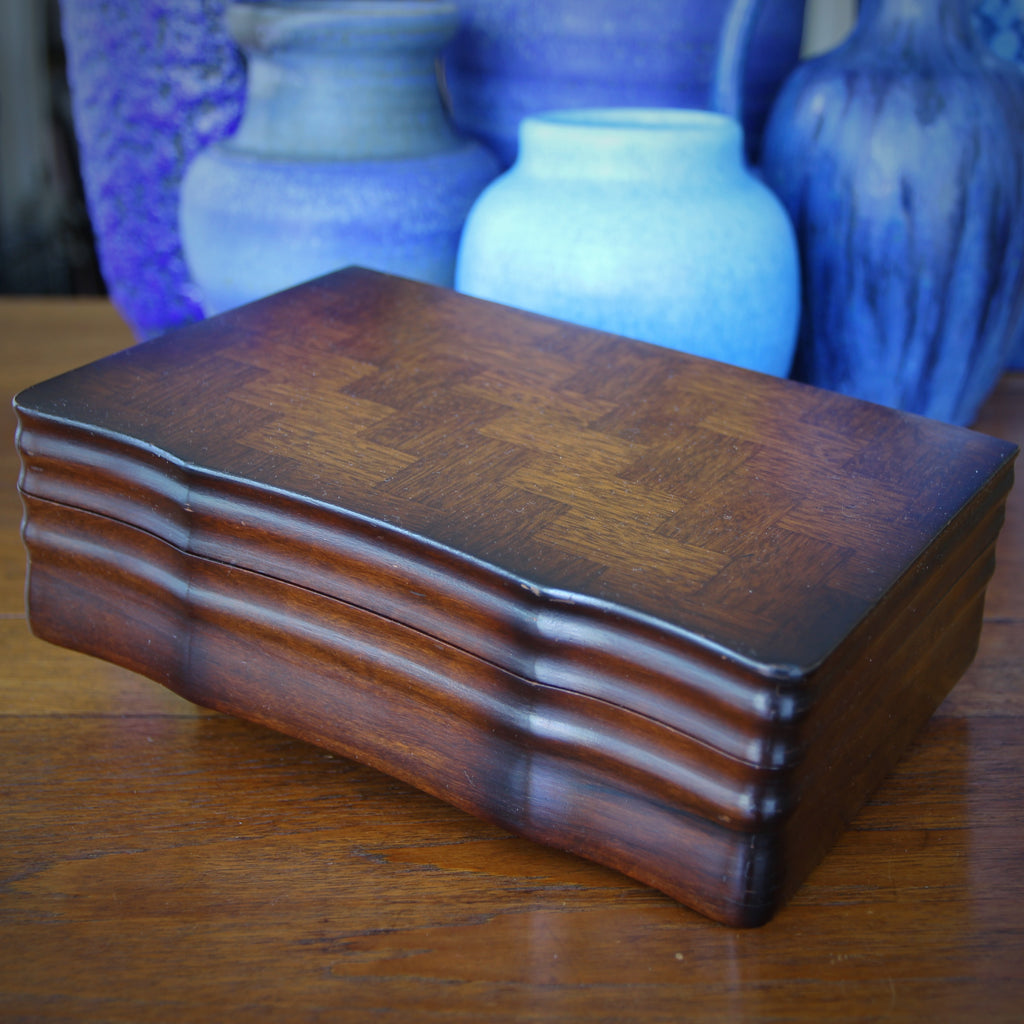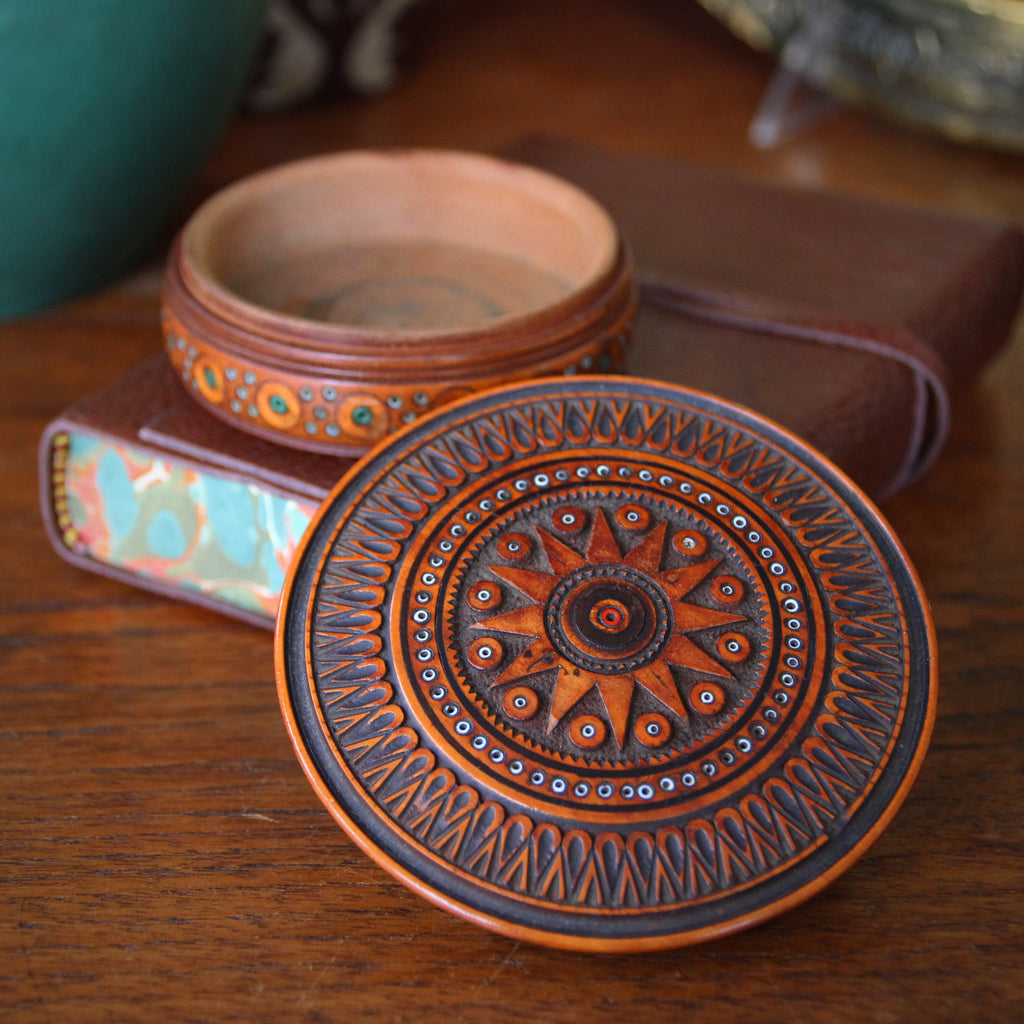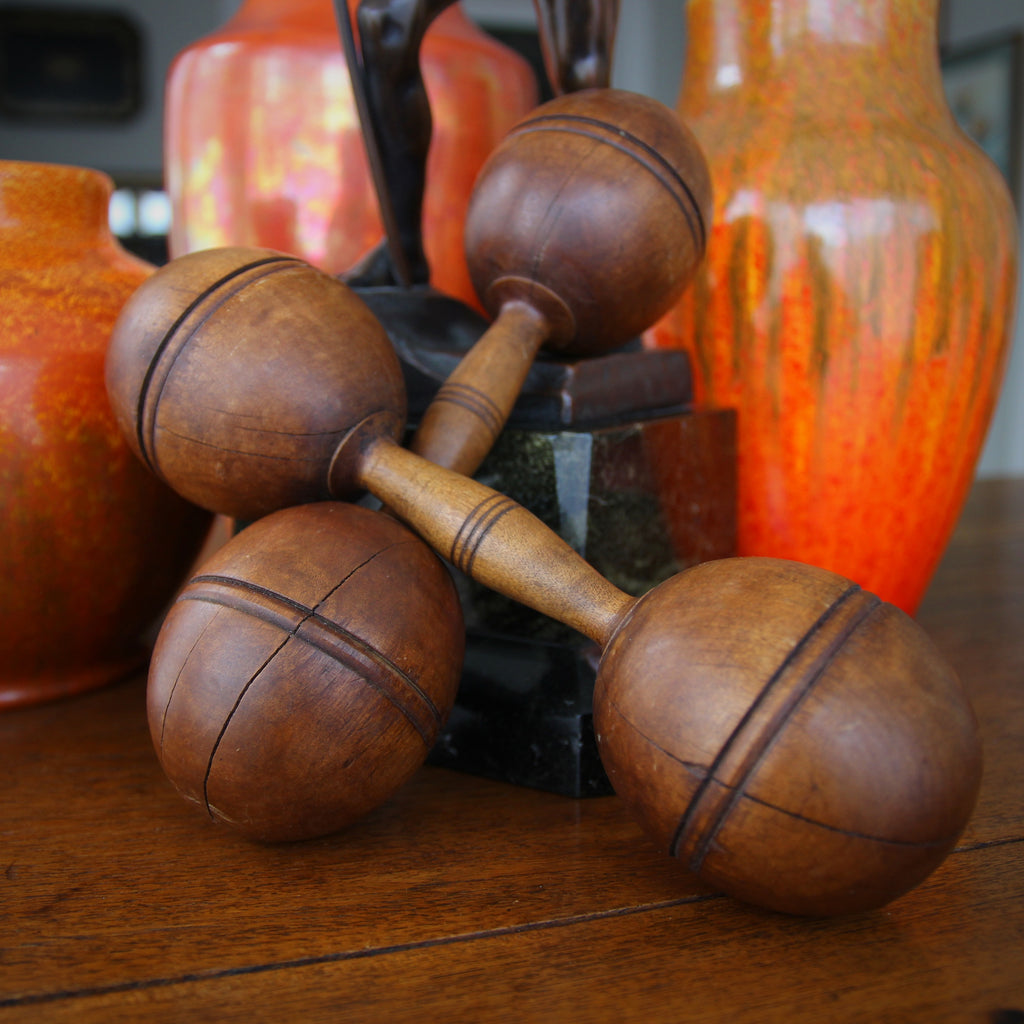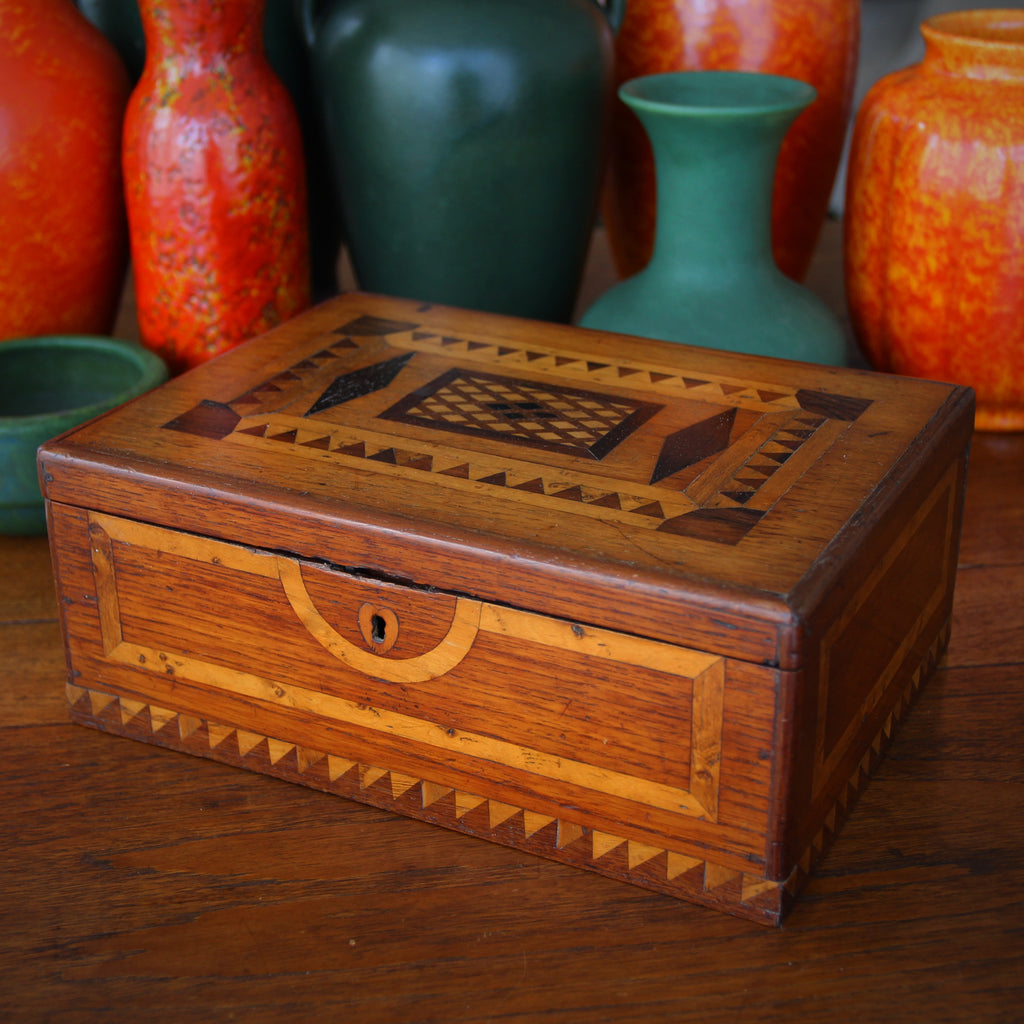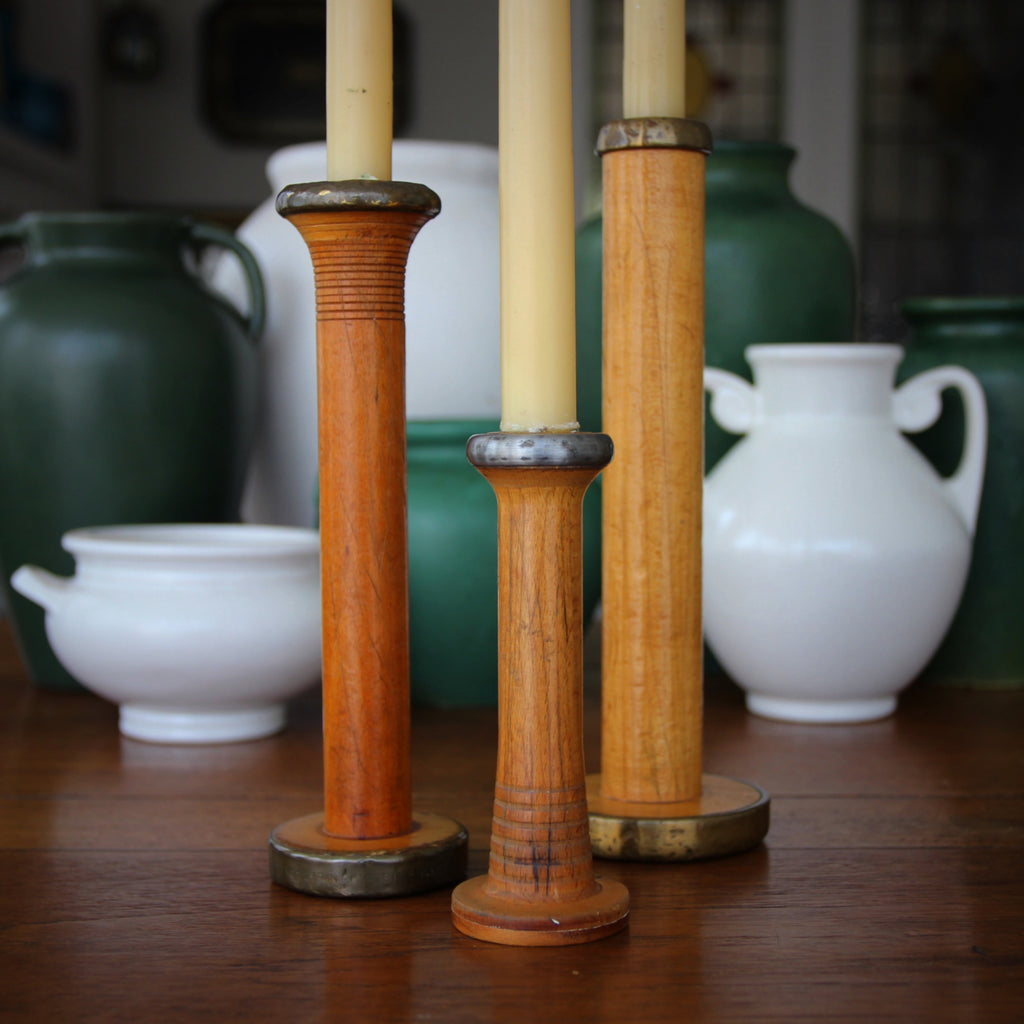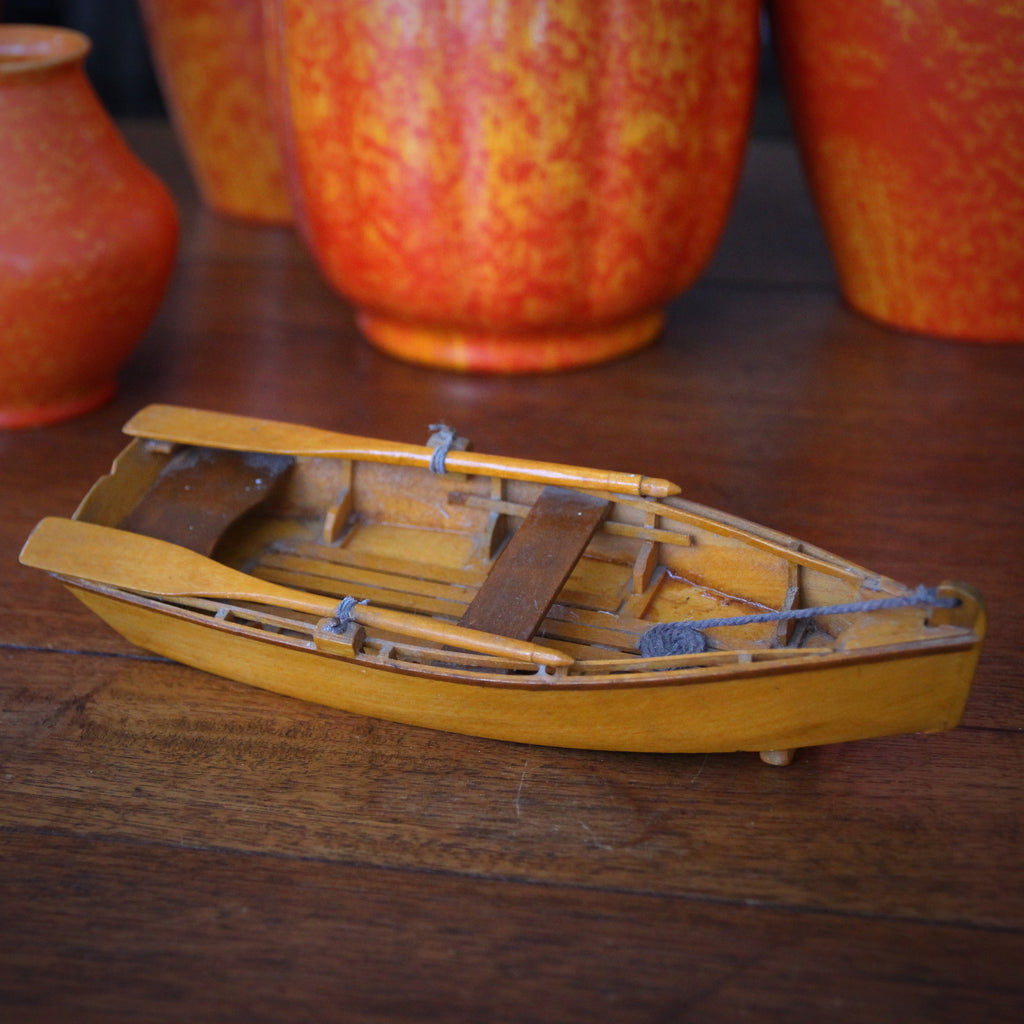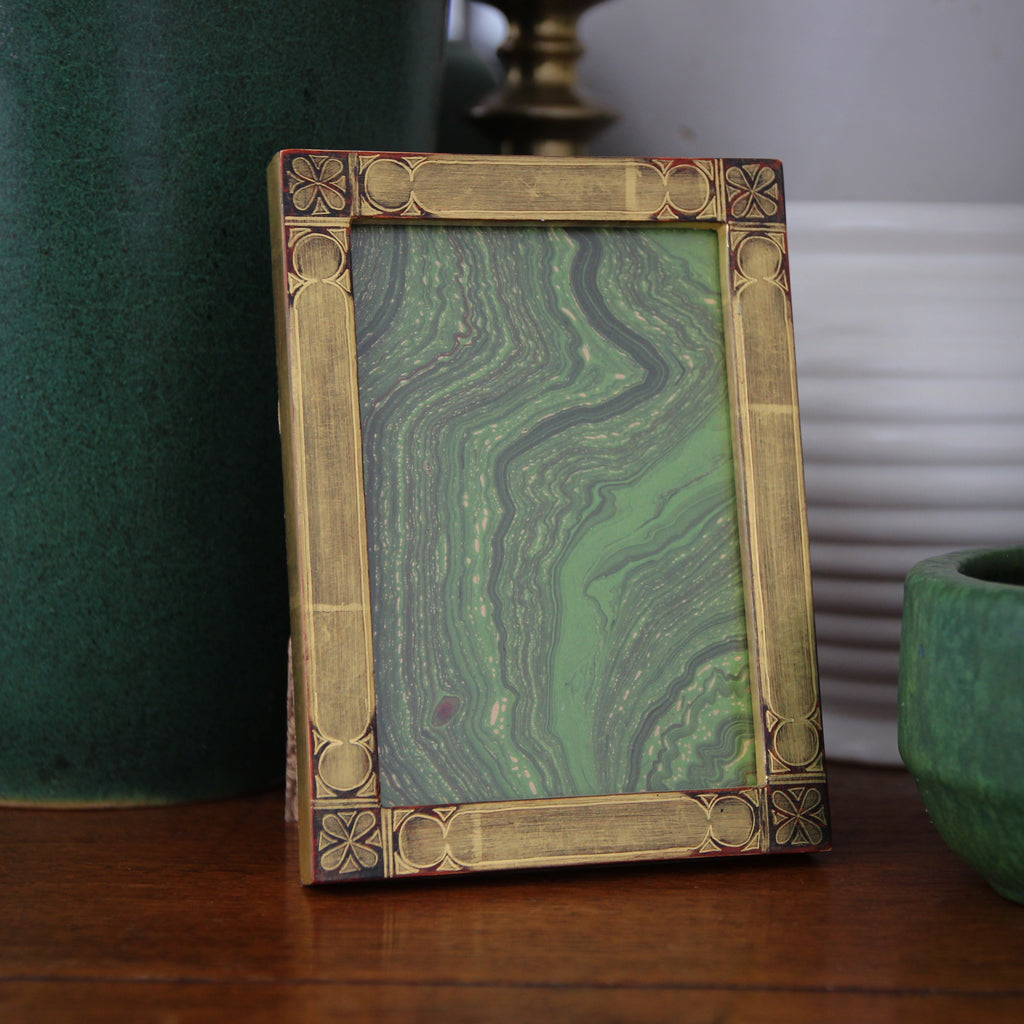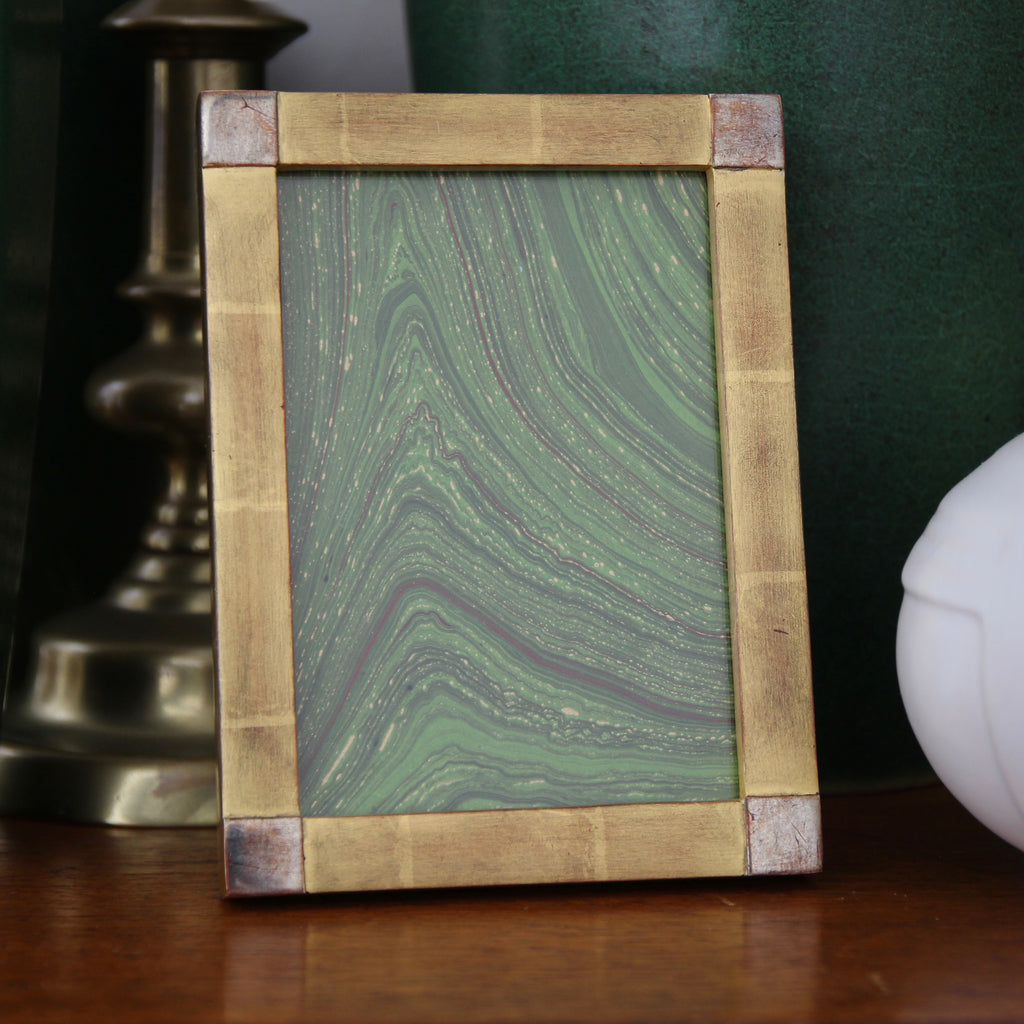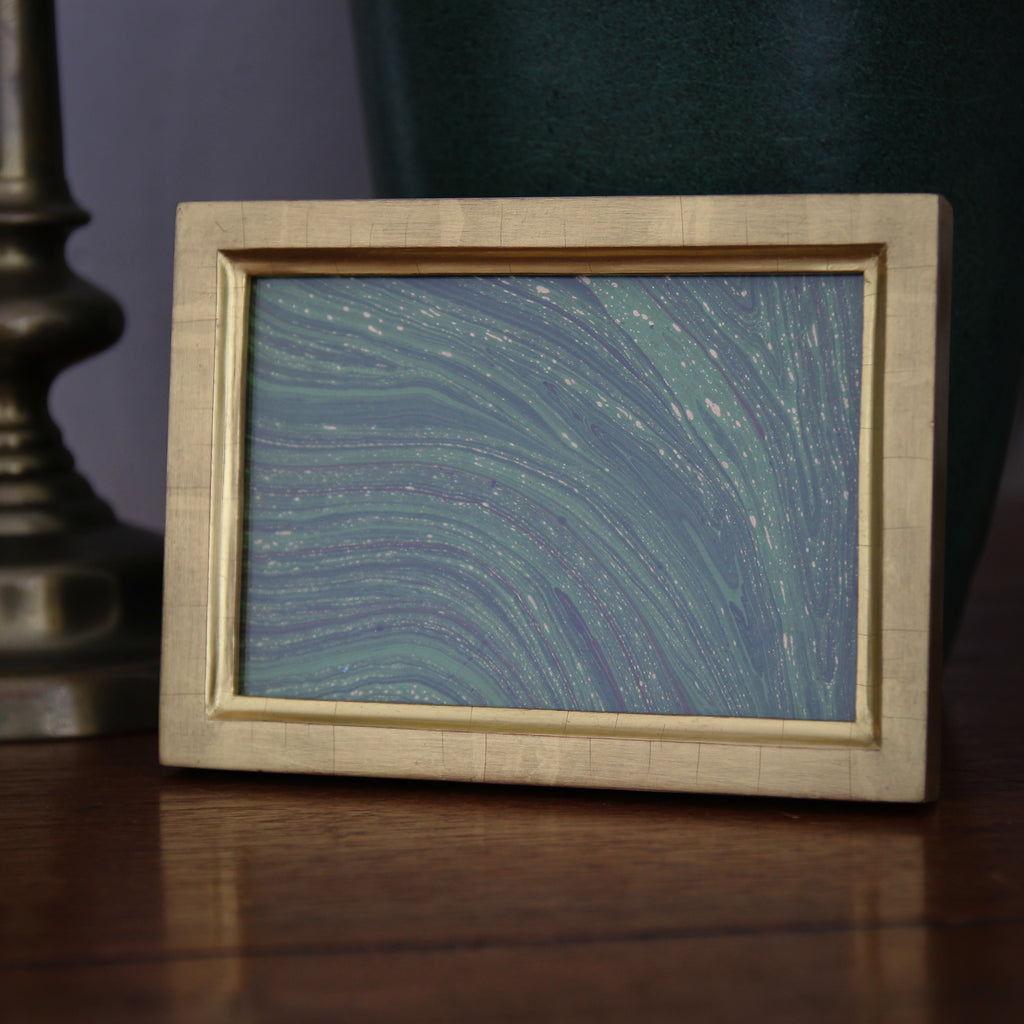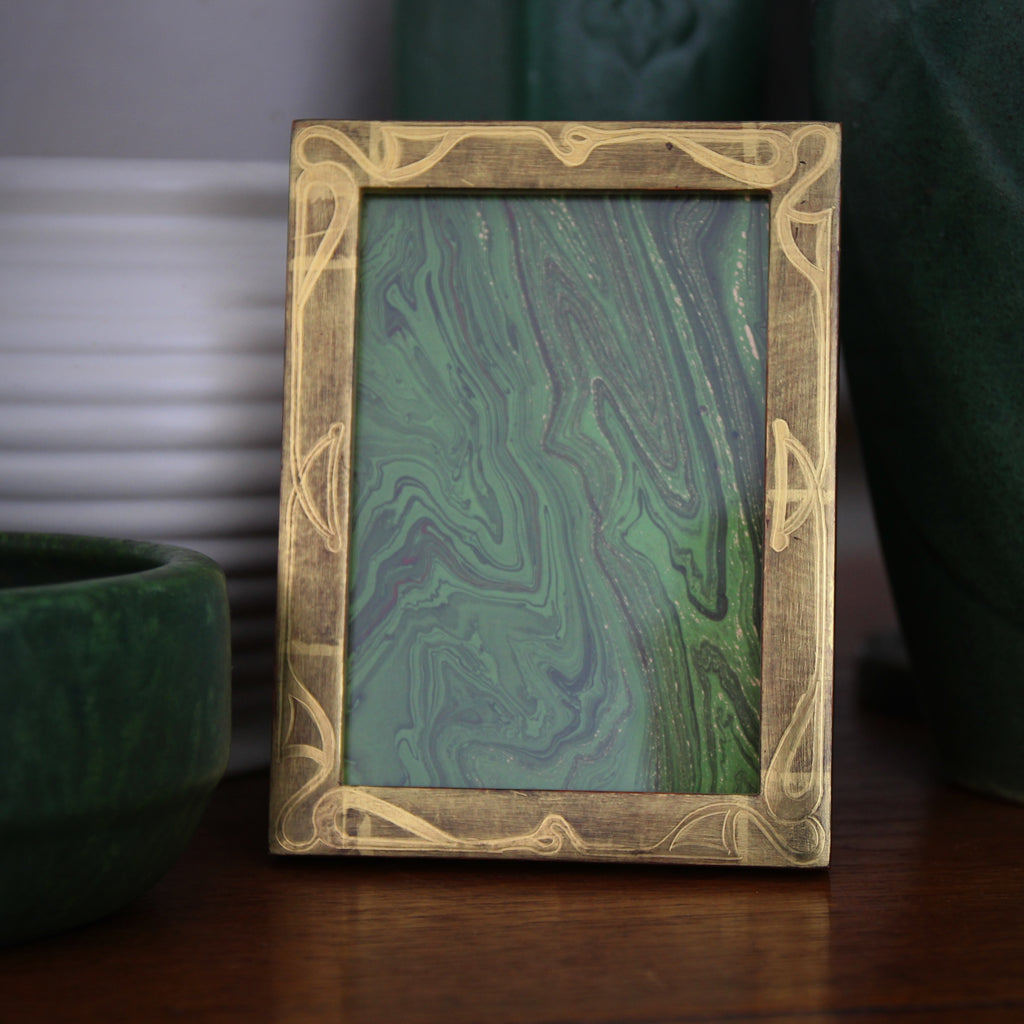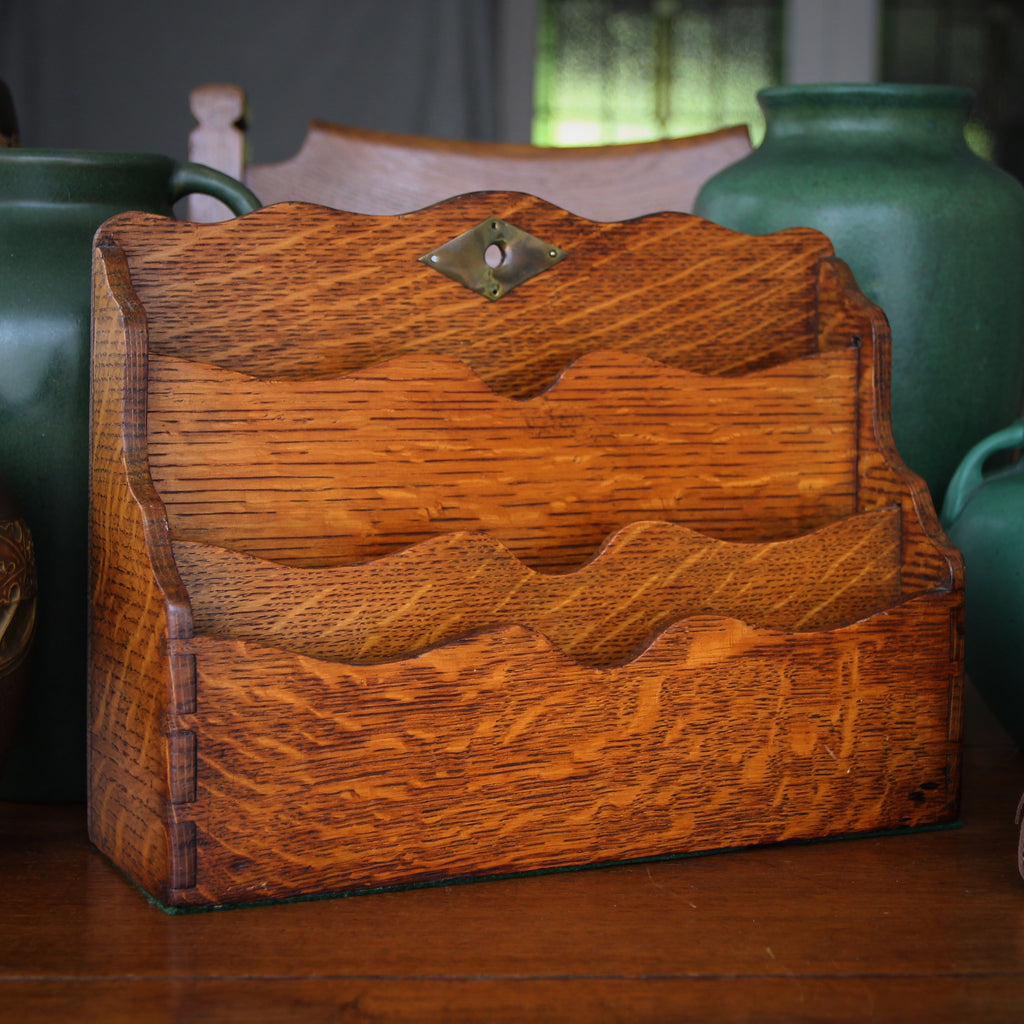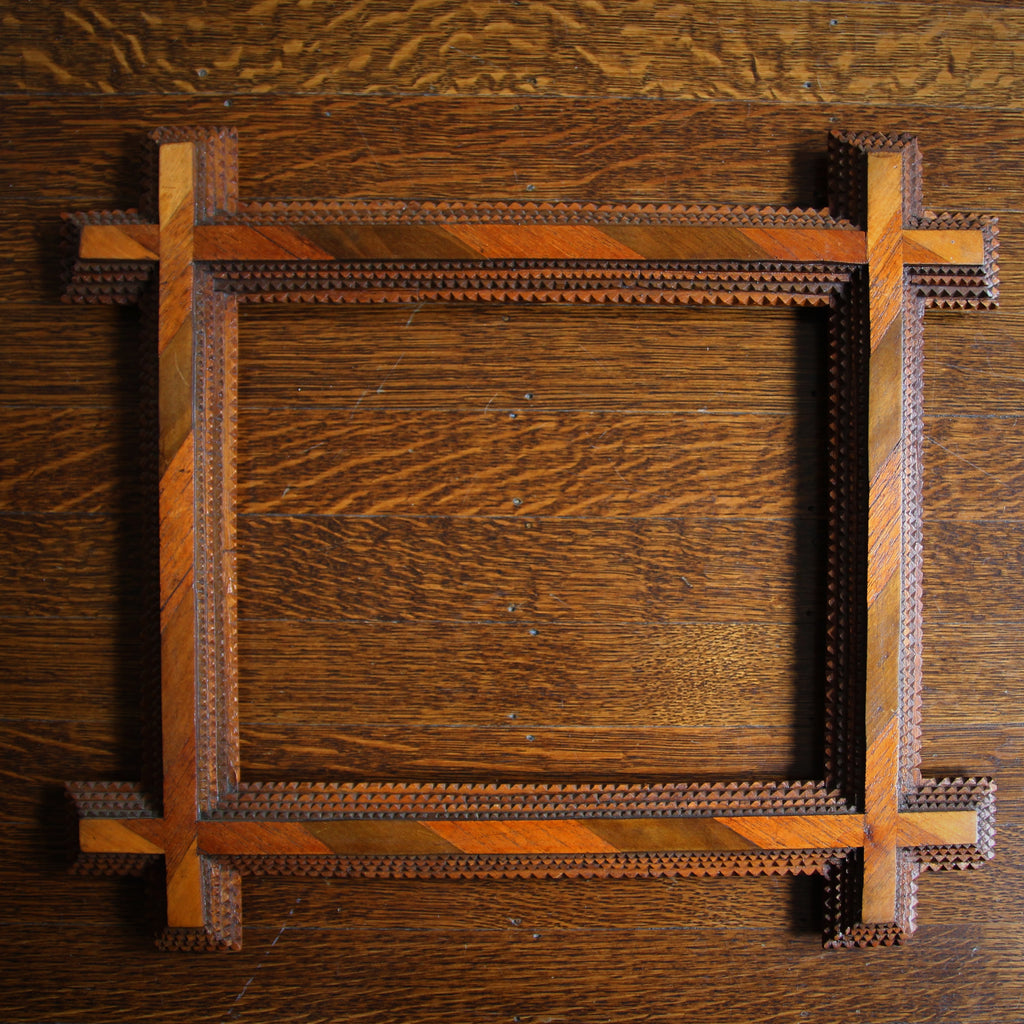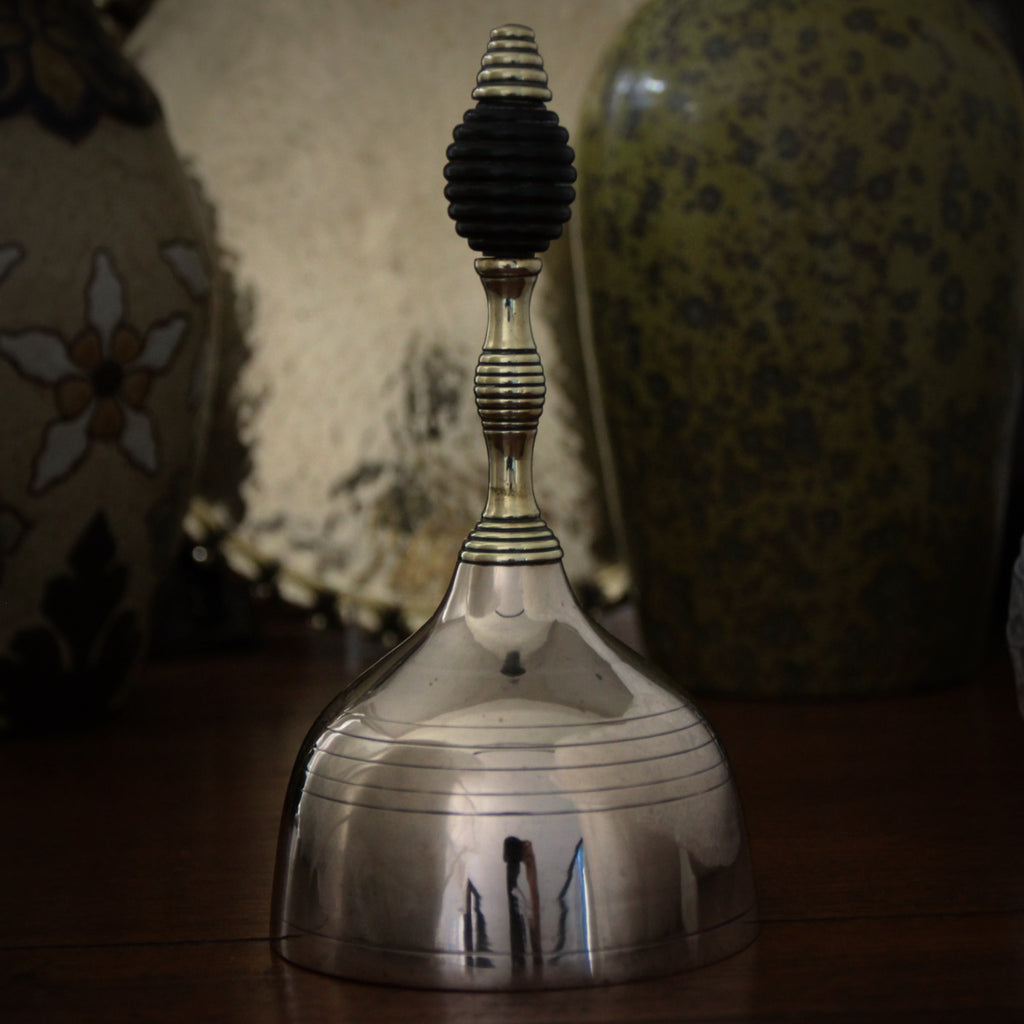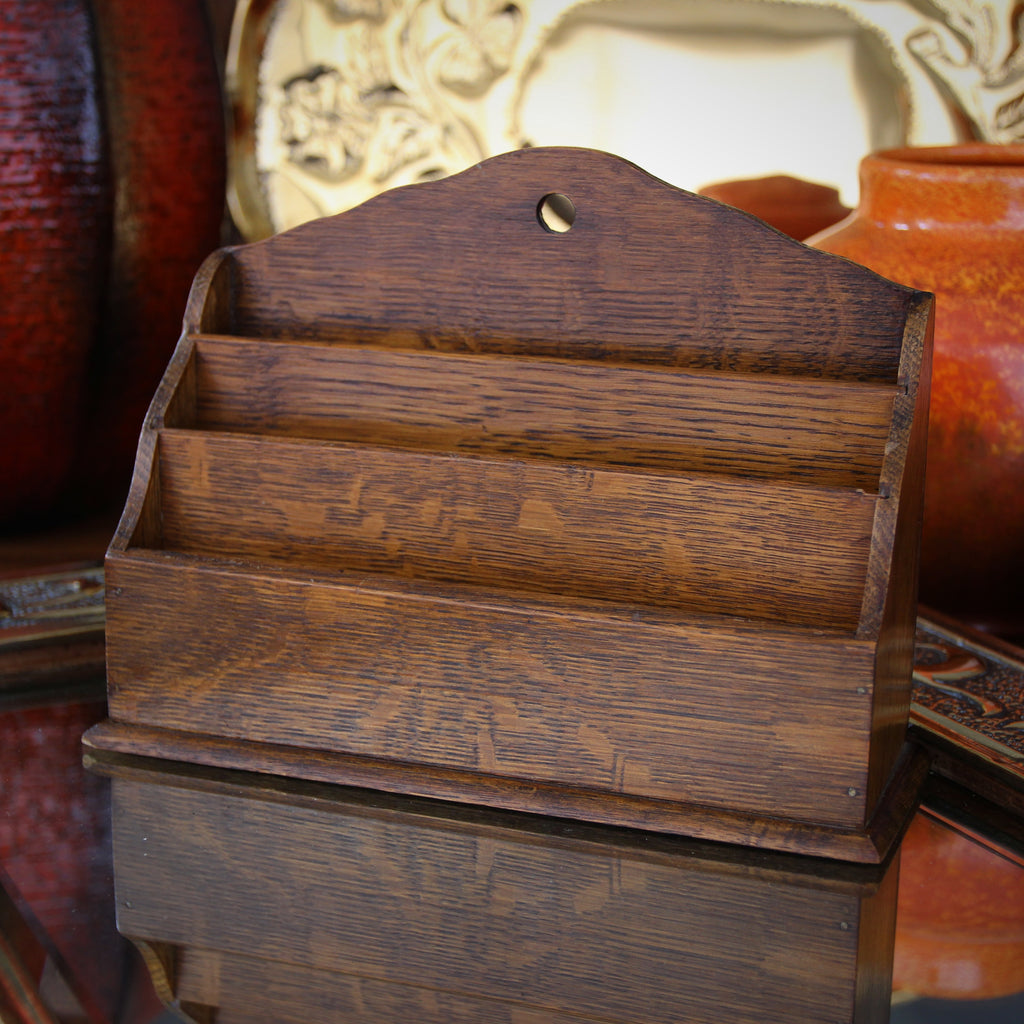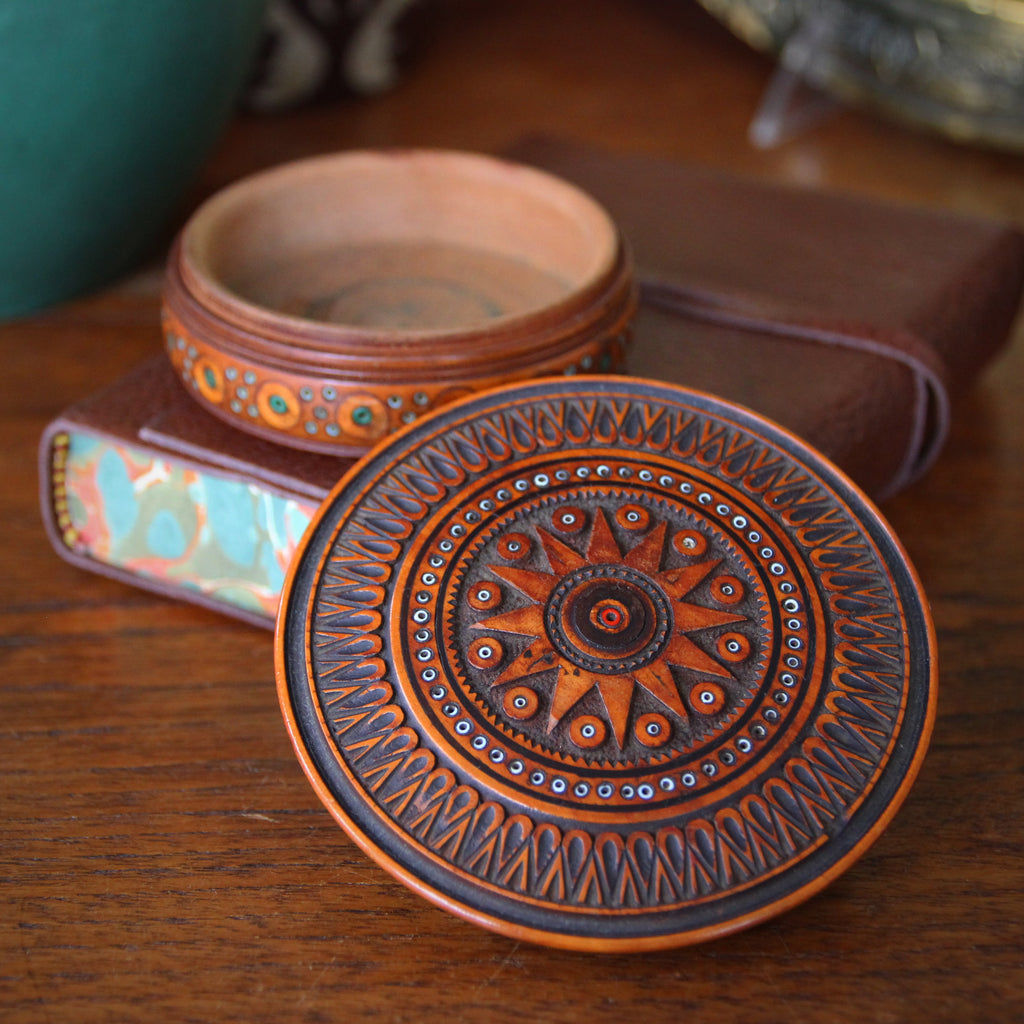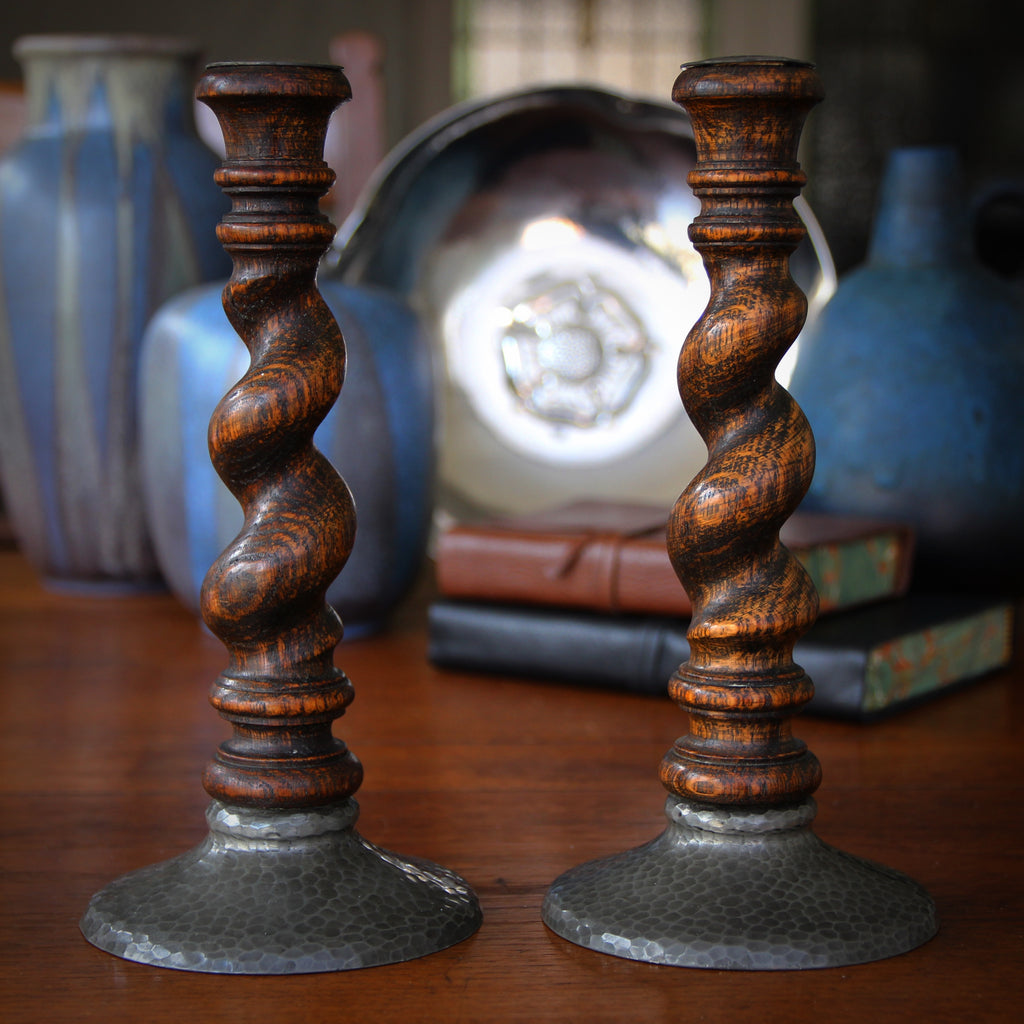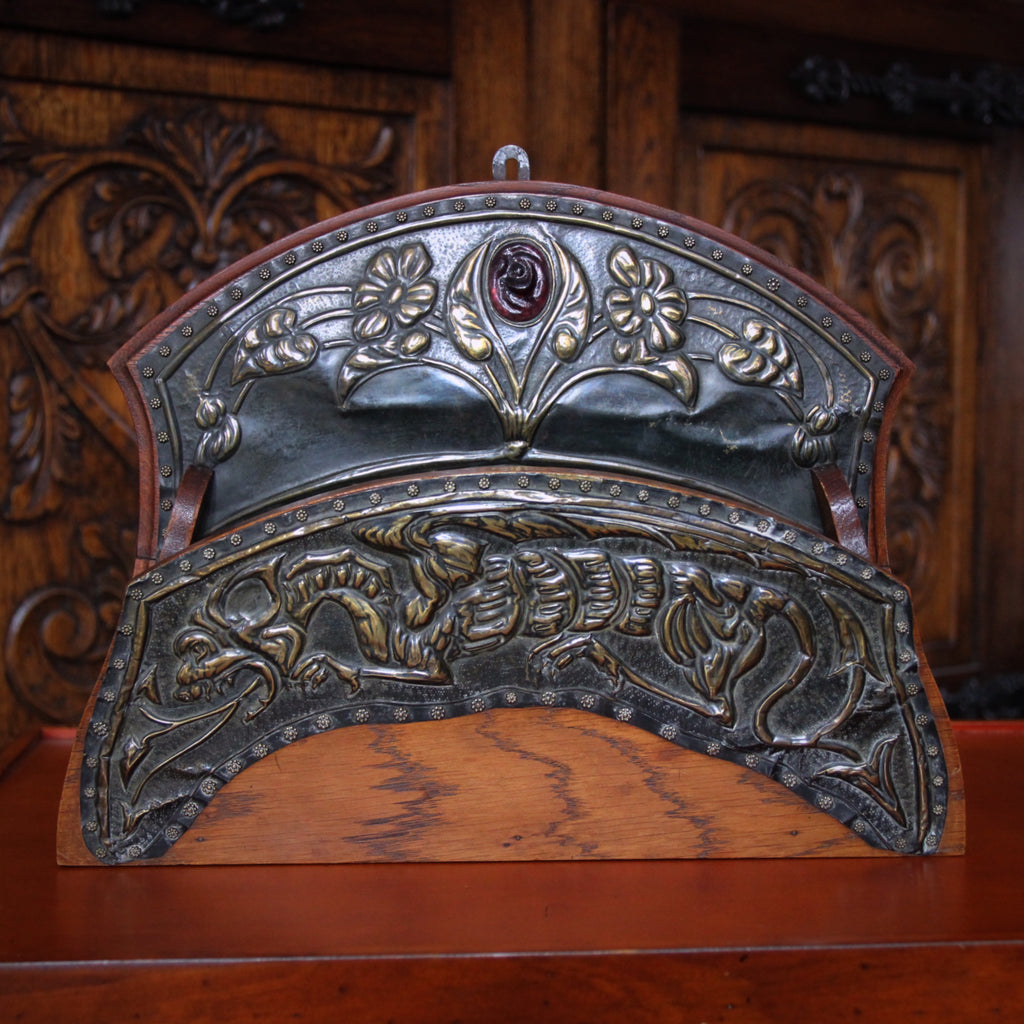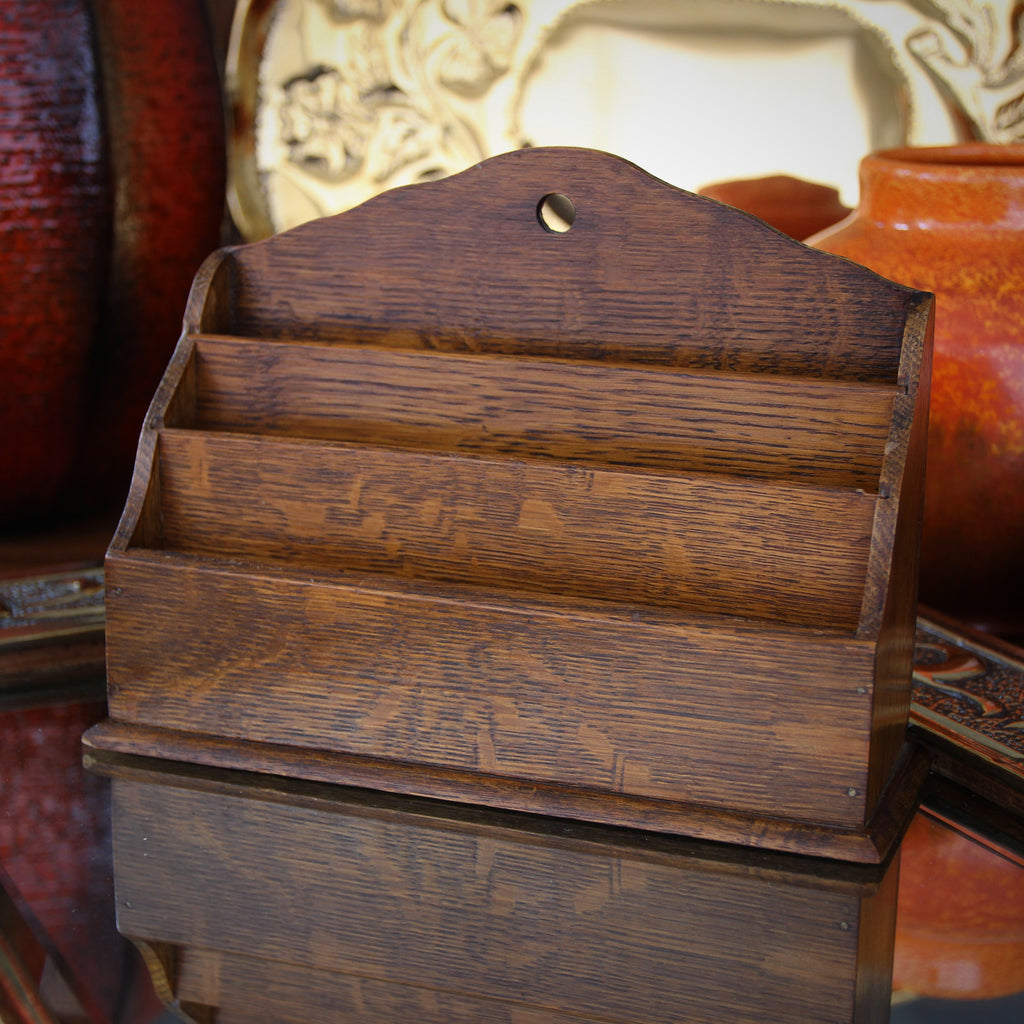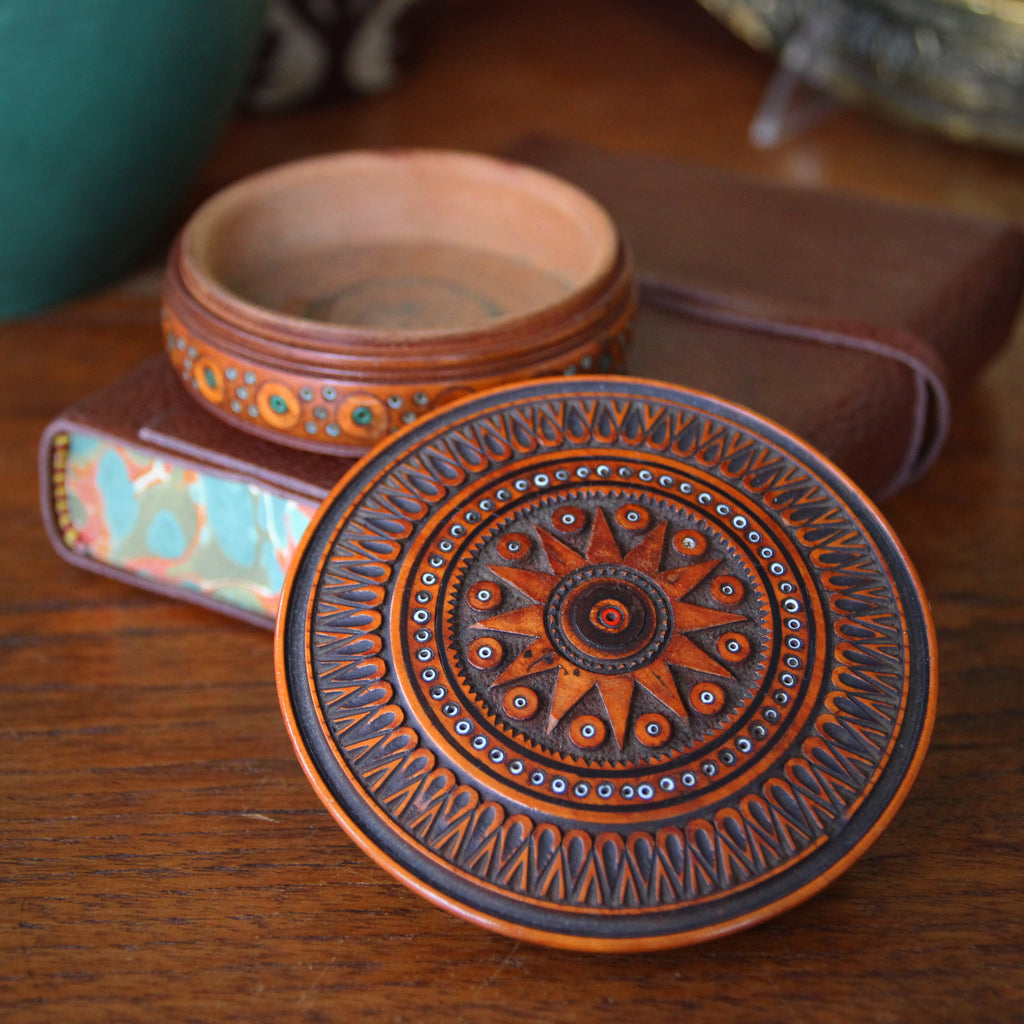JOURNAL — Woodwork RSS
One of my favorite finds of the last few months: a pair of English Arts & Crafts turned mahogany candlesticks. The "cup" at the top has a tulip blossom or poppy pod floral-form. And "knuckles" at the top and bottom of the reed-thin shaft give visual weight to the turning. Truly elegant! And much more impressive in-person.
Indian Clubs
Exercise clubs are believed to have been developed first in Persia, called "meels," which were used in individual and group exercise routines. They later became popular in India where Colonial British soldiers discovered and adapted them for their military fitness regimens. It was at this point that they began to be called "Indian Clubs." English Commonwealth and American civilians embraced them during the Late Victorian age. The clubs range in weight from about a pound (for use in calisthenics) to very heavy (up to 100 pounds, for resistance training). After World War II, and the advent of more sophisticated exercise equipment, Indian Clubs lost their popularity. Today they are most often used as a decorative accent for a clubby, athletic...
Charles Rennie Mackintosh
We have been taught, "A prophet is never accepted in his home town." It seems this was the case for Charles Rennie Mackintosh, the foremost designer of the Scottish Arts & Crafts movement. His influence, during his lifetime, was more eagerly embraced outside of Scotland than it was at home. Many of his Scottish architectural designs were never built. He eventually abandoned architecture and focussed his later years on watercolor painting. Naturally, once he had died in 1928, his work became increasingly popular in Glasgow and his legacy has now been firm established. Today, one cannot walk five steps in Glasgow without seeing some kind of Mackintosh-inspired graphic or souvenir.
Small Chairs
There's something I love about small chairs. I don't have children. I've never had a doll. But I can't pass-up a nice, small chair—be it made for a child or a toy.
It's not that I particularly like chairs. In fact, I have always made it a point not to stock "real chairs" (they take forever to sell and take-up too much shop space until that happens).
What I like about small chairs is that they are wonderful merchandising (or home decorating) props. One can place a small chair atop a merchandise display—a table, a shelf or a mantelpiece—and provide automatic "lift" to some featured item. It helps to "break-up" the display area, creating a variation in height amongst the products.
Très Convenient
The older I get, the more I appreciate just how convenient a good tray can be. Of course, I have always used a tray when serving my guests at table. But I now find myself pulling-out the tray when I set or clear the table (carrying far more plates, cutlery, napkins or glassware than I could handle without it). The tray makes carrying safer and easier—and it cuts-in-half the number of back-and-forth trips I have to make. I also use a tray when moving merchandise around my home or showroom—and appreciate the reduced number of trips I have to make up or down a flight of stairs. The tray makes it easier to organize LEO Design's collection of cufflinks (which...
Arts & Crafts Elegance
At first glance—which was from a distance—I thought that these English Arts & Crafts candlesticks were made of cast and patinated bronze. It was only upon closer inspection that I realized that they are mahogany, burnished with a warm, reddish finish. These elegant floriform sticks bear a stylized resemblance to poppies or tulips. The cups are sensuously turned buds. The base is turned, too, with a pleasingly curvaceous profile. Finally, the two "knuckles" floating on each stem provide just the right punctuation to complete perfectly the design. The brass bobeches atop each candlestick—which prevents the candle flame or heat from harming the wood—are darkened with age. They nearly disappear into the wooden candle top.
Ebony
Ebonywood has been used decoratively for millennia. It has a very fine texture and can be highly polished. Carved ebony objects have been found in Ancient Egyptian tombs. The wood became popular in Europe during the late 1500's, when Dutch traders began importing the material which grows in India, Sri Lanka, West Africa, Indonesia, Australia and Mauritius. Recall the heavy, black frames which were popular during the Golden Age of Dutch painting; perhaps some were ebonywood (or other woods ebonized to resemble it). Ebony became popular for European furniture making in the 1600's. In France, such furniture makers were called ébénistes—a word still used for "furniture maker" to this day.
Trench Art
The term "trench art" is used to refer to the folk crafts fashioned of (or partially fashioned of) the used or spare materials of warfare. This art form was especially popular during and after World War One. Trench art was made by all the major WWI participants: England, France, Belgium, Germany, Canada, Australia and the United States. But very little trench art actually was made "in the trenches"—or even on the front lines, for that matter. Much of it would have been made away from the battlefield, for example, at training camps or other military posts. Some might have been made in hospitals by recuperating soldiers. And some may have been made back at home—by soldiers awaiting call-up. Even after...
Wooden It Be Useful? - V
Can one have too much organization on one's desk? This English early Twentieth Century oak stationary stand bears the crest of Queen's College, Oxford. Store stationery supplies: envelopes, paper, business cards. Perhaps a stash of commonly used forms or cards. Or keep your to-do cards and paperwork close-at-hand. And the handsome, wooden construction adds a small touch of architectural interest to your office, den, kitchen or entryway.
Wooden It Be Useful? - IV
To hold this Japanese hand-carved business card case is to appreciate its beauty and craftsmanship. The delicately tapered "wedge" (thicker on one edge than the other) feels great in the hand. The hinged cap, at top, closes with a satisfying magnetic click. Pulling the case from the breast pocket of a jacket will provide that extra measure of confidence before handing one's business card to that important professional contact.
Wooden It Be Useful? - III
This week we're sharing a selection of useful wooden items. The wood of this English barrel-form coin bank glows richly. Riveted brass bands punctuate the bulging form. Warm, honest materials meet straightforward function: a handsome place to stash your savings.
Wooden It Be Useful ?- II
Yes, this English Arts & Crafts Letter Rack is made of wood—though it is embellished with plenty of hand-hammered brasswork. A winged dragon stalks in a field of botanicals, while an undulate amethyst glass cabochon floats overhead. The hand-tooled panels are riveted to the oak understructure. This piece is made to hang (on its mounting ring) or it can rest of a flat surface.
Wooden It Be Useful? - I
Is there anything more wonderful than wood? Warm. Useful. Natural. For millennia, humankind has been fashioning wood for tools, shelter, warmth and all sorts of decorative items. Perhaps it is the most malleable and accessible of natural materials. And the nature of wood makes it ideal for many uses—which no other material can replicate.
For the next several days, we'd like to share a selection of our wood-crafted objects, items which are handsome and useful.
Shown here, an American Arts & Crafts slatted oak wastepaper basket. The quarter-sawn strips, bound with rawhide lashings, add an additional level of textual interest. What Arts & Crafts desk (or office) wouldn't look better with this handsome basket?
Oxford Around the Corner - III
Let's wrap-up this short presentation on Oxford Corners with an Eastern European beauty, made in the Teens or Twenties. Marquetry stripes of contrasting woods are surrounded by notched chip-carving—providing a serrated "Tramp Art" effect. Tramp Art is the popular name for notch-carved treatments on folk-crafted wooden objects. Traditionally, the items were assembled and carved from found objects: cigar boxes, fruit crates, scrap wood offcuts. The "romantic legend" implies that homeless men, in an attempt to make a bit of money, would scrounge for the recycled materials and craft the little wooden objects to sell. In truth, Tramp Art was probably more often a simple, low-cost handcraft practiced by hobbyists and boy scouts at home, at school or at summer camp....
Oxford Around the Corner - I
I'm heading to England this week—London, not quite Oxford—and I thought I might prepare for the trip by sharing a few frames with "Oxford Corners."
Oxford Corners are the style of framing joinery in which the vertical and horizontal members form an intersecting cross at the corner. And, while such joinery is named after the famed academic city, Oxford Corners have been made all over Europe—especially in the Nineteenth Century, from which the frame above originates.
The "Blackforest" frame, shown above is from either Southern Germany or Switzerland—the forested mountainous region which has long specialized in carved woodwork. This frame exhibits a hand-carved "rustic-timber" profile. Carved wooden leaves embellish each of the frame's corners.
Edelweiss
In 1856, Austrian Emperor Franz Joseph I was enjoying a mountain trek with his new bride, the Empress Elisabeth, a Munich-born beauty known as "Sisi." He picked a few edelweiss blossoms from amongst the craggy rocks and presented them to his beloved with the words, "First in my life that I picked myself." From that point onwards, the popularity of the flower was assured—as a symbol of immaculate and everlasting devotion (and, more broadly, emblematic of the rugged purity of the Alps and her people). Sisi wore nine edelweiss blossoms in her hair while sitting for her famous portrait by Winterhalter. For his part, the Emperor had edelweiss blossoms embroidered upon the collars of his Imperial-Royal Mountain Troops. The flower...
To Market! To Market!
A village woman—perhaps heading to market—enjoys a last minute snuggle with her kitten. This beautifully-carved wooden sculpture is likely from the Blackforest (Germany or Switzerland) or, perhaps, Eastern Europe.
The Sporting Life - III
A country squire works his fields, shotgun in-hand and bird dog at his side. This lithographic print, published in 1898, is the work of Sir William Nicholson, RA. It was published in London as part of a bound portfolio titled An Almanac of Twelve Sports. It is framed in a rustic "woodland" carved frame—a decade or two older than the print itself.
For A Doll's House
I am always looking for "things to hold other things." Near the top of that perpetual search list are objects which can be used to hold business cards. Coolness, style and unexpected adaptation always goes a long way. This little vintage bench—made of pine twigs—was made in the Fifties for a doll's house. In order to keep the cards from slipping between the twiggy slats, I folded one of the cards ("just right") to create a smooth, impermeable surface.
Measuring Up
125 years ago, rolling tape measures were made of printed fabric, wound around a spool in a bulky cartridge. One would pull out the tape measure and reel it back in, as one would a fishing reel. Modern, stiff metal tape measures were invented in the Twenties; the concave-convex metal tape allows it to remain relatively stiff, an aid to measuring. The "thumb lock" tape measure was patented by Stanley in the Sixties. Speaking of Stanley, this New Britain tool manufacturer made the folding pocket measure, shown above. This is the "Stanley #62," made of boxwood and brass (which is used for the hinges and along the sides of the ruler). A measuring stick like this would be carried in...
Game Time
With the Holiday guests coming—and the long, quiet Winter to follow—indoor family games could become more popular in many a household. Card games, like poker and black jack, use chips as stand-ins for actual money. Likewise with roulette (though most homes are more likely to have a deck of cards on-hand than a roulette table). This hardwood English Art Deco poker chip caddy is ready to help entertain your Holiday guests (or speed-up those long Winter nights). Red, white and blue interlocking poker chips surround the perimeter of the caddy. A burled inlay adds a bit of pop around the handle. And a stitched leather cover keeps everything tidy and secure between games.
Autumn is Here - part XIII
As the Autumn chill increases, we find ourselves hanging-up the garden tools and returning to our indoor pastimes: reading, baking, arts & crafts. For those who sew (or practice other needlecrafts), this hand-carved Swiss Blackforest pincushion might be a handsome and practical solution. Leaves and scrolling branches provide the frame—which, if desired, can be hung right on the wall (next to one's sewing spot). It can also be stored in a sewing basket or on a sewing room table or shelf. If sewing isn't your hobby of choice, this pincushion might be a useful place to hang some of your jewelry: pin-on the brooches directly and hang earrings or necklaces on a straight pin. It is also a clever and handsome...
Unearthing a Trove of Nicholsons - III
Let's end our tribute to the brilliant English artist, Sir William Nicholson, with a tribute to the brilliant American writer, Samuel Langhorne Clemens—better known as Mark Twain. In 1899, Nicholson published his first series of Twelve Portraits, published in London by William Heinemann. This was after Heinemann had already published three other Nicholson portfolios: An Almanac of 12 Sports (1897), London Types (1898), and The Alphabet (1898). Heinemann was keen to keep the business rolling. He proposed a second series of twelve portraits—and even suggested the list of luminaries to be included. The problem was, Nicholson was quite busy! He was running a successful graphic arts and printmaking business with his brother-in-law, James Pryde (called The Beggerstaffs). He was asked...
Unearthing a Trove of Nicholsons - II
In the late Nineteenth and early Twentieth Centuries, a number of Black (mostly American) boxers persevered in their challenging rise to prominence in the competitive boxing circuit. Such matches were certainly freighted with measures of fear, racism and "exotic spectacle"—especially when a Black fighter was matched with a White one. But Black boxers were popular, some developing legions of fans—in America and internationally.
Jack Johnson (1878-1946) was one of the most famous Turn-of-the-Century African-American professional boxers. Others included Joe Jeanette, Sam Langford and Sam McVey.
Unearthing a Trove of Nicholsons - I
I've been collecting William Nicholson prints for nearly thirty years. When I closed the store in Greenwich Village (and moved to Pittsburgh), I brought with me a flat file full of "frameable orphans"—antique pictures waiting to be adopted, that is, placed in a suitable, "forever frame." These prints and paintings have been sitting (in the dark, in Pittsburgh) for the last six-and-a-half years, waiting for me to find them frames. In truth, some of these pictures (including a number of Nicholsons) had been sitting in that flat file for an additional 20 years before the move. What slows-me-down is finding the right, period-correct frame for each special print. Although I collect antique frames, only a small percentage of my "private reserve" frame...
In Search of the Pharaoh's Daughter - XIII
It's our last day in Egypt and we decided to explore Cairo's Coptic Quarter—a neighborhood populated with some of Egypt's diminishing Christian population. It's a lovely change of atmosphere from the gritty, bustling commotion of modern Cairo. Almost zen-like. Though full of people, the neighborhood seems to have a calm and centered air. The word "Coptic," in its simplest sense, means "Egyptian." "Coptic Christians" simply means "Egyptian Christians." Though, today, the word Coptic (alone) has come to refer to Egyptian Christians. The Coptic Orthodox Church has its own pope and rites and has been separate from the Roman Catholic or Greek Orthodox Churches since 451 AD. Coptics name Saint Mark (who was evangelizing in Alexandria, Egypt) as their founder. It...
My Little Cabin
Modern people—especially urban denizens—often long for a little place in the country where they can get-away from the bustle of workaday life. A place to go, perhaps for the weekend, where they can relax amidst nature and "recharge their batteries." The Adirondacks in Upstate New York is full of city dwellers (at least on the weekends). Bostonians choose Cape Cod, New Hampshire or Maine to get away. And the many (many) islands which populate the waterways near Stockholm are dotted with thousands of cute red and white weekend cabins. Whether used for hunting, fishing, reading or cooking, these little weekend homes provide the rest and relaxation needed to counteract the hustle-and-bustle of modern, city life. This little log cabin,...
Always Good Intentions
I remember Eighth Grade Shop Class quite well. It was at Kapaa Intermediate School, on the Hawaiian island of Kauai, and we would rotate through the various "disciplines" quarterly: woodworking, metal craft, technical drawing and gardening. If Mother's Day or Father's Day happened to coincide (even approximately) with the woodworking or metal craft interval, you could be certain that a "love-crafted gift" would be going home to the parent in question. Now, 47 years later, I can still clock a shop class creation from across the flea market. The piece always has good intention; it's the level of finesse which varies. And I always spare a thought for the (poor?) parent who was required to "oooh and ahhh" at the...
I'm Not Going Native!
Though I live in the City of Pittsburgh, I am part of a multi-dealer group shop, The Antique Center of Strabane, in Washington County—the suburban (and rural) region south of The Steel City. Thus I am a daily witness to the aesthetic "taste preferences" of this non-urban population. What's most popular in this area is a rustic country look, sometimes called "primitives." This means crocks, old kitchen accoutrements, and rustic, painted wooden furniture.
One such example of primitive goods is the weathered knife box, shown above. It displays the "life wear" which primitive collectors want, plus substantial traces of the original paint, in this case white.
Mirror, Mirror
I vastly favor antique mirrors with old—preferably original—glass. Old glass is wavy, hazy, sometimes a bit spotted or otherwise degraded by time. It has the right character to convey the piece's age, which new glass just cannot do. How much aging is the right amount? Well, a light sprinkling of dots is nice; maybe a grey haze of time. But I've never seen glass which looked "too old." In my life, only the bathroom mirror needs to be ultra-clear. This is where I shave and perform other delicate functions (sometimes with sharp implements) and want to see precisely what I am doing. All other times, "soft focus" is just fine. The American Empire mirror, shown above, is a handsome specimen...
Classic Sidekick
The classic Spanish novel, Don Quixote, is a masterpiece of Western literature. Published in two parts (in 1605 and in 1615), this book by Miguel de Cervantes is considered by some scholars to be the World's first modern novel—and amongst the foundational works in the Western canon. Cervantes has given us a misguided dreamer, an idealistic romantic on a hopeless quest to rekindle chivalry and valor in the world (a "Quixotic" ambition, indeed). And Cervantes has also provided the classic sidekick, Sancho Panza, whose earthy simplicity provides a shockingly clear (and often funny) counterpoint to the hero's whimsy.
Mirror, Mirror
In the Edwardian Era, when indoor plumbing was still a novelty, men would shave on a washstand—in the bedroom—using a large pitcher of hot water and a large ceramic water basin. Sometimes the washstand had a built-in mirror. Often, the washstand was simply tiled with glazed ceramic squares—an measure to keep the furniture water-resistant. An Edwardian English walnut shaving stand like this would have stood atop a washstand (or dressing table or chest of drawers). The stepped, chevron-form stand is mounted with a brass gallery to help corral the various tubes, mugs and pots associated with shaving. A divot in the center front is a handy place to store one's cufflinks or spare razors. The oval mirror is nicely bevelled and the...
Rainy Weekend
It's a rainy weekend here in Western Pennsylvania. Good for my Spring plantings—and, actually, good for sales (as people shop when they cannot play out-of-doors). This English Arts & Crafts "stick stand" (Americans call it an "umbrella stand") is the perfect, handsome accompaniment for such a rainy day. It's made of mixed-woods and boasts attractive, botanically-inspired "piercing." A crenellated top edge "crowns" the piece.
The Good Shepherd
In truth, "The Feast of the Good Shepherd" was last Sunday, 30 April. Alas, I had not yet acquired this Late-Nineteenth Century Italian print of The Good Shepherd in time. So I'll share it now.
The lithographic print is nice, if not "important." What really sets-apart this piece is the exquisite Italian frame. Tiny pieces of wooden marquetry—and lots of those pieces!—are precisely cut and laid finely into the wooden frame. Under close inspection, one can really appreciate the painstaking fastidiousness of the craftsman. From a distance, the graphic pattern of the woodwork seems to radiate energy outward—giving the Christ figure a "halo-like" presence.
April Showers - Part Five
Before the 1950's—when automatic washing machines became commonplace in middle-class American homes—doing laundry was not a lot of fun. Usually on a Monday, laundry day started before sunrise. Water was carried-in, brought to a boil, and the laundry was processed as a day-long event. For this reason, until the last several decades, people sought ways to reduce the amount of laundry which had to be cleaned. Men wore detachable shirt collars, which allowed the collar to be removed and cleaned separately from (and more frequently than) the shirt itself. Women wore substantial (though light) undergarments which helped keep their outer garments clean longer. And guests (or family members) might use the same linen dinner napkin for several meals (or throughout...
You Had Mail . . .
On this day in 1950—73 years ago today—the U.S. Post Office reduced mail deliveries to once per day (Monday through Saturday). Many of us don't remember the time when mail came more frequently. In the Nineteenth Century, households received mail deliveries up to five times a day. In the first half of the Twentieth Century, households received a morning and an afternoon delivery; businesses received mail up to four times a day.
This Edwardian English wall-mount letter caddy was the perfect spot to stash newly delivered letters and newspapers at the Turn-of-the-Century. A handsomely chamfered oak panel is mounted with brass holders—embellished with enameled lettering and decoration.
Creative Blocks
Building blocks have long been given to children—for play, for learning, to inspire creativity. This small set of blocks, from the Turn-of-the-Century, come in their own flat presentation box, complete with sliding, decorated lid. Some of the blocks are carved into balustrade shapes. Others are clad in a decorated paper skin. Great for a school child or as a conversation piece on an architect's desk or credenza.
Signs of the Times
When I travel to other countries, I frequently am reminded just how short is the history of the United States. Put another way, things have moved much more quickly in America than in some other places. Sometimes the merchandise I collect helps to illustrate that point. Consider the handsome walnut oval photo frame, shown above. It was made in the 1850's. Let's propose that it was made during the presidency of Millard Fillmore (1850-1853). This was still three presidencies before that of Abraham Lincoln (1861-1865). And, while the frame is considered "Victorian," we must remember that Queen Victoria reigned for a very long time; 18 American presidents held office during the length of her rule (and three more before she even...
Giving Alms
During Lent, Christians are encouraged to pray, fast and give alms—that is, provide money (or other necessities) to those in need. These disciplines prepare the heart, mind and soul for the the joyous season to come: Easter. Sure, almsgiving is (and always has been) important. And not only amongst Christians. But who knew it could be done with such style? This handsome Arts & Crafts alms plate, made around the year 1900, is fashioned from hand-carved oak. The exhortation, "Give Alms of Thy Goods" surrounds the plate and a soft velvet pad is affixed to the bottom of the bowl (to muffle the vulgar rattle of coins). It's a beautiful plate—and one which has done much good, collecting unknown amounts...
More Middle Eastern Marquetry
Here's another Middle Eastern Mid-Century marquetry jewel box. Various, differently colored woods are arranged—with Mother-of-Pearl—to create a handsome place to keep your jewelry, watches, keys, or other small treasures. It would also be a nice place to inter the ashes of a beloved pet.
Middle Eastern Marquetry
Artists have been crafting beautiful inlays for millennia. Mosaics, enameling and inlaid woodworks can be found amongst the artwork discovered from the earliest of times. Marquetry is not technically an "inlay." It is an arrangement of thin wood pieces (or shell, bone, stone, metal, straw or other materials) which is precisely cut-and-fit together in a thin sheet and applied as a veneer to a flat wooden surface—for example a piece of furniture, a floor, a wall, or a small flat object. Marquetry was used in Ancient Egypt, Persia, Rome, Renaissance Italy, and throughout Asia for centuries. The Middle Eastern box above, made in Mid-Twentieth Century, utilizes various wooden veneers and chips of Mother-of-Pearl to create a warm and handsome geometric...
Have a Seat
Having had a small (and tight) Greenwich Village storefront for 23 years, I've developed a certain prejudice against buying chairs. Especially sets of chairs. In my experience, sets of chairs do not sell quickly. Sure, everyone needs them. But, until they finally sell, they take-up lots of precious floor space, require frequent moving (in order to reach other things) and are only moderately useful for displaying other merchandise before they sell (compared to, say, a table). In short, they always seem to be in the way! All this said, I have always enjoyed buying children's chairs. Their small size makes them useful (atop or under a table) for displaying merchandise—like a giant, nice-looking riser platform. Sometimes they can be hung on a...
Back-to-Work
Spring is coming—and summer "beach weather" will not be far behind. We will not be able to hide beneath those chunky-knit sweaters for much longer. Time to hit the gym! A century ago—when these turned maple dumbbells were crafted—"strength training" was the domain of a very few, hardy souls: bodybuilders, screen actors, circus performers. 25 pound dumbbells were not to be found in everyday homes (or even exercise rooms). What the Edwardians did have, however, were light dumbbells like these—used to augment calisthenics or stretching regimens. A bit of extra weight (a couple of pounds) can make a difference in a prolonged jumping-jacks routine or regimen of "windmills" for the arms. Even if one doesn't intend to use these dumbbells...
Mirror, Mirror
What once might have been (a little?) flamboyant, is now made very handsome with 140 years of age. The stately oak frame is embellished with a "rusticated botanical" gilded trim and finished with a gilded chain-form fillet. When I found the frame, its mirror (or print or painting) was long gone. So I replaced the mirror—springing for a deluxe one inch bevel. Now assembled, it makes for a very attractive package. It is currently hanging vertically, though I would happily change the orientation for you—just ask.
Chair Pair
In 1866, brothers George and Oliver Colie opened a business in Buffalo, New York which would eventually become the Kittinger Furniture Company. From the start, they insisted upon the finest design, materials and workmanship. Their attention to detail—and their talent at reproducing older, period styles—brought them to the attention of important historical organizations. Today, Kittinger furnishes "bench-made" (that is, high-end) period reproductions to the White House, the US Senate & Congress, the Supreme Court and to historical groups like Colonial Williamsburg. They have also reproduced older styles for sale in their showrooms.
Moorish Beauty
The term "Moorish" is neither precise nor very specific. Through history, it has been used (often by Westerners) to refer to the people, the culture and the art of North Africa and the Middle East—combining-as-one the broad spectrum of varied Muslim and Arab civilizations. As Muslims conquered and expanded into new territories, they brought with them their art and architecture, adapting it to suit (and blend with) the existing architecture of the subjugated lands. Even outside of the Islamic world, Moorish aesthetic culture has influenced greatly the design of Western aesthetics (for many centuries). In the Eighteenth and Nineteenth Centuries, European architects used Moorish design elements to add theatrical flair to their buildings—seeking a new, dramatic flavor which was not as commonly-used as the Gothic...
Top Shop Dog
My little Benji—one of the top loves of my life—turns ten today! After years of "guarding" the LEO Design cashwap counter at 543 Hudson Street, he has adapted well to worklife behind a couple of antique shop counters in the Pittsburgh region. After a bit of initial exploration and expectation, he usually crawls into his travel crate where he can nap the afternoon away (as he did in Greenwich Village). When I'm working at home, he curls-up under my worktable, occasionally inserting himself into one of my merchandise photo shoots—and always remaining ready to announce furiously the rattle of the postal slot.
Fit for A King (Edward)
I have a real soft spot for the British Edwardian Era. It is remembered as a time of modernism, optimism, liberated fashion, and a leap forward in the arts—the fine arts, the decorative arts and the performing arts. Both the Arts & Crafts and the Art Nouveau Movements flourished during this period. It was a time of rapid invention: Marconi transmitted "wireless" communication across the Atlantic; recording technology was changing at-home entertainment, electricity was becoming more common in (upperclass) homes, and the Wright Brothers were taking to the air. And one of the largest, most advanced passenger ships in history, the Titanic, was being built for her notorious maiden voyage.
Boxing Day
Back in the old days—when Middle Class families had live-in help—the servants were expected to serve their masters on Christmas Day. It wasn't "a day off." Servants would have the next day off, 26 December. And, on this day, they would come-by the house to receive their Christmas gift from their employer—their "box"—thus it became known as "Boxing Day." Today, the servants are long gone (at least in Middle Class households). But the holiday remains—an official "bank holiday" in Britain and some British Commonwealth countries. The desk box, shown above, is simplicity itself. Handsome quarter-sawn oak is assembled with dovetailed joinery. A simple hook keeps the lid closed. It's the perfect box for keeping special letters, a bit of jewelry,...
Countdown to Christmas - X
Admittedly, I bought this item for the frame alone. I can always use a nice Blackforest picture frame. I thought I might use it (some day) to frame a period photo, a print or a watercolor. The print, itself, was just a little too saccharine, for me. On closer inspection, however, I concluded that the print has some value, too. It's indeed old—from the Nineteenth Century. And though the subject is not compelling (to me), it wears a nice patina of time. So I decided to list the piece. Either I will sell it with the print, as found, or I will use the frame when the right print comes along.
Countdown to Christmas - VII
Rosewood is a tropical hardwood grown in Central and South America, the Caribbean, Africa, Madagascar, China and Southeast Asia. Actually, rosewood is fifty different hardwoods, 40% of which are varieties of the Dalbergia family. It is known for its tight, handsome grain, wonderful reddish-brown coloration, and the telltale sweet smell (like roses) which the fresh wood emits (sometimes for years). Rosewood was first imported to Europe in the 1700's. It was limited in quantity, precious and, therefore, very expensive. It was used in high-end furniture, paneling, flooring and for making other decorative objets (pool cues, chess sets and jewelry). It was also used for making musical instruments, most notably guitars, marimbas and some woodwind instruments. The most sought-after variety was Brazilian...
Mixed-Use
Chairs—especially sets of chairs—have always been a nightmare for me as a merchant with a tiny shop. Though everyone needs and uses chairs, they never seem to sell quickly—and, in the meantime, they take-up lots of space. Unless you hang them from the ceiling moulding, they become a tripping hazard and consume more floorspace than they deserve.
I find children's chairs, on the other hand, interesting and quite useful. They are often charming. They never seem to come in sets. And, until they sell, I use them as a merchandising fixture—to elevate and showcase other products. Sometimes I leave the chair on the floor, more often I place the chair upon a table.
Arts & Crafts Modernism
In some cases, the Arts & Crafts Movement can be viewed as the early stages of Modernism. Simplicity of design and an aesthetic of functionality can be seen in many Turn-of-the-Century Arts & Crafts objects—such as the oak book trough, shown above. Of course, the Arts & Crafts Movement spanned a wide range of countries and aesthetics (with each contributing a different "vocabulary" of design features and styles). But the mission of "honest simplicity" which informed the Arts & Crafts Movement was clearly carried-onward throughout the Modernist school. This "book trough," made of thick planks of oak, is simplicity and elegance itself. Six screws—three on each side—are the only joinery or decoration to be had, save the handsomely cut...
Fair Winds & Following Seas
Over the years, I've bought and sold a fair number of barometers—mostly from England (and most of those using imported German mechanisms). I never gave much thought to whether they were accurate or not. I always assumed they had already been "sprung," to coin a term. In truth, I didn't really have a method of accurately measuring their accuracy except when extreme weather happened to come around. So, when I purchased this nautical "ship's wheel" barometer, I assumed the status quo would endure. But now I have an iPhone—with a fairly sophisticated local weather app. Over the last two weeks, I've been monitoring the accuracy of this barometer (two or three times a day) and, I must confess, I've been...
Tea Time!
Tea is the national beverage of the United Kingdom. The British have elevated the serving of tea to an art form. Perhaps only the Japanese have managed to outperform the Brits in staging "the theatricality of the tea service." These days, tea is enjoyed from end-to-end of the UK socio-economic spectrum. I've seen (very beat-up) electric kettles steaming-away within the dingy security kiosks at the gates of British construction sites. But, once upon a time—when tea was an expensive, foreign luxury—the mistress of the house was likely to keep the key to her locked tea caddy tucked snugly within the folds of her bodice. An Eighteenth Century servant might only sneak a few sips from an unfinished teapot or from the bottom of an abandoned teacup. Tea was...
Cyber Contrarian
It's "Cyber Monday." Of all the manufactured "holidays," this one seems particularly crass, to me. Particularly manufactured. Particularly self-serving. And, although I do make (part of) my living by selling on-line, I cannot bring myself to cheerlead the event.
Instead, I will find and present the oldest, "least-techie" toy in my possession—no screens, no electricity, no internet connection. It's an early 19th century wooden cradle, made to hold a little doll, fastened with old, square nails.
Which makes me think: how many modern toys last 200 years? I have mobile phones and laptops which are obsolete after 15 years!
For those who cannot help themselves, have a Happy Cyber Monday.
And We're Off!
We officially have entered the Holiday Season. Perhaps you're not quite ready to plunge into the retail fray. But you may be up for a little festal decorating. A jolly parliament of owls is ready to alight upon your doorstep. These endearing ornaments—each one has a distinctive personality—are hand-crafted from natural gourds. Artisans draw, paint, flame (burn with a candle) and etch the gourds by hand—all before attaching a little beak and a golden hanger. Each gourd varies in shape (round, pointed, fat or slim) and the artist's decoration contributes to a one-of-a-kind appearance. They will provide a happy pop on your Christmas tree or look good (all year 'round) hanging in your window. They'd make a nice little gift...
Gratitude
To cultivate an "attitude of gratitude" is to make the best of life. It certainly makes a person more attractive. And it may even improve one's health. It certainly makes one feel better!
For what am I thankful? My faith. My health. My family, husband and dog (Benji). And the loyal LEO Design customers who have allowed me to pursue this unique and wonderful vocation—seeking and acquiring Handsome Gifts and home furnishings which bring pleasure and beauty to my customers' homes.
Tomorrow is Black Friday, the traditional start of the Retail Holiday Season. I will continue to share more new items with you—as I find them—and endeavor to ship promptly to get them to you in-time for the Holidays.
Happy Thanksgiving!
Back-to-School - Part VIII
For the last several days, LEO Design has been sharing some interesting Back-to-School offerings—ideas to help organize, cheer and distract as students push-on through their matriculations.
Style meets Function with this Edwardian English brass and oak letter rack, circa 1905. Simple swirling metalwork stands atop a wooden plinth, finished with a moulding edge. It's sized just-right for holding a supply of stationery and envelopes, bills and documents to be processed, or to do lists and other reminders. A small measure of sculpted motion means just the right amount of visual interest. Otherwise, the piece exhibits pure Edwardian utility.
Back-to-School - Part V
Over the past several days, LEO Design has been sharing some interesting Back-to-School offerings—ideas to help organize, cheer and distract as students push-on through their matriculations.
In terms of sheer indulgence, this Arts & Crafts wastepaper basket wins the "Dorm Room Makeover Challenge." Made of slats of quarter-sawn oak, it is finished with rawhide lacing at the corner tops. It's the handsome, finishing touch beneath that built-in dorm room desk. (Or under that costly Stickley writing table.)
Back-to-School - Part II
Who can't use a little more organization at the desk or in the dorm? Or office, kitchen or craft room? This Edwardian English oak stationery rack, circa 1905, is meant to hold a supply of writing paper, envelopes, cards and letters. But it's a very handy place to organize your paper-in-motion. I use mine to hold paid bills (checks written, envelopes stamped and sealed) while waiting for the correct day to mail them. Documents, brochures or articles which need attention also call to me from their oaken stand. In large families, it might be a good place to leave member's mail—or, perhaps, provide a little "in-box" for intra-family communication. The organizational uses are many. And the stand looks so handsome...
Christmas Comes Early
A "parliament" of owls has landed at LEO Design, with plenty of time left before Christmas—four months from today! Each ornament is handcrafted from a natural gourd. The artisan hand-draws, paints, "burns" and etches the gourd, resulting in a flock of one-of-a-kind birds. Given the various shapes of the gourds (and the artful variations in the decoration), no two owls (or their personalities) are quite the same. We sell the birds as trios (which makes the group, technically, an official "parliament"). We pick the three, making every attempt to provide variety within the collection. A LEO Design tradition for 20 years!
Attention to Detail
Immigrants to America have continually "refreshed" our country—its culture, its food and its gene pool. Many of those immigrants have conceived new ideas, creating business opportunities for themselves, their employees and their communities. One such immigrant was Adolph M. Holstein, a German Jew who moved from Warsaw, Poland, to Syracuse, New York, where he founded the Syracuse Ornamental Company in 1890.
Adolph was an accomplished, European-trained woodcarver. Once settled in Upstate New York, he invented a new product, "SyrocoWood," which revolutionized the home-building trade of the late Victorian Era. Prior to his invention, high-quality carved wooden items required slow processing in the hands of a highly-skilled woodcarver.
Game of Cards
Interestingly, the traditional British card game, Cribbage, is a fun and popular pastime amongst U.S. submariners. The playing pieces are nicely compact and easy to store. And the social and intellectual engagement required must help relieve the tension of living in cramped, submerged quarters. World War II era submariner, Rear Admiral Dick O'Kane, was a cribbage aficionado and, today, his personal cribbage board is kept in the "wardroom" (commissioned officers' mess) of the oldest submarine assigned to the Pacific Fleet. Should the oldest ship be decommissioned, the board is to be transferred to the next oldest ship. The first known rules for cribbage were published in England in 1662, however, the game evolved from the older game, "Noddy," developed in the 1500's. Cribbage...
The Picnic's Over
To paraphrase Peggy Lee, "The Picnic's Over." The long Independence Day weekend is finished and it's time to fold-up the blanket, pack-up the basket, and head back to work. This little English Child's chair does, indeed, fold-up nicely. It returned from Oxford (where I found it) folded-up in my suitcase. It's nicely engineered and constructed of handsome wooden slats. It's a nice chair for a child, of course, and easily stored in a broom closet or drawer. It's also a terrific plant stand, telephone station or side table (to hold a book and a drink). It would make a great display piece to use in and amongst a collection (pottery, boxes, dolls) which require a little elevation for select pieces. It could also...
Humble Beauty
One would think that a wastepaper basket would be a very modest possession. And, indeed, it usually is. This handsome receptacle is the exception to that expectation. Crafted around 1910, it is simply-constructed of strips of quarter-sawn oak. Rawhide lashings near the top are the only visible (functional) embellishment. Over the years, I've sold a number of nice Arts & Crafts wastebaskets. It seems that customers view such a canister as the important finishing touch to a nice Arts & Crafts or Turn-of-the-Century desk. Though over 100 years old, this wastebasket remains in fairly solid condition—though I would always handle such a nice, old beauty with tender care. With TLC, this wastepaper basket may provide another 100 years...
Queen's College
Queen's College, part of Oxford University, was founded in 1341. It was originally intended to educate clergymen for the distant reaches of Northwest England, snuggled just under Scotland (today designated Cumbria County). In addition to clergy, the school also began to educate sons of the nobility and a good number of "poor boys" who were smart but could not have afforded an expensive education. The school was named after its patroness, Queen Phillippa of Hainault. She was married to King Edward III and served as his political advisor and regent (while he was away during the Hundred Years' War). The school is known for its handsome architecture, some of it designed (or influenced) by Sir Christopher Wren (1632-1723) and Nicholas Hawksmoor...
Mahogany
Mahogany is a tropical wood which came from The New World—especially South America and the Caribbean islands. Its beautiful reddish appearance, often with a subtle sheen, has made it a prized material for prominent uses: furniture, paneling and flooring. The wood is easy to work and very durable, two more factors which have made mahogany popular for centuries. As Europeans colonized the Americas, and the beautiful wood became known to Europeans, a brisk Trans-Pacific trade flourished, beginning in the 1500's. Over-harvesting (and illegal harvesting) has been an on-going problem, even to this day. The origin of the name is uncertain. One explanation posits that West Africans, enslaved in Jamaica, began calling the tree "m'oganwo" (a similar species in Africa). Spaniards...
Countdown to Father's Day - I
As we countdown the days 'til Father's Day, we would like to share some Handsome Gifts ideas sure to please any Dad. For the Dad who loves the sea: a meticulously hand-crafted rowboat. From the carefully bent gunnels, to the hand-carved oars, to the little coil of rope, the details of this little vessel are wonderfully executed. More than a toy, it is a loving remembrance of afternoons on-the-water. It could also be used to hold a small supply of business cards on the desk. Here's a question for Dad: What's the difference between a "boat" and a "ship"? This question will provoke animated responses, especially when a navy vet is in hearing distance. Traditionally, a "ship" is any vessel...
Countdown to Mother's Day - VII
We're counting-down the days to Mother's Day with an assortment of thoughtful gifts for the important women in our lives. Order early and be sure to request gift boxing, if you'd like it. We can also ship directly to your mother, possibly saving a few days in-transit It's time to let our mothers kick-back, relax and demand a little service for themselves! This Edwardian English tea bell may give her the assist she needs. Tea bells were a fixture in British middle class households—back in the days when "middle class" meant a houseful of servants. Kept on a side table or tea tray, the bell would be used to summon the help quickly and discreetly. The specimen shown here, made of bronze "bell...
Countdown to Mother's Day - IV
Everyone can use a little help organizing, especially busy moms. So much the better to help her do it with style.
This Edwardian English letter rack is made of brass mounted upon an oak base with handsomely chamfered edges. A swirling bale handle emerges energetically from behind brass botanical panels. Such a letter holder can be used on a working mom's desk or in the household: a place to sort mail, keep lists, save recipes, or store envelopes until they are ready to be mailed. The handsome design elevates these otherwise mundane tasks—and will add a bit of visual interest to her office, den or entry hall table.
Beautifully Receptive
Yesterday we shared a French ceramic "comb dish"—once used to neatly tuck-away a comb on the dresser, washstand or vanity table. Today we share an Edwardian English "hair receiver." An object like this would be found on many an upper class woman's dressing table. As a woman brushed-out her hair, probably before bed, and loose hair collected in her hairbrush, she would gather that hair and stuff it down into the hair receiver. When a sufficient amount had been accumulated, she would send it to a hairdresser who would fashion it into a hairpiece. That ornament, made of her own hair, could be worn by the woman to supplement her hairstyle. This turned ebonywood hair receiver is topped with an engraved...
Persian Delight
Since the Medieval Period, miniature painting enjoyed a glorious place in the courts of the Persian Empire. Such works were originally done in books or bound as collections of paintings. Sometimes these paintings would express religious themes or stories, like illuminated manuscripts. Other times, they would depict scenes from contemporary life or from important events in history. While some Islamic art forbade the depictions of the human figure, Persian art never prohibited the representation of the human form. Since these paintings were small and discreet—stored in private books and only shared privately, with select viewers—the portrayal of human characters was allowed. Larger, more-public works (like a painting on a wall) would be expected to adhere to the more severe restrictions.
A Heart-Felt Purchase
Although I always attempt to make purchase decisions with my head, at the end of the day, my eyes—and my heart—have the final say. I wanted this box the moment I laid eyes on it, even before it left the previous owner's hands. But I was uncertain of its history. Was it English and 300 years old? Or "Tribal Tropical," 100 years old? The box's craftsmanship was a confusing blend of sophistication and naiveté. The decorative carving (in a very hard wood) was crisp and complex. The chamfered base (and cover) were not the work of an amateur woodworker. However, the joinery of the box was more primitive than I would have expected. Perhaps the box is quite old?
Smoker's Treasure
I have never smoked. Indeed, I have rather disliked smoking altogether. Therefore, I have always found it odd that I like the accoutrement of smoking: ashtrays, humidors, tobacco jars, cigar cutters and pipe racks. I even tend to like smokers. This handsome marquetry cigar box is a nice example of functional and attractive smoking objets. A chamfered lid adds a sophisticated look to this multi-wood, footed box, decorated with bands of wooden inlay. While the lock no longer functions, it is a secure (tin-lined) receptacle to keep your cigars fresh for smoking. One could also keep tobacco and smoking accessories in the box, too. Of course, this box could be used for various purposes: to hold jewelry, keep a collection safe and...
Last Crack at Summer - 2
This little rowboat is much more than a toy. This vessel is a beautifully hand-crafted model, complete with details like bent wood gunwales, carved oars and coiled lines. It would be nice standing alone, as a conversation piece, and it would also be a nice business card holder on one's desk.
I am not sure if the model is the work of a gifted amateur—either from scratch or out of a kit—or it it was commercially produced. Nevertheless, it is a small marvel of craftsmanship and attention to detail—and will be a constant reminder of wonderful hours spent on the water.
Suspended Heart
There is a type of folk craft popularly called "Tramp Art." This term rings a bit insensitive to contemporary ears, for homelessness is no light matter. On the other hand, I have never been convinced that much (or any) Tramp Art was really and truly made by those living rough. Some of it was probably made at scouting camps and in shop classes in the first third of the Twentieth Century. Perhaps people also made pieces at home—solely from their own ingenuity or, perhaps, following a printed design plan. What is known is that most Tramp Art was made using simple craft skills, modest tools and often utilizing inexpensive, scavenged or recycled materials like discarded wooden crates and fruit boxes.
Forever Foreign
Many people (and I was once one of them) have long assumed that "Black Forest" style carvings came solely from the Black Forest of Southwest Germany. Indeed, much did (or still does). But far more "Black Forest" carvings originated in Switzerland than most people realize. This frame, for example, is probably Swiss. I purchased it in England, where I believe it spent many years of its life. On the back is the telltale stamp mark: "Foreign." In the late Nineteenth Century, the English passed laws requiring that imported items be marked (either with the country of origin or, simply, "Foreign." At some point after World War One, the English laws were tightened, then requiring the more complete statement, "Made in Germany," (or France...
A Stitch (Back) in Time
Over the years, I've sold a handful of pincushions—all functional, some decorative, too. But this offering is something altogether different: a wall-mounted pincushion, carved in Switzerland in the traditional (and handsome) Blackforest manner. It was crafted in the early part of the Twentieth Century and was likely purchased as a souvenir (or souvenir gift). The darkly-finished, scrolling branches and leaves emulate the more-masculine aesthetic seen in other Blackforest carvings. But it is likely that a woman sat next to this handsome pincushion, working on her embroidery, needlepoint or darning.
Hitting the Sweet Spot
There was a brief decorative period in England—a "sweet spot" in which Art Deco and Modernism combined to create a soft, warm, hybrid aesthetic. The look was streamlined without being hard. Slightly Industrial without being cold. Utilitarian, yet inviting. Flat surfaces were softened with rounded corners. One of London's great stores, Heal's, has (for 200 years) been an emporium of new design and good taste. During the 1920's through the 1940's, they produced and sold many furniture designs which artfully blended Art Deco wooden furniture with a soft, progressive Modernism.
I do not know if these bookends were made by Heal's, but they capture the spirit, color and attitude of the shop's wares between the wars.
What's the Rush?
Although the Fourth of July celebration was yesterday, many people seem to be extending the holiday to the Fifth of July, also. Why not? What's the rush?
These vintage Russian napkin rings come in six bold colors, enhanced with spontaneous and flamboyant hand-painted sprays of flowers and leaves. By assigning each houseguest a differently-colored napkin ring, he or she might be able to use it for the weekend. This practice was much more common in the early Twentieth Century—when guests often visited for several days and doing laundry was a difficult and tedious procedure. Any thing one could do to reduce the laundry load—like squeezing several uses out of one laundered napkin—was much-welcomed by the household staff.
Picky, Picky, Picky
There are a handful of "design terms" which seem to annoy me. My shop team knows that I never use the expression "Hollywood Regency"—and they scrupulously avoid mentioning the moniker in my presence. Why do I loathe the term? For one, it is inaccurate. The phrase has nothing whatsoever to do with the Regency Period and I strongly suspect that most of those who use the name "Hollywood Regency" don't even know what the Regency Period was (that is, the period in England, 1811-1820, when King George III was mentally unfit to rule, thus his son ruled as a supervised Prince Regent—before he became King George IV himself). The Regency Era enjoyed a robust flourishing of art, architecture and literature—a period where beauty and frivolity...
Countdown to Father's Day - VII
The Carpathian Mountains run over 900 miles, from the Czech Republic to Serbia. The Hutsul People (sometimes called Rusyns) live along that mountain range, specifically in the portion in Ukraine and Romania. Due to their language and culture, most ethnographers categorize them as a Ukrainian subculture. The Hutsuls have long engaged in forestry, logging and woodwork, and are known for their fine wood carving of craft objects. The Carpathian Mountain spa town of Vorokhta became very popular at the turn of the Twentieth Century, once a railroad was built and visitors could easily come to visit. For centuries, Vorokhta had been controlled by Poland (which called it Worochta), but new boundaries drawn after World War I re-aligned the village with...
Time to Get Moving!
My gym membership has been re-instated today—after months of mandated closures, suspensions, more closures and freezes. But the inevitable has finally arrived: I gotta get moving! Gratefully, I did not contract the real coronavirus. But, alas, in my own way, I had a brush with the other Covid Nineteen (or was moving in that general direction)—and now want to drop those pounds.
By today's standards, these wooden dumbbells don't make the grade. They only weigh a couple of pounds each, if that, and were probably used originally to augment calisthenics—not for serious weight resistance exercise. But they are heavy with character. And they're a good reminder that it's time to get moving!
Sew Useful. Sew Handsome.
Not so long ago, even in my lifetime, every household had a "sewing box." In my boyhood, our family used a round metal tin, about the size of a cake, which probably held cookies in its first life. It was white with big, bold roses painted on the lid. It lived in the linen closet and would be pulled-out any time a button needed to be reattached. A century earlier, a wooden box (like the one shown above) would have been customary in many households. But sewing (and sewing repairs) were probably a far more common household activity back then. So a purpose built—and handsome—container was called for (not a repurposed gift tin, such as we had). Under the hinged lid, one...
The Weavers
This trio of wooden spools would have been used by industrial weavers around the Turn-of-the-Twentieth-Century. The yarns would have been wound around the spools, each of which has been augmented with metal banding (presumably to protect a high-wear area). During weaving, as a particular color of yarn was used-up, an attentive weaver would have replaced the spent spool, keeping the machinery humming. The contrast between the warm, natural wood and the industrial form (with metallic banding) creates an interesting juxtaposition of material and form. They are shown being used as primitive candlesticks, however, because they do not have wide bases, they should be carefully supervised (or tacked-down with museum putty) to monitor tipping. Additionally, one should not burn the candle down...
Row, Row, Row
When I was a young boy, my father had a modest boat, a 13' Boston Whaler. Every weekend, it seemed, he would take me out into Kaneohe Bay from which one is treated to one of the most beautiful views on Earth. We would motor out to the sandbar and I would look down at (what my dad called) "the sea snakes" in the shallow water. (I think they were probably sea cucumbers.) Despite the great adventure, I never really liked going out in that boat. Perhaps I was too young to appreciate the opportunity. I hated the gas fumes from the portable fuel tank. The salty orange-canvas life jacket scratched my burning neck. The violent chop-chop-chop across the water was...
Mining for Gold - IV
Let's finish our procession of gold-leafed photo frames with this charming Gothic Revival version. Water gilding is embellished with a hand-drawn overlay, then burnished for a rich appearance. This frame sits horizontally or vertically and will hold a 3.5" x 5" photo.
Mining for Gold - III
As though plucked from a 1930's MGM movie, this European Art Deco beauty is handsome, modern and stylish. The wooden frame is leafed in gold and punctuated with four silver leaf corners. It sits horizontally or vertically and holds a 3.5" x 5" photo.
Mining for Gold - II
This European gold-leafed frame is as classic as can be. The only decoration is the little rabbeted edge and the little "overlaps" where the edge of one thin leaf of gold covers the edge of its neighboring leaf of gold. It holds a 3.5" x 5" photo and can sit horizontally or vertically. Pure stye and sophistication.
Mining for Gold - I
One of my 2021 New Year's resolutions was to finish going through the last few remaining boxes—as-yet-untouched since closing my shop in Greenwich Village. The boxes were mostly office supplies and display fixtures. But they had been packed in a frenzy and, it turns out, there were a few merchandise items buried within them. So I've had a little chance to "mine" a few little treasures, including a small trove of European gold-leafed frames. I will share a few of my favorites with you this week. This frame wears a confident Art Nouveau "whiplash" border upon its hand-applied gold leafing. Thin sheets of gold are applied (with water) to the wooden frame below, after which the pattern is drawn by...
Three Cheers for the Postal Union!
The Universal Postal Union was formed in Switzerland in 1874. It was the first step to create an international postal network—and provided the start of a global communications revolution, allowing the efficient and reliable delivery of letters and other mail around the globe. On this day in 1969, the United Nations declared 9 October "World Post Day," in commemoration of the founding of the Universal Postal Union. America's Postal Service deserves a round of applause—and recognition for just how important it is to the lifeblood of The Nation. Postal employees are working under extreme stress; their equipment is being disabled by partisan political appointees while destructive changes to processing practices are being imposed from the top. The goal? To slow the delivery of the...
Framed!
As the sentimental story goes, "Tramp Art" handcrafts were made by down-on-their-luck men who scavenged for the raw materials (fruit crates, wooden cigar boxes) then designed, cut and assembled the pieces, often using simple notch-cut "serrations" to create an elegant (yet folksy) decorative flourish to their creations. Personally, I believe that such chip-carved works were made by a far-broader range of people: weekend hobbyists, shop class students, even cottage industry souvenir producers. Whether these nostalgic stories are true or not, I nevertheless admire and like to collect Tramp Art frames, boxes and sculpture. They have a sophisticated—yet casual—elegance and always radiate the warmth of a painstakingly handcrafted object. This frame, above, would make the perfect home for a woodsy photograph...
World Teachers' Day
Today we celebrate UNESCO's World Teachers' Day—and remember those wonderful teachers who taught us, formed us and made us who we are today. Besides one's parents, no one provides a greater influence on one's life than does his or her teachers. Oh, how I loved going to school—and how sad I was to say goodbye (and thank you) to a beloved teacher. Even today, more than 50 years later, I can remember so clearly certain moments in the classroom. They are memories—and lessons—which will remain with me all my days. The school bell. shown above, was made in England in the late Nineteenth Century. Its Aesthetic Movement design extends up the shaft to a nicely-turned ebonywood final atop the beautifully...
The Taxman Cometh!
With so much talk of Taxes! - Taxes! - Taxes!, there's a lesson to be learned: be honest and keep organized! Perhaps this Edwardian English Oak Desk Organizer will help keep you sorted—and fend-off the Taxman (and his audit). The handsome quarter-sawn oak softens the otherwise workaday nature of this piece—which you may learn more about by clicking on the photo above.
Dreaming of Spring Skiing
This handsomely-carved wooden dresser box was made in 1937 in the Ukrainian "spa town" of Vorokhta , nestled in the beautiful Carpathian Mountains. Since the mid Nineteenth Century, the village has been a popular retreat for tourists and patients with respiratory problems (who benefitted from the clean, crisp air). In the late 1800's, train service increased the ease of reaching the spa and it became even more popular with visitors. Today, the region attracts skiers and ski-jumpers—though the town is popular year 'round. This box is delicately hand-carved and stained a rich ambered-honey. Notice the little glass beads, intricately hand-set into the wood. Learn more about this box by clicking on the photo above. Though our Greenwich Village store...
Pewter Perfect - part IX
One of the hallmarks of Arts & Crafts design—regardless of the particular country from which it originates—is the "revival" of earlier design elements, the use of important cultural motifs, or the promotion of historical (or fictional) folklore and mythology. The English Arts & Crafts movement, during which these oak and pewter candlesticks were made, was known to reference Medieval literary themes, Gothic design elements, and the furniture or architectural aesthetic of earlier periods. These candlesticks, have oak Jacobean "Barley Twist" shafts, mounted upon Gothic hand-hammered pewter bases. It's a handsome and unusual combination—and you can learn more about them by clicking on the photo above. Though our Greenwich Village store is now permanently closed, LEO Design is still alive and...
Welcome, February
Welcome, February, and your birthstone, the amethyst! According to ancient Greek mythology, Dionysus—the god of wine—pursued a beautiful maiden by the name of Amethystos. Her prayers to remain chaste were answered by the gods: she was turned into a beautiful white stone. Dionysus, in his grief, poured wine over the white stone, turning it violet. And, thus, the first amethyst was created. The stone’s name comes from the Greek word “Methustos” which means “intoxicated.” Amethysts have long been believed to protect its wearer from the inebriating effects of alcohol—in fact, ancient Greek and Roman drinking cups and bowls were sometimes crafted of turned amethyst. During the Middle Ages, amethysts (and the color purple) were associated with (and reserved for) royalty—and...
It's Never Too Late
At seventeen days old, our New Decade is still young. And our smoldering New Year's resolutions might still have a little life in them, yet. Keep your organizational plans on-track. Maybe this Edwardian English letter rack can help. It was handsomely crafted of quarter-sawn oak, circa 1905, and will sit on your desk or hang on your office wall. It can hold stationery, note cards, payments to be mailed or keep a collection of business cards close-at-hand. Click on the photo above to learn more about it. Though our Greenwich Village store is now permanently closed, LEO Design is still alive and well! Please visit our on-line store where we continue to sell Handsome Gifts (www.LEOdesignNYC.com). We also can be found...
Boxing Day
Boxing Day—the day following Christmas—is a holiday celebrated mostly in England and the Commonwealth countries. Traditionally, it was the day when servants were given their gifts (or boxes) from their employers—in addition to a day off (since they were, of course, required to work serving their masters on Christmas Day). Although the days of Downton-style servants are (mostly) a relic of the past, the holiday lives on as a "bank holiday." The Ukrainian "treen" wooden dresser box, shown above, was handsomely and finely-carved in the Carpathian Mountains. It is inset with glass beads and dated 1937. It would make a handsome bedside accessory for storing collar stays, cufflinks or other small precious objects. It truly adds great style and elegance...


